

Search this site
Star Trek: Voyager
“Drive”

Air date: 10/18/2000 Written by Michael Taylor Directed by Winrich Kolbe
Review by Jamahl Epsicokhan
"I was just going to congratulate you. She's not a Borg, she's not a hologram, and she's not dead. Looks like you might've finally found yourself the perfect woman." — Tom to Harry
Review Text
In brief: An average, amicable, marshmallow-consistency show in which some underused characters actually show up.
If you're looking for something substantive, you'd best look elsewhere. "Drive" is a featherweight Voyager outing — an amiable episode that will hopefully make you grin from time to time, hopefully make you glad that they've actually dealt with a character theme that has been largely ignored for the past three years, and hopefully remind you that the plot of last week's " Imperfection ," while mired in overused Borg milieu, was a pretty meaty story — which this is not. The plot details of "Drive" are an excuse to give us a relationship show on a series which the now-only-peripherally-involved Brannon Braga has always maintained "is not a relationship show."
In other words, this is generally effective marshmallow fluff. Ambitious? Hardly. Reasonably well-executed on its terms? For the most part, yes. A pleasant, likable hour? I think so.
It's a rare Paris/Torres episode, with a subplot involving Harry "I'm Such a Hapless but Lovable Chump" Kim. For once we have a story that is actually about the characters, and not about the plot. Well, sort of. Sure, the relationship story involving Tom and B'Elanna may be a fairly standard iteration on a formula — but, hey, I'm glad the writers made the effort. Maybe Kenneth Biller, running the show from here on out, will actually deliver on some of those rumored reports of increased continuity and character development for Voyager 's final season. "Drive" displays some possible signs of that.
Regarding the plot — it begins as a somewhat refreshing change of pace in that the aliens we meet aren't automatically shooting at us. On the contrary, Kim and Paris find themselves testing the new Delta Flyer and drag-racing another pilot in the episode's teaser. Shuttle drag racing — that's sort of an interesting idea. ("Imperfection" and "Drive" were flip-flopped from the originally intended air schedule, which I think is proven here as a dumb idea — the whole idea of establishing the "new" Delta Flyer is at least made into something of a point here, whereas in "Imperfection" it was reduced to a lame joke.)
The drag-racing opponent in the teaser is a woman named Irina (Cyia Batten, who was the first of three actors to play Dukat's daughter Ziyal on DS9 ), whom Harry very quickly attempts to befriend. (Place your bets now on whether Harry will hook up, but I urge you to consider his track record.) Irina informs Tom and Harry of a racing event taking place nearby. This region of space, you see, was once a big war zone, but now the formerly warring societies have established this shuttle race as a celebration for the anniversary of a peace treaty that is only a few years old.
Paris is excited about this race. Very. It's a great opportunity for him to play up one of the two character traits he's known for: the Expert Pilot. (The other trait is of course Lt. One-Liner.) Janeway thinks a race in the interests of peace is a perfect way to take a breather and to exercise Federation diplomacy, so Paris is pleased as punch about the chance ... except that in his state of pilot's rapture he forgets all about the romantic weekend he and B'Elanna had planned in the holodeck. Doh!
B'Elanna's reaction to Tom's apology is surprisingly restrained — and she even encourages him to follow through on whatever "makes him happy." Okay, guys — this is where a red flashing light and a buzzer should be going off in your head right now: RELATIONSHIP TROUBLE AHEAD. B'Elanna's response is a mix of understanding and hidden exasperation. But mostly masked disappointment. She begins to realize that perhaps she and Tom are too different to be together.
I liked Dawson's less-is-more performance. When she sulks in the mess hall, it's underplayed in a way such that her disappointment shows through all the more. It reminded me of her detachment in " Extreme Risk ," an episode where her performance transcended the shallowness of the story.
Tom also comes across reasonably. He obviously cares for B'Elanna, but what exists here is a failure of communication for these two to clearly reveal their perceived relationship problems. B'Elanna feels like Tom assigns her too low a priority, but hasn't told Tom she feels this way. Tom is more than willing to make B'Elanna his top priority, but isn't sure that she wants him to overwhelm her with "mushy stuff." The way all of this comes to a head is after B'Elanna becomes Tom's co-pilot in the race in order to spend time with him doing something he feels is important. This allows issues of control and possession of responsibility during the race to be melded into the psychology of these two and their relationship.
This isn't the deepest material ever conceived, but I thought it was adequately conveyed by Michael Taylor's script and the actors. Dawson and McNeill do a good job with the material they have, but they still don't have a natural, unforced chemistry with each other that truly sells intimate scenes, especially concerning the "mushy stuff." I must confess a bit of a soft spot for relationship shows that give us a payoff after years of setup (or in the case of Voyager , occasionally acknowledged setup), so I found this mostly enjoyable even if a little hackneyed. One apt moment is when Tom stops the Flyer in mid-race to have an immediate, serious talk with B'Elanna.
All of this segues into and out of a plot involving somebody trying to sabotage the race and tear down the uneasily maintained peace treaty. (The reasons for this, once revealed, are hopelessly perfunctory, but an even bigger question I had is why golf balls in the 24th century have blinking, bleeping lights inside them — but forget it.) A sabotaged console on Irina's shuttle blows up, injuring her co-pilot. This leads Harry to volunteer as her replacement co-pilot. No points for guessing who the saboteur is; the Law of Economy of Characters basically gives you two choices: Irina herself, or gruff (red-herring) opponent Assan (Patrick Kilpatrick, who appeared as a hardened Starfleet soldier in DS9 's " The Siege of AR-558 "). If you didn't guess Irina, you obviously weren't paying attention to the implications of the Harry Kim attraction angle.
This poor sap. I'm beginning to think the writers take some sadistic pleasure is teasing him with potential girlfriends who are, of course, not what they seem. Of course Irina is the saboteur. It's inevitable. If she weren't, Harry might stand a chance to hook up, which simply would go against everything about the Harry Kim (Not) Getting the Girl rule. (Hey, at least the writers are consistent!) If this guy isn't a walking poster boy for the theory "nice guys finish last," then I don't know who is.
Structurally, I thought the way the climax was executed, with the crosscutting between the Tom/B'Elanna and Harry/Irina dialog scenes, worked pretty well, explaining the sabotage plot while Tom and B'Elanna face their communication barrier. I should probably point out that only on Voyager will you likely see a marriage proposal happen in the middle of a speeding attempt to move a bomb from A to B during a 30-second countdown. (This isn't the usual gratuitous Action Insert, but instead gratuitous full Action Integration.) Peace is maintained, Irina is exposed, Harry is still a chump, and Tom and B'Elanna live happily ever after.
The episode ends with an off-screen wedding and then a scene on the Delta Flyer, in which an enormous conceit of cuteness was taken in having "JUST MARRIED" written on the back end of the Flyer. I sort of enjoyed the idea of the two teasing each other about the last name (marital struggle #1: "B'Elanna and Tom Torres" or "Tom and B'Elanna Paris"?). Whether or not you like this — or any of it — may simply depend on whether you've ever liked the idea of Tom and B'Elanna together. I'm one who always sort of liked it, but didn't find great insight in the way it was executed. Such are my feelings for "Drive."
Next week: The trailer claims mutiny, but somehow I doubt it. Maybe it's " Worst Case Scenario , Part II."
Previous episode: Imperfection Next episode: Repression
Like this site? Support it by buying Jammer a coffee .
◄ Season Index
Comment Section
82 comments on this post.
This episode begs the question: What the heck does a nice girl like B'Elanna see in such a nitwit like Paris?
I thought this episode could have been more fun without the whole "Moonlighting"-like relational squabbling between TP and BLT. Dialogue like that is nice for 90210. Not so much Trek. I had to smile, though, when it turned out that Harry's new crush was a xenophobic assassin. If the writers aren't going to have him grow beyond his Trek Bible Bio, at least they're consistent.
I enjoyed this one a lot because it was so amiable and focused on the two characters I have a lot of time for - Tom and B'Elanna. I think they have great chemistry together and both put in a fine performance. It doesn't have to be 'meat and potatoes' all the time, a light soufflé now and then makes for a pleasant change.
I could have done without Neelix hijacking astrometrics and electing himself big-game play-by-play announcer. Dang that guy has a big noisey trap. The race was okay, but Belanna in that racy outfit was better.
Ummm... anyone else notice that Belanna claims that Tom was expelled from the academy even though this contradicts his biography from the series premiere! Maybe she was thinking of his alter ego Nick Locarno.
At the start of the show I thought "Oh, god, this is gonna be about Harry "Can't-Get-A-Lock" Kim either getting some booty or screwing something up, as usually." (I REEEAAALLY don't like Kim: He has no personality, excels at nothing and usually succeeds in effing up whatever he lands his hands on.) But no: It's about Tom Paris acting out a juvenile boyish fantasy (racing) with a 24th-century twist AND Harry "No-Lock" Kim screwing up. But sarcasm aside, I thought Torres supplanting "No-Lock" was really sweet of her. I also liked the jumpsuits they wore, especially the gray vs. white contrast. But much of the Paris-Torres sparring would be more suited to some third-rate soap-opera than a sci-fi series. It was nice when they reconciled though and, call me sentimental, but i really enjoyed the soppy ending, mainly because it didn't come across as contrived. Neelix succeeds in being a massive pain in the ass in every single scene. On the other hand, Irina has a nice ass, so they pretty much cancel each other out. Stupidity peak: Paris and the Morse Code. Tantamount to a N.A.S.A. astronaut being able to recognize and decipher a flag semaphore message. *sigh* Overall, a watchable and rather entertaining episode. I'd give it 2.5 stars.
Paris was expelled from Starfleet Academy? I thought his troubles started later, with he Maquis. RDM's pother character, Locarno, was the one that was expelled.
Don't know if it's ever been confirmed, but I always thought it was meant to be the same person. I remember he had a remarkably similar backstory about having done something stupid that led to the death of his team mate, or am I misremembering. They changed his name because Nick Locarno was already claimed by another series, or some such. Anyway, average fluff really. And alas, poor Kim yet again. Pleasant enough but far from amazing. I'm a little disappointed that after all those years of buildup they get an off-screen wedding. I was looking forward to watching Lt One-Liner snarking his way through the marriage vows.
Hold the phone - they got married at the end? Clearly I blinked and missed that.
It wasn't shown but at the end the shuttle was towing 'just married' stuff (lol) and it's confirmed in the next ep. It did seem a bit of an anticlimax skipping all the stuff normally considered important and just 'ending' like that, but without spoiling Voyager's grand finale too much... erm, let's just say, get used to it :)
They did the wedding in Course:Oblivion. It was actually their dupes, but they still probably figured why do it twice.
I'm with Damien on this. Love the Tom and B'Ellana pairing, it is unusual and unexpected that's why I love it. I love how the actors handled the characters. I wish they did more with these 2 in the series instead of this being a seven show.
Does it ever get on anyone else's nerves that space opera series writers always forget about intertia? Its like they think that you stop as soon as you shot off your engines. Yeah, yeah, I know, that "inertia dampers" hogwash... still, they never turn them off for their own benefit. Once you reach top-speed, you wouldn't need to use your engines at all until the next sharp turn.
*shut off your engines
Without inertial dampening field, the crew would be mere splatters on the aft bulkhead at the slightest (for a starship) acceleration. However... aren't they only supposed to be INSIDE the ship? The ship should still coast though space, just like in the TNG episode when they were towing the Constellation.
More ridiculous holodeck spatial physics...as if Doc could be on a golf course while Tom and B'Ehlanna are wherever they are. Really though, since Doc is just a hologram he could really do whatever he wants if they made one of those yellow plastic cube things that the TNG crew put Moriarty and the Countess in...
@ Jay...well, Doc is a hologram. Technically they could build some kind of poor man's holodeck (like the yellow box that they put Moriarty and the Countess in at the end of "Ship In A Bottle") that only he could use, and to his heart's delight.
Well, at least Jammer is consistent. This review is full of cynicism. :)
@jay. I was thinking the same thing. the wedding on course:oblivion is the only wedding we needed to see. @michael, i think i enjoy his comments more than jammers reviews. i am suprised Michael liked the mushy stuff. Michael reminds me of Fred Savage on "Princess Bride." lol finally, if you watch this episode in 2013, does it make you think of the Boston Marathon bombing?
I just want to know: what is so awful about Neelix??!!?! I think his character is complimentary and shows more depth of emotion than some of the others. For that matter, I think Quark was an amazing character in DS9. I just don't get all the hate.
Jo Jo Meastro
I've always had a soft spot for the Tom Paris shows. I even saw some merit in the admittedly silly Threshold! I think its his under-dog status and everyman charm, and I enjoy the fact he has a lot of relatable quirks and a very normal personality. Its just a shame that the writers all too often either ignored him or ruin his interesting love of the 20th century by constantly ramming it down our throats. Another failing is that we really needed to see Tom and Torress as more of a couple with a vibrant relationship, and not just when the plots forces it. The good news is that this is a very good Tom episode which allowed him to shine at his brightest for a change. This was fun, natural, cool, stylish, tight and layered with all the right emotional cues which make great entertainment. The only thing I would have liked to see was at least a glimpse at the actual wedding, even a montage over the closing credits would have been satasfying. All in all, 3.5 stars.
Hmm, the problem with Neelix... it's actually a good question, he's just sort of annoying? I think it's that he's so absolutely unrelentingly cheerful at all times, often when it seems inappropriate. There is only so much one can stomach of a "happy go lucky" sort of character.
I know its rather silly to bring this up, but Trek would be a whole lot more interesting if the ships moved on a 3-D plane as opposed to a 2-D plane...something to ponder. ;)
In the way BSG (and to a lesser extent Star Wars) render space combat as fighter planes and aircraft carriers, Star Trek seems to render space combat more as a navy metaphor...with your large, slow moving cruisers firing cannon volleys like the Enterprise, or your cloaked ships standing in for submarines. I think that's where the 2-D bias originates, when you're thinking of space as an ocean it's easy to get stuck in that mindset =P Not saying it's good or bad mind you, that's just how I see the way Star Trek "thinks" (and it's not a hard rule or anything, things like Bird of Preys or the Defiant, when they're decloaked anyway, are a bit more in the fighter plane category).
I liked the scenes between and Seven and B'Elanna in this and the last episode. They make a little more sense if the episodes are flipped… First, in this episode, you have Seven inadvertently giving advice to Torres, and Torres quietly taking that advice. Then, in the next episode, you have Torres giving heartfelt advice to Seven. It was a nice development of the relationship, which until now has shown us Torres blowing up at Seven and generally being frustrated with her. It fit with the rest of the episode, a calmer, more secure B'Elanna. Makes me think back to Barge of the Dead, that maybe she really has changed and developed as a character. I liked this episode for its cheesy but sweet story. I've always enjoyed the B'Elanna and Tom relationship for the most part, although I didn't like when it became a vehicle for us to just see them bicker. It's especially fun to watch because my husband and I are a lot like them! I'm kind of glad it didn't show the wedding, although it did make the end of little confusing – you don't realize that they're married until you see the last shot of the Delta Flyer. I much prefer church weddings myself, and the Starfleet ones always seem a little dry to me. The version of their wedding in the episode when they were actually metallic slime didn't do much for me - glad they didn't try to reprise it. But maybe they could've given us a five second shot at the end of this episode with people smiling and toasting Tom and B'Elana in the mess hall, presumably at the end of the ceremony? It would've gotten the point across more clearly before the scene in the Delta Flyer.
I'm 12 minutes in to it, and so far I have just one question. Tom walks into engineering to talk to B'elana, and she asks him if he's packed. If they're just going to the Holodeck, why do they need to pack?
Not so bad at all. Actually, surprisingly engaging. The conversation between Paris and Torres when just stops the Delta Flyer to debate their relationship, was interesting to watch. It was not an awesome episode, for sure, but a good enough one.
The Professor
For what its worth, I loved this episode, but I think it might be hard to really enjoy it unless you have a Paris type personality.
This episode was good but could have been better. The very concept of a race in space was a relatively fresh idea and very interesting to see brought to the screen. The Tom/B’Elanna stuff was nothing surprising, but still good. What I thought really didn’t work was the constant cross-cutting in the final act between the romance scene and the plot « revelations » regarding Irina. This may be one of the worst editing choices made in Star Trek. And although I thought Cyia Batten made the best Tora Ziyal, her performance here wasn’t all that convincing. Really, they should have just dropped the entire sabotage subplot and focused more on the excitement of the race itself. That being said, I did appreciate how the guy who was so obviously set up as the Hard-Headed Alien of the Week [TM] turned out to have done nothing wrong.
Why are relationship based romantic comedy type episodes fluff? Relationships can be just as deep as anything else. And the occasional levity or gentle competition in the episode does not prevent the show from having substance. "Depth" is an inherently subjective term anyway. Does a substantial show have to be dark and cynical? Further, on a side note, I like that characters like Quark and Neelix that provide humor and contrast to the show. In my view, Neelix is not as interesting as Quark, but he's a fine addition to the cast of characters. Overall, I thought the show had a good balance of romance, humor, competition, diplomacy and mystery. I think those elements complement each other rather than undermine each other. I'd give the show at least 3.5 stars. My only quibbles: 1) the romantic scenes could have have been a little more direct and therefore could have had a little bit more of a payoff. I feel like the writers and the actors were terrified of coming across as corny. But, you have to "go for it" in romance at some point. You have to take a leap of faith that the audience will support your sincerity and go along with it. 2) I know the show is only around 40 minutes, but they completely sidestepped the handling of the punishment of the conspirator. The ending, as a whole, was rushed. Very good episode.
Re: azcats: the conspirator element is actually more unnerving when you think about it than the characters (other than Kim perhaps) seem to think it is in the show. Boston marathon is one recent example of what could happen in real life if a terrorist used a sporting event to hurt people. This does leave me conflicted because it is the one element in the show that could potentially topple the other elements. That's why the situation should have been addressed in the show's ending. Ultimately, I think it is, after all, a TV show, and the fact that the woman appeared to be relatively independent in her actions does soften some of the horror of the situation. Perhaps the fact that the writers took that element of the story quite that far is the biggest flaw in the episode. (That is to say, the writers decided that the conspirator not only wanted to kill one ship, but also many innocent bystanders.) This theme, therefore, risks being too serious to be an afterthought. But I still hold that it is a very solid episode in that so many ingredients were effective. Every cultural work is flawed somehow. I guess that's why the subjective nature of our tastes is important to our views. We all chose to tolerate some things and not others.
I meant: kill one person or destroy one ship, not kill one ship... it would be great if we could edit our posts, oh well
While I do like this episode for at least being visually different, I can't help but notice that the race itself is pretty boring. Normally racers are focused for every second on what is going on with their vehicle, but Tom and B'Elanna have so much time to talk about their love life as they go, and they just casually "deploy thrusters" as though they're scanning some kind of anomaly and have all the time in the world.
This reminds me of The Great Race, when Tony Curtis stopped his car just before the Eiffel Tower to propose to Natalie Wood. Except then it did not save their lives.
I couldn't stand Neelix at the beginning of the series with the whole jealousy thing, but I actually enjoy the character now. Sure, there are some times when I have to roll my eyes at him or get annoyed, but don't we get that way about everybody sometimes?! I really enjoyed the hyped up play-by-play, and got a good laugh out of the Tuvok insertion. Enjoyable episode to me. Glad something finally happened between real B'Elanna and Tom.
The dragrace was a cool idea. The relationship turmoil ... not so much. I've honestly never really cared whether B'elanna and Tom are good together or not. Episodes that focus on the matter aren't bad per se, but I don't really care about the outcome either. Whether they stay together or break things off, it's all the same to me. It also comes as no surprise that Harry falls for the cute alien chick. At this point, we don't even need dialogue to know that's going to happen. The second she beamed aboard the flyer and I saw she was cute, I knew Harry was going to be into her. It's just become that predictable. I'm curious how her sabotage was intended to work, however. She apparently set some sort of rudimentary timer on the Flyer's fuel conversion unit and was betting on it to explode at the finish line. But how did she know the flyer was going to win? What if the flyer ran into trouble and was slowed down? They would just blow up in the middle of the course, with no damage done to anyone but themselves and possibly some other competitors. Just feels a little wonky for a sabotage plan. Could have easily backfired on her in many different ways.
This episode came out one year after The Phantom Menace. I was expecting more of a pod race, with more action, ships spinning out of control etc... We could have even had a few of the terrorists taking pot shots at the ships like in Phantom Menace. But alas, the title was right. It's called Drive, not Race.
Diamond Dave
This also reminded me of the pod race in The Phantom Menace - what's immediately clear is the giant leap in FX that this episode demonstrates. Otherwise, this is a properly lightweight outing in the main. It's amiable enough in the main, although all the relationship stuff is pretty shallow and it never really seems to be tapping into any deep emotion. And it's odd that the wedding is never shown - although that's almost made up for by the cute little Just Married on the Delta Flyer. 2.5 stars.
A reasonably satisfactory conclusion to the Torres/Paris dating storyline. They didn't shy away from the rather weak emphasis that was placed on them throughout the past three years, but welded their somewhat rocky relationship into the story. Sure, it's rather awkward to think that they got married after not communicating to each other for three years, but hey, it's Hollywood. In any case, Gretchen asked what B'Elanna sees in Tom. The other side of that is what does Tom see in B'Elanna? Let me ask you a question; what is B'Elanna interested in? We know Tom is interested in fast cars, fast ships, 20th century pop culture, and creating holodeck settings. Harry is interested in playing the clarinet, playing that Vulcan chess game I'm too lazy to look up, and being Tom's sidekick. Chakotay is interested in anthropology, boxing, being boring, and spirituality. But Torres? We have nothing about her interests. Engineering? Other than Prototype, her interest in it has barely been shown, and she hasn't used that interest to help the ship (the way Tom did by designing the Delta Flyer). Being Klingon? Before Barge of the Dead, it was clear she didn't even like being Klingon. Sports? We see some in Extreme Risk, but that seems to be due to her being depressed and bordering on suicidal. Socializing? She's had antagonistic relationships with the Doctor, Neelix, and Seven, and tends to have a perpetually pissed off attitude in the show. So what does she do? What is she interested in? How does she spend her downtime? I have no idea. I think this is a side-product of Voyager's lack of characterization. Not only did the show have an overabundance of technical people (Torres, Kim, Seven), but their lack of interest in two of those three meant they were relegated to nothing but technobabble. In the end, the writers just seemed to stop caring about B'Elanna. And because of that, it's hard to see how this relationship survived. Practically everything was seen from Paris' perspective. We had Torres building him a tv set. We saw them go on dates in the holodeck that he picked out. We saw him getting in trouble because he spends too much time on the holodeck. We never really see what she brings to the relationship. She is always the one reacting (both positively and negatively) to Paris' actions. The only two times you could really feel what Torres was thinking in this relationship was Alice and here. First, Alice ended up providing a nice summation of Paris' obsessions, courtesy of Harry. Yes, Tom gets obsessed with random projects at times, and jumps into them to the extent that he ignores practically everything else (including B'Elanna at times). But the two constants he has is his love of piloting and his love of her. I think that episode showed that she accepted that part of him, showing understanding that he does get these projects stuck in his head, and is willing to live with them even if it annoys her. The fact that she is able to do that shows a lot more patience and understanding than we normally give her credit for. And probably shows just how much she cares about him. Then we have this episode. Where she is really understated about things and feels she needs to break up with him. And we see that she doesn't really want to, but just thinks its necessary. And it is, in part, because she thinks Tom doesn't prioritize her. She wants a permanent relationship but fears that this is all just more fun for Tom. That's the one reason I can kinda see their marriage being so fast. They both wanted it, they just both thought the other didn't. Again, the fact that she accepted Tom's mistake with such understatedness shows the depth of her relationship, and is far better than what we expected to happen (her blowing up about it). Likewise, the fact that throughout the episode, it was clear that Tom cared more about how Torres was feeling than the actual race. That, too, may have influenced their decision to marry so quickly. Yeah, still weird that they went 3 years without figuring this out, but whatever.
I enjoy this one. It would have been a turd I think had B'Elanna gone off on some temper tantrum. I really like the way they (she) play this... once again Roxann sells the story. Has she ever had a bad acting day on Voyager? I think not. I too think her conversation with Seven was a good one. Cyia Batten, IMO, was the best of the three actresses that played Ziyal. She also played the Orion Slave girl Navaar in ENT: Bound. I always enjoyed her but I don't think she has the screen presence that Kelly Waymire did. Loved the Neelix play-by-play of the race along with Tuvok getting into it as well. Poor Harry :-) I wish she hadn't been the terrorist and joined Voyager for the remainder of the series. There really nothing to gripe about in this episode. Why did it take 3 years for them to get married? What's the rush? Why marry at all? I'll go 3.5 star here.
This episode would've have been good without the Tom/B'elanna rubbish. Oh and Harry's crush of the week was cute.. 2 stars.
Rawson/Torres looks very hot I have to admit in the racing suit.
So Janeway is going to risk the Delta Flyer that they just rebuilt, the lives of first 2, then 3 crew members, use up (supposedly) precious resources, and lose valuable time on the way home, so they can compete in a race? Janeway is the worst captain in the history of starfleet. And some alien they just met installs a device on the flyer that turns out to be a bomb, while somehow sabotaging an important system, and noone notices? They don't do any sort of diagnostic on the flyer before the race or anything? They don't inspect the part? nothing? The suits looked alright though. 1 star plus another 1/2 star for the suits.
Glad to find out this episode was filmed before “Imperfection.” I thought I noticed Tom wearing a wedding ring in that episode. And I’ve always wondered why B’Elanna wasn’t more involved in Tom’s holo adventures. I would have thought that a pilot and a chief engineer would have found sharing those episodes interesting as well. There were times during the three years worth of episodes that I couldn't tell if they were still together.
Startrekwatcher
2 stars I know this was the season Ken Biller gave fans what they thought they wanted and had been missing in earlier seasons so I'm sure somebody out there was heavily invested in the tom and belanna relationship. I was not one of those folks. I thought they had zero chemistry so that part of the story was meh. The B plot sucked. I mean of you're going to do a B movie plot like a space race you should at least make it be exciting. This was not. I mean they stopped in the middle of the race. And Harry was long passed being a lost cause as a character
Ouch . . . Startrekwatcher! LOL! I just watched this episode, and I enjoyed it like I did the first time around. Tom was my favorite character on Voyager, and I loved all the episodes that centered on him - Threshold, Alice, the Chute, etc. I think this was a nice way to advance the Tom/B'Elanna relationship. B'Elanna was open to Tom about her feelings on their relationship, and Tom made it clear that he prioritized her over everything. And I will never truly understand the hate for Neelix. I thought he did a great job narrating the race. He made it fun.
gingerbreadmen
@Lisa Neelix was missed potential. While I do generally like his character, I think he could have been a very popular character if the writers had really given him more depth. We get flashes of it here and there, more obviously in "Mortal Coil" and more subtly in "Memorial", but too often he's written as simply a goofy babysitter. This is a character with amazing potential. He's part of an endangered species, having lost his entire homeworld and family to a brutal war, he's a veteran from the most destructive war his people have ever faced. While I'm not opposed to his outwardly cheerful disposition (everyone has their own ways of coping with grief), why didn't we see more of the tough bad-ass that Neelix would necessarily have to be at this point in his life? When we first meet him he's so happy to have a bath because he's been scraping by just to survive; he couldn't even fathom having enough water to "waste" on things like a bath. Yet we very rarely get anything from him other than goofball, jealousy over a woman he's known for less than a year, and the occasional mention of his sister. And he adapts so quickly to Voyager you'd think he's spent his whole life living in the Federation wanting for nothing.
I’m With Reg
The original airing schedule would have made a lot more sense. It was a bad call to swap this and the last episode around - another in a succession of bad calls which I think made Voyager such a tough show to love for so many people.
Tom throwing the race annoys me. I know its the big romantic gesture to show how much Be'lanna means to him, but its not fair on the other people who worked on the Flyer to get it ready for the race, and, considering they're leading at the time, its disrespectful to the race and the other competitors
Some idealistic fun with the race between species but more important is the Paris/Torres romance and the ups and downs it goes through. That's pretty typical stuff you'd see in a non-sci-fi show. And Harry Kim, since this is a relationship episode, gets played by an alien chick wanting to sabotage the peace between the races. Nothing profound here but I thought the idea of a space race between the species is a good idea and it gave the Voyager crew another chance for some light-hearted acting. The idea of some cheating, sabotage, treachery is obviously needed -- it can't just be a normal race. Nevertheless, I thought the stuff between Paris and Torres was decent -- Paris is true to the character of being extremely determined when he gets an idea (whether its racing or proposing to Torres as the shit's hitting the fan). And Torres is a fun character with her fiery nature -- although she was more subdued here but still one to wear her emotions on her sleeves. 2.5 stars for "Drive" -- enjoyable hour of VOY. Just a bit convenient with meeting all these aliens and getting on with the race. No idea what happens to the chick Harry falls for or what happens to the relations between the various alien races -- the episode really downplays that whole major plot device and ends up with the Delta Flyer having "Just Married" painted on it and flying away. Basically, the Torres/Paris romance has gotten to the next level from this episode.
After the (largely botched, but hey) closing to the Unimatrix Zero two-parter and the two-hankie Imperfection, it's a good time for a fluffy episode, and this mostly fits the bill. Unlike other possible sporting events, a shuttle race is entirely believable as something that different cultures would be interested in (as opposed to the baseball thing where a racist Vulcan had to be invented) while also having something of a sci-fi hook (unlike the wrestling Tsunkatse thing), albeit not that huge of one. Some of what makes this enjoyable is just hanging out with this cast and these characters, and the episode mostly has a pleasingly relaxed feel, epitomized by the way the crew gathers in astrometrics to watch the race and even Tuvok becomes mildly invested. The episode's real lean meat is the Tom/B'Elanna story, and I guess here I'll say that I find the leads likable and that some of the dialogue lands, but mostly I feel unsatisfied with this as their Wedding Episode (!). Throughout the relationship, there have been periods where Tom ignores B'Elanna to work on his own flyboy or whatever obsessions (Vis a Vis, Alice, that time in Memorial where he gets distracted by the TV, ho ho) and periods where B'Elanna pushes Tom away while he tries hard to make an emotional connection (most of season three, "Klingon" eps like Day of Honour and Barge of the Dead), and then the occasional episode like Extreme Risk which manages to portray both. This one also tries to do both, but somehow the two elements here never quite gel -- at first Tom forgets about B'Elanna because of the possibility of the shuttle race, and then later on he reveals he has been not pushing things because he was afraid she wouldn't like the mushy stuff. Those two things don't *quite* have that much to do with each other, in that I don't really think Tom's insensitivity is because he was afraid to show too much feeling for her, but it's something of a valiant effort to stitch together two long-standing traits that we have seen in the relationship in an attempt to make something fully coherent about them. Reading the vacillation between Tom losing interest in B'Elanna over whatever new toy he has and B'Elanna's frustration with that, and Tom begging B'Elanna to let him in and her pushing him away, as being the result of a cycle of pushing back and forth and disappointment seems to sort of make sense, though, I dunno, it still feels to me a little like two parallel tracks of the relationship that rarely actually seem to make sense enough to occupy the same episode, and when they do (Extreme Risk) it doesn't really seem to make sense. But still: while I don't think this episode is very deep or insightful about their relationship, I guess it doesn't undermine it exactly either. I like that when Tom realizes he'd forgotten about his and B'Elanna's date, he offers to drop out of the race and B'Elanna says it's fine, both keeping their emotions (regret, disappointment) low-key, and even B'Elanna's considering breaking up with Tom doesn't play out in melodramatic fashion at first but as a reckoning with the possibility that their relationship just isn't going anywhere. Tom's melodramatic stalling at the end of the race -- ending the *shuttle*'s motion so that he can propose that he and B'Elanna's relationship *can* finally go somewhere -- breaks the low-key tone but in a basically character-consistent way. The jump to "just married" is maybe reasonable given that this is the Final Season and all, but I think that it would have maybe worked better if B'Elanna hadn't wanted to break up with him earlier in the episode. Harry is a sap as always, yeah, but I like that he does get the chance to figure out Irina's plan and so gets to play the hero a little bit. I enjoyed making fun of Harry as much as everyone back when the show was on, but I'm finding I have a little bit more of a soft spot for his character now. It's true that Wang's performances aren't regularly compelling, but he could be good when the material was interesting (Timeless, e.g.) and mostly he was stuck with a character that the writers never had much interest in doing anything with. So it's nice that even in the midst of the standard Harry-is-a-loser plot he does get to do some day-saving. The Irina motivation stuff -- uh, something something peace -- uh, whatever. Not every alien plot has to matter much but this really does feel especially perfunctory. Barely 2.5 stars -- watchable but nothing special.
Paris episodes, ranked by quality and Paris-ness: Lineage (late-Paris/Torres works for me) The Chute Worst Case Scenario (ensemble piece but he has the most material really) Author, Author (Doc show but he has a lot of material) Day of Honor Blood Fever (Paris/Torres stuff) Non Sequitur (I like the Paris stuff in this otherwise lame episode) Gravity (mostly a Tuvok show of course, but a key and decent supporting role) Thirty Days Bride of Chaotica! Drive Time and Again Ex Post Facto Parturition Vis a Vis Investigations (does this even count since they shuffle it to Neelix?) Alice Threshold Most Tom episodes worthwhile are relationship-related -- Tom/B'Elanna of course, but also his friendship with Harry, his relationship with the Doc -- and those have a mixed record but basically I think lead to some worthwhile stuff. Tom as a character in isolation works less well and usually those episodes are middling to terrible.
Intergalactic Hegemon
Confession: it's 2018 and I have been binge-watching Voyager since 1:1 on January 1st. And my binging has accelerated mainly because I want to see how Tuvok dies (I have two theories, please don't blow it for me). Amidst the barrage of episode consumption, I must have missed something: didnt Tom and B'Elanna get married on Voyager about two seasons ago? I distinctly remember the mess hall ceremony and Seven not being good at throwing rice. I plead futility and possibly stupidity here, so help me out: haven't they been f**king married already?
"because I want to see how Tuvok dies (I have two theories, please don't blow it for me)" If I may ask, since you don't want anyone to blow it for you, where did you learn about Tuvok dying? "Tom and B'Elanna get married on Voyager about two seasons ago?" That was in Course: Oblivion in season 5, and it was not the real Tom and B'Elanna, but biomimetic copies, who got married.
William B: thank you! I knew I missed something. That was the silver blob Tom and B'Elanna that got married. And all this time I thought... A friend told me he dies. Which I though was terrible of him to tell me, mid-binge. Perhaps he is messing with me. Perhaps I should reassess my friends. :)
You're welcome! And your friend either spoiled you or is messing with you, so, either way, not the *best* of friend behavior (though, not exactly what I'd call cause to cut someone off either!). :)
Poor B'Elanna is trapped in a horribly abusive relationship, with someone who displays no actual affection for her. Horrible writing.
I don't remember if it was the Doctor or Neelix, but one of them said how the holodeck vacation location would make Risa look boring, and I thought, how the #@!! would they know? The Doctor was a generic computer program before Voyager, and Neelix lived 70,000 light years away. I doubt either of them had been there, unless on the holodeck maybe. I'm enjoying this show, but it's taken me over a year to watch it because I get frustrated with inconsistencies. How does the ship begin and end with 150 on board after seven years? Janeway celebrates Tuvok turning 100, but isn't he more like 120? He served on Sulu's ship over eighty years ago. How has Voyager and the Delta Flyer survived seven years of battle? Speaking of battle, aren't there any nice aliens in the Delta Quadrant that don't doublecross Janeway? And the aliens on TNG and TOS are very distinctive from each other, so why do most of the Delta aliens only have different foreheads, noses, and/or ears? Forgive all the questions not related to this episode. I've only been a fan of Star Trek for two years (since they started showing episodes on BBC America for the 50th anniversary, and I am hooked and a little obsessed.
@Audra: Don't forget Voyager's infinite shuttlecrafts & photon / quantum / whatever torpedoes too! "I've only been a fan of Star Trek for two years (since they started showing episodes on BBC America for the 50th anniversary, and I am hooked and a little obsessed. " Welcome to the fold! Watch TNG season 3-5 immediately, and all of DS9 when you can. Voyager is terribly inconsistent but it's a Picasso next to Discovery.
SouthofNorth
This episode would have been 4 stars if it had not been for that ridiculous 24th century putter the Doctor was holding. With that prop, the episode falls to a well-deserved 2 stars.
Hi Del_Duio, Thank you for the warm welcome! So far I have seen 1-3 TOS, 1-7 TNG, 1-part of 7 Voyager, and a few Enterprise. I wish BBC would show some DSN so I can acclimate to it! I missed (thankfully) the First movie, but have seen all the rest except the last half of the last movie. I couldn't handle it after Troi's mind rape on her honeymoon and what I knew would happen to Data. Except for the wedding, I pretend it never happened. I do like the rebooted three movies ok. It's jarring how different rebooted timeline Enterprise is from TOS. I do like how they kept a version of the original outfits. PS this was longer but my phone died and I didn't have the heart to retype it all. I miss my desktop internet. Long story :-)
I genuinely find it amusing how the writers were by this point trolling committed viewers mercilessly. “Remember how the ship is trapped tens of thousands of light years from the Federation and they’ve only got like 37 photon torpedoes, that definitely can’t be replaced until they get back home? Yeah, well screw you, you tragic basement-dwelling virgins. We’ll just make Janeway launch one of those precious torpedoes as a starter pistol.”
My god what does Tom see in B'Elanna? She is annoying, selfish, self-absorbed and snobbish and possessive.
Yes I know this is a response to a post made years ago. But I have to ask @ Cloudane... what in the world are you talking about in this post? You don’t mention the subject and you don’t even tell us who ‘he’ is?? “Don't know if it's ever been confirmed, but I always thought it was meant to be the same person. I remember he had a remarkably similar backstory about having done something stupid that led to the death of his team mate, or am I misremembering. They changed his name because Nick Locarno was already claimed by another series, or some such.”
Nolan C, Cloudane responded to a comment by Jay immediately before his. That and the TNG season five episode “The First Duty” adequately explains his comment. Alternatively and in brief: Nicholas Locarno was a character in the aforementioned TNG episode played by Robert Duncan McNeill, who was a Starfleet Acadamy cadet and star student pilot who got booted out of the academy for orchestrating a stunt that got a fellow student killed and for subsequently trying to cover the incident up. It’s widely accepted that the character of Tom Paris is based on Locarno and indeed he was originally intended to BE Locarno. However this idea was nixed because the writers who created the original character would’ve been due a royalty payment for every appearance on Voyager. So instead the Voyager team used the same actor, tweaked the character’s background slightly and renamed him.
That Irena was the "bad guy" was broadcast from minute one, in part by bad acting from the actress, and in part by the fact that Harry had a thing for her. As Tom is always reminding him, he's not good at choosing potential partners. But other than that, I liked it very well. I liked the idea of the race and the way that whole thing was handled, including Neelix doing the color commentary. And the love story part was very sweet and Tom's proposal was reminiscent of how B'Ellana first declared her love - when their lives were in danger!
Sean Hagins
An enjoyable episode. I have to say, I agree with the people who say they don't understand what Tom sees in B'lanna. She has an abrasive personality, she doesn't really share Tom's interests, and she's not very attractive at all (in my opinion) Still, it was good they got married. I do feel bad for Harry. He always seems to get the short end of the stick I don't get either why people dislike Neelix, Harry, and to a lesser extent, Chakotay. In my opinion, the person who was most annoying in this episode of Tuvok! Trying to do a weekly report when it was obvious everyone in the room was into the race-an unemotional Vulcan doesn't mean purposely being a killjoy!
Kind of blah. The only part I liked was the ending.
Todayshorse
Meh...the slowest race in history. Shouty nasty Paris snaps at the delightful Torres in that Seven rivaling 'race suit' - 'me pilot, you do as I say' Where did they get hold of all the DC10 cockpit parts for the flyer? Harry 'I'm useless with women' Kim fails to convince with his creepy alien chat up lines, but not quite as creepy as a certain Mr La Forge. A bit dull, the only highlight is Torres in that race suit. Seemed very un-trek, also had to rewind it because I thought Torres said 'I'm wet' for some reason. Happy to report I heard it wrong. Very wrong!
I thought it was humorous of Tuvok's line when he changed his priority direction amidst his security report efforts when Janeway finally asked about it and Tuvok said...later...if that's permissible.... Seven was not in this enough. Oh well....can't have everything....
Oops my name should be Tim-1 (above)....got to pay attention to my editing. While I am here I have to admit that I had thought Paris and B'leanna were already married. I have never been a big fan of B'elanna, but her acting and the situation of her character softened me to her a bit in this episode.
Wow I surprised at just how much I loved this one. I’d even say one of my favorites of the series. Reminiscent of Wacky Racers, Death Race 2000, Mario Kart etc. I wish they would have shown a few more of the racers and their personalities just to add to the fun a little. That’s only a minor gripe though. Still was a great episode
Seems like so many shows, especially from Voyager, do everything they can to break the suspension of disbelief. In this one a race on a mere 2.3 billion km (or 2.12 light hours) course goes through a gas giant, 2 pulsars, a nebula , a red giant and some odd stuff called a Moebius inverter. In real space you would need to travel thousand of light years to come across all of that, in this star trek voyager episode you have it all in 2.3 billion km, which is not even 2.2 light HOURS (up to you to calculate how many hours there are in a year, for conversion to light years distance) . For comparison Uranus distance from the sun is 2.9 billion km, or 2.7 light hours. The least I would expect from Star Trek writers is that they have their astronomy well figured out. Alas, apparently, they have no clue...
Sarjenka's Brother
Excellent observation above ... a remarkable amount of stuff in small area of space. I liked the episode. I think I would have liked it even more without the political intrigue. Just a flat-out space race would have been great fun, really.
Jeffrey Jakucyk
"The least I would expect from Star Trek writers is that they have their astronomy well figured out. Alas, apparently, they have no clue... " Yep, see this comment I made about Scorpion Part 1: "Near the beginning when the 15 Borg cubes approach Voyager, Ensign Kim says they're 2.1 light years away. They then immediately show up on-screen right behind Voyager and pass them, despite being at impulse speed. Full impulse is apparently anywhere from 1/4 to 1/2 light speed, so if they were 2.1 light years away, it should've taken the cubes anywhere from 4.2 to 8.4 YEARS to reach Voyager. Even at warp 9 it would take about half a day to travel that distance. Oops."
ThatsOnYoutube
One of the worst episodes in this series. Totally at odds with the tone and spirit of the Star Trek. If I was a crewman, the second some senior officer on Voyager started giving away complex tech to fix up someone's astro rat rod, I would mutiny. How many people have died fighting off innumerable threats to preserve Voyager's supplies? We are a starship trying to get home, not Pepboys.
Since the Doctor is a hologram, it seems that in his case, they could concoct a contraption like the one the Enterprise crew locked Sherlock Holmes and the Countess in for the Doctor's holographic pleasure. He could have the total run of the thing.
Star Wars Episode 1 came out the year before this episode. Guess the writers were inspired by a little pod racing.
I actually enjoyed this as a bit of a "lost" episode for me. I rarely got much out of Tom's "relationship" episodes and his with Torres tended to be monotonous. I was really burned out early in the series by Tom and Neelix fighting over that two year old. But I liked this. There was still plenty of that relationship here but at least it went somewhere. And I genuinely didn't guess where the plot was going. To me it seemed like they sidestepped a lot of Voyager cliches. For example, I expected Harry and the alien girl to have an ongoing pitched battle. But, nope, he subdued her then worked the problem. Tom and Torres dropping out of the race at a very lucky moment to deal with their relationship was its own kind of cliche, but it wasn't a Voyager cliche so it felt fresh ;) The race might well have been inspired by Phantom Menace, but at least this did it right and focused on the story instead of endless monotonous race fx.
Gary Twinem
Trekkie Races 🙂
Just caught this one on Pluto TV. Say what you want about the episode, but few moments in this series were more sad than Belanna’s response after Tom claps back at her after she gets them to the lead in the race.
Submit a comment
Star Trek: Voyager
Cast & Crew
Cyia Batten
Brian George
Ambassador O'Zaal
Robert Tyler
Patrick Kilpatrick
Information
© 2011 CBS Corp.
Accessibility
Copyright © 2024 Apple Inc. All rights reserved.
Internet Service Terms Apple TV & Privacy Cookie Policy Support
Star Trek: Voyager - Drive
Paris and Kim convince Captain Janeway to enter the Delta Flyer into a race, after they help out a small alien ship and its pilot Irina, who is also competing. The race is not simply frivolity; it is the first step towards peace for the four different cultures living in the area. Each of the different species has been at war to control the area for nearly a century. This race marks the first time the four of them have ever competed peacefully. When Irina's control panel malfunctions and electrocutes her co-pilot, intentional sabotage is determined and the race is halted. Kim offers to help fix the ship and also fly as her new co-pilot when the race resumes. But all is not as it initially appears...
Paris and Torres' relationship comes under scrutiny during the course of events. Torres had been frantically trading favours with crewmates so she could borrow enough holodeck time for her and Paris to spend an entire weekend together. When Paris forgets about their getaway weekend and enters the race, Torres is understandably upset and confesses to Neelix that things may be ending between Paris and her. In order to spend quality time with her boyfriend, Torres convinces Kim to let her ride as Paris' co-pilot during the race. Heated discussions ensue, and eventually some middle ground is reached. After the drama of the race is over, Torres and Paris take the Delta Flyer out again on a more personal mission - the back of the ship now reads "Just Married".
Drive can be seen on Monday 5 March at 20.00 on Sky One

.css-15yqwdi:before{top:0;width:100%;height:0.25rem;content:'';position:absolute;background-image:linear-gradient(to right,#51B3E0,#51B3E0 2.5rem,#E5ADAE 2.5rem,#E5ADAE 5rem,#E5E54F 5rem,#E5E54F 7.5rem,black 7.5rem,black);} TV

Glee's Darren Criss shares unique name for child

Doctor Who's ep 7 reveal is a hard pivot

MAFS couple announce engagement in sweet post

DC's Blue Beetle getting unexpected spin-off

Strictly’s Layton Williams wants a 10 from Craig

MAFS' Timothy opens up on Lucinda relationship

Doctor Who reveals game-changing villain twist

Strictly's Amy Dowden gets King's Birthday Honour

Doctor Who boss defends show's ratings

Love Island reveals bombshell's connection to Joey

MAFS star recalls toddler's kangaroo attack
Drive Stardate: 54058.6 Original Airdate: 18 Oct 2000
<Back to the episode listing
Star Trek ® is copyright of CBS Studios Inc . Copyright © 1966, Present. The Star Trek web pages on this site are for educational and entertainment purposes only. All other copyrights property of their respective holders.
Screen Rant
Voyager is why star trek is replacing discovery’s spore drive.

Your changes have been saved
Email Is sent
Please verify your email address.
You’ve reached your account maximum for followed topics.
Star Trek Is Ditching Discovery's Spore Drive - And That's Good!
10 ways uss voyager changed in star trek’s delta quadrant, 10 biggest unanswered questions star trek: discovery’s ending left behind.
WARNING: Contains SPOILERS for Star Trek: Discovery season 5, episode 1, "Red Directive"
- Star Trek: Discovery Season 5 bids farewell to the spore drive, as USS Voyager's pathway drive takes over in the 32nd century.
- Commander Stamets reveals Starfleet's decision to halt spore drive development, making Discovery unique in the Star Trek franchise.
- The USS Voyager-J's pathway drive paves the way for safer and sustainable warp travel in Star Trek's future.
The 32nd century's version of the USS Voyager is the reason that Star Trek: Discovery season 5 is abandoning Starfleet's revolutionary spore drive technology. Since they arrived in the 32nd century in season 3, the USS Discovery crew's one-of-a-kind spore drive has represented a potential replacement for dilithium-reliant warp travel in Star Trek 's future . However, various obstacles, most notably rogue Risan scientist Dr. Ruon Tarka (Shawn Doyle) and his theft of the only working prototype have prevented the spore drive from being rolled out.
In Star Trek: Discovery season 5, episode 1 , "Red Directive", Commander Paul Stamets (Anthony Rapp) reveals that Starfleet has shuttered further development on the spore drive . Starfleet's decision means that the USS Discovery will remain one-of-a-kind, making season 5 the last outing for Starfleet's spore drive. Instead of taking Discovery's spore drive further, Starfleet are instead forging ahead with the new pathway drive, first trialed by the USS Voyager-J in Star Trek: Discovery season 4 .
Stamets reveals that there will be no more spore drives after Star Trek: Discovery season 5, which is good news for Starfleet in the 32nd century.
USS Voyager Is Why Star Trek Is Quitting Discovery’s Spore Drive
Voyager has a history of scientific advancement in starfleet..
In Star Trek: Discovery 's season 4 premiere, "Kobayashi Maru", it was revealed that the USS Voyager-J had been newly fitted with a protoype pathway drive . Federation President Laira Rillak (Chelah Horsdal) was looking for the right captain to command the ship and test out this new technology. Now, Discovery 's season 5 premiere, "Red Directive" reveals that those tests were successful, leading to the pathway drive being the new standard for future Starfleet ships. The rollout is still in the early stages, however, as Captain Rayner (Callum Keith Rennie) states that his ship, the USS Antares, doesn't have a pathway drive fitted.
Captain Michael Burnham (Sonequa Martin-Green) was under consideration to command the USS Voyager-J, but President Rillak didn't believe that she was ready.
It feels appropriate that the USS Voyager is responsible for replacing Star Trek: Discovery 's spore drive, given its namesake's impact on warp travel centuries earlier . Star Trek: Prodigy revealed that, after returning to the Alpha Quadrant, much of the technology the USS Voyager encountered in the Delta Quadrant was adapted by Starfleet. For example, the USS Dauntless, commanded by Vice Admiral Kathryn Janeway (Kate Mulgrew) had a quantum slipstream drive fitted, first encountered in Star Trek: Voyager 's season 4 finale, "Hope and Fear".
In Star Trek: Voyager, multiple technological upgrades, most courtesy Seven of Nine and the Borg, helped the USS Voyager navigate the Delta Quadrant.
When Will We See Star Trek: Discovery's Pathway Drive In Action?
As the USS Discovery is in the middle of a vitally important mission to find the Progenitors' technology to create life, it doesn't seem like there will be much time for a refit. Therefore, it's unlikely that Discovery will be using the pathway drive at any point in Star Trek: Discovery season 5. It's certainly possible that Captain Burnham could receive assistance from a starship like the USS Voyager-J at some later point in Discovery season 5, but it's also possible that the pathway drive was just a tease of things to come in the now- canceled Star Trek: Discovery season 6 .
As it will focus on a batch of new recruits, the Starfleet Academy show feels like an ideal way to reveal more about the pathway drive.
Star Trek: Starfleet Academy will pick up the baton in the 32nd century, however, making it the most likely candidate for a pathway drive demonstration . As it will focus on a batch of new recruits, the Starfleet Academy show feels like an ideal way to reveal more about the pathway drive. As the cadets learn how a pathway drive works, and how it differs from a more traditional warp drive, so too will Star Trek fans who tune into the YA-oriented show. Starfleet Academy leading the way with a new warp drive replacement would be a fitting way to continue the legacy of Star Trek: Discovery and its spore drive.
Star Trek: Starfleet Academy is looking to begin production in late summer 2024.
Star Trek: Starfleet Academy
After being closed for over a hundred years, Starfleet Academy is reopening its doors to those who wish to pursue a career as Starfleet Officers. Star Trek: Starfleet Academy will follow a new group of cadets as they come of age, and build friendships, rivalries, and romantic relationships while being threatened by a new adversary that could destroy the Academy and the Federation itself.
Why Star Trek Keeping Standard Warp Travel Is Best
The specifics of how the pathway drive works are still a mystery in Star Trek: Discovery season 5, but it's presumably rooted in traditional warp travel. The spore drive was an incredibly complicated method of travel that required specific calculations and a willing host to navigate the mycelial network . In "Red Directive", Stamets states that, with more time, he could have worked out the issues with navigation, but never got the chance. The grisly fate of the USS Glenn in Discovery season 1 revealed that the slightest miscalculation in spore drive navigation could have devastating consequences for the crew.
Presumably, the pathway drive is a means to achieve warp travel while using less dilithium, to reduce the Federation's reliance on it following the scarcity caused by the Burn. This is therefore a less risky proposition, which will be why Starfleet are now rolling it out following the USS Voyager-J's successful trial. While it may be disappointing for Stamets in Star Trek: Discovery , the pathway drive's potential to make warp travel safer and more sustainable should be something to celebrate.
Star Trek: Discovery streams Thursdays on Paramount+.
Star Trek: Prodigy season 1 is streaming on Netflix.
Star Trek: Discovery
*Availability in US
Not available
Star Trek: Discovery is an entry in the legendary Sci-Fi franchise, set ten years before the original Star Trek series events. The show centers around Commander Michael Burnham, assigned to the USS Discovery, where the crew attempts to prevent a Klingon war while traveling through the vast reaches of space.
Star Trek Voyager
The fifth entry in the Star Trek franchise, Star Trek: Voyager, is a sci-fi series that sees the crew of the USS Voyager on a long journey back to their home after finding themselves stranded at the far ends of the Milky Way Galaxy. Led by Captain Kathryn Janeway, the series follows the crew as they embark through truly uncharted areas of space, with new species, friends, foes, and mysteries to solve as they wrestle with the politics of a crew in a situation they've never faced before.
Star Trek: Prodigy
Star Trek: Prodigy is the first TV series in the Star Trek franchise marketed toward children, and one of the few animated series in the franchise. The story follows a group of young aliens who find a stolen Starfleet ship and use it to escape from the Tars Lamora prison colony where they are all held captive. Working together with the help of a holographic Captain Kathryn Janeway (Kate Mulgrew), the new crew of the USS Protostar must find their way back to the Alpha Quadrant to warn the Federation of the deadly threat that is pursuing them.
- Buy the Book…
- Reviews Hub

the m0vie blog

Following Us
- Adding Our RSS Feed to Your Gmail
- Following our Feed in Internet Explorer
- Millennium (Reviews)
- Star Trek: Deep Space Nine (Reviews)
- Star Trek: Enterprise (Reviews)
- Star Trek: The Next Generation (Reviews)
- Star Trek: The Original Series (Reviews)
- Star Trek: Voyager (Reviews)
- The X-Files (Reviews)
- X-Files Fandom Poll Form
Check out the Archives

Awards & Nominations

Star Trek: Voyager – Drive (Review)
Star Trek: Voyager has always had a pulpy sensibility, perhaps more than any other Star Trek series outside of the original.
There is something very retrograde about Voyager , something that harkens back to the plotting of old B-movies. The Communist paranoia of Cathexis or In the Flesh , the goofy science-fiction high-concepts of The 37s or Innocence or Tuvix or Rise or Macrocosm , the monster movie stylings of Threshold , the exaggerated campy horror aesthetic of Darkling or Revulsion or Alice . Even older science-fiction staples like the body-swap episodes Vis á Vis , Body and Soul or Renaissance Man . There is a reason why Voyager felt so comfortable doing an episode like Bride of Chaotica!

Photo finish.
With all of that in mind, Drive seems lie a perfect fit for Voyager . It is admittedly an absurd premise, a story about a racing tournament organised by four alien species as a testament to the fragile peace that they have built. Inevitably, Paris gets involved with the Delta Flyer. Inevitably, the crew uncover a wave of shady double-dealing that involves sabotage, attempted murder and terrorism as part of a plot to destabilise the entire region. It is completely and utterly ridiculous, feeling like the kind of low-budget trash that an audience member might stumble across flicking through the channels very early one weekday morning.
And yet, there’s a certain charm to it. Drive is a deeply flawed episode, with all manner of serious plotting and character issues. However, there’s also a sense that the production team are enjoying themselves. At a point when so much of Voyager feels like it is going through the motions, there is a certain appeal in a piece of pulpy entertainment that relishes its own existence.

The event wasn’t marr(i)ed.
One of the more persistent criticisms of the era of Star Trek following the Berman era has been that films like Star Trek and Star Trek Into Darkness represented an attempt to shift the franchise away from cerebral science-fiction storytelling towards high-stakes action. Of course, this relies on a highly selective reading of the history of Star Trek ; there is a reason that Kirk throwing down with the Gorn in Arena or with Spock in Amok Time has permeated popular culture, and it is not for the cerebral science-fiction storytelling.
Even allowing for that, the attempt to transform Star Trek into a blockbuster franchise began much earlier than that. Star Trek: The Next Generation is perhaps the closest the franchise ever came to embodying that cerebral ideal, but there was a conscious shift in its transition to film. The climax of Star Trek: Generations hinged on a fist fight on a planet surface, while Star Trek: First Contact was a zombie movie in space, Star Trek: Insurrection featured Picard leading a rebellion, and Star Trek: Nemesis allowed the character to ride around in a dune buggy.
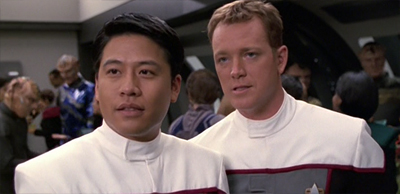
“How come we never got to drive a dune buggy?”
There is also an argument to be made for the scale and spectacle of the Dominion War on Star Trek: Deep Space Nine , especially in big episodes like The Die is Cast , The Way of the Warrior , Sacrifice of Angels or Tears of the Prophets . While those stories were undoubtedly part of a larger and more explicitly humanist story, as best articulated in how the war comes to an end in What You Leave Behind , they still increased the scale of action-driven storytelling within the Star Trek franchise.
However, it was Voyager that really doubled down on the idea of Star Trek as a blockbuster franchise. Under the pen (and later management) of Brannon Braga, Voyager became a home for spectacle-drive storytelling. Janeway went full Ellen Ripley in Macrocosm . The series embraced a bombastic narrative style with epic two-parters like Future’s End, Part I and Future’s End, Part II , Year of Hell, Part I and Year of Hell, Part II and Dark Frontier, Part I and Dark Frontier, Part II . Even standalone episodes like Thirty Days or Juggernaut or Timeless or Dragon’s Teeth seemed designed to showcase impressive (for the time) special effects.
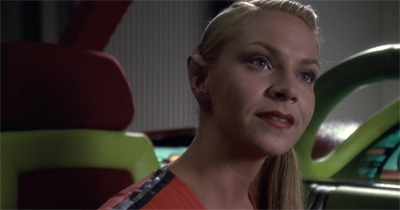
A strong drive to make this sort of episode.
Indeed, special effects supervisor Adam Lebowitz argues that the transition to computer-generated imagery that happened around the third and fourth seasons of Voyager (and the fifth and sixth seasons of Deep Space Nine ) emboldened the production team in terms of what they could actually put on screen:
Actually Voyager started off with both traditional miniature and CG work. Obviously Babylon 5 showed them it could be done, so it just took a few episodes of “all-CG” for them to eventually come around. I think the creature we did in Basics showed them how CG could deliver shots they would never have had the money for using traditional means. It took them a while to get comfortable with it and for the writers to realize they could put more imagination and “scale” in the shows. Honestly, I think Scorpion was the first time they rolled their sleeves up and just decided to have some fun with their new toy! However, the Star Trek: Deep Space Nine episode Sacrifice of Angels was quite literally the turning point in the Star Trek franchise — starting with that episode, the line was drawn in the sand and the visual effects teams were told “no more models.”
This, coupled with the assent of Brannon Braga to the position of showrunner, represented a significant change in the kind of stories that Star Trek could tell. Drive is a story that simply could not exist without this shift.
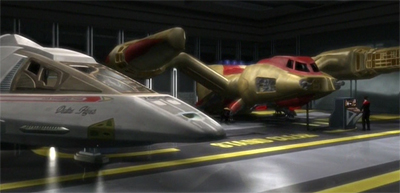
Hanger-in’ around.
Of course, the computer-generated imagery employed by Voyager was cutting edge at the time, but has not always aged especially well. The computer renderings appear a little smooth and simplistic, particularly compared to those employed in blockbuster cinema at the time or even on modern television. This is particularly apparent when used for establishing shots including computer-generated people; Drive includes one such sequence in the ship’s shuttle bay, and Voyager has used this approach for a number of planet-based establishing shots.
Nevertheless, Star Trek has come a long way since a sequence in Elaan of Troyius involving a Klingon warship and the Enterprise required so much postproduction that the second episode of the season to be shot became the twelfth episode of the season to be broadcast. Even in contrast to the model work employed on The Next Generation , advances in computer-generated special effects allow for more flexibility in terms of action beats involving space craft or interstellar phenomenon.
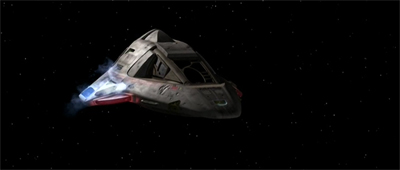
A Flying finish.
Drive is simply an episode that would not have been possible even five years earlier, in terms of delivering a story that requires this many special effects sequences involving this many space craft interacting with one another so dynamically. There is a debate to be had about whether this mode of storytelling represents an ideal for Star Trek , but there is no denying that Voyager has embraced it. Drive is an episode that largely hinges on special effects; on the malleability of the Delta Flyer model and the capacity to arrange (and move) computer-generated models in a variety of interesting ways.
Of course, the basic premise of Drive is absurd. Tom Paris enters the Delta Flyer in what amounts to a deep space race involving four rival powers. The race has become the symbol of a fragile peace between these alien powers. Of course, Drive doesn’t really tell the audience anything about these alien species or the region, or even the history of the tournament. It is really just an excuse to put Tom Paris in a snazzy new flight suit and to tell a decidedly pulpy story that begins with high-intensity deep-space racing and escalates to terrorism and assassination.
In an interview with Cinefantastique , Bryan Fuller explained the origins of Drive as rooted in a decidedly pulpy storytelling tradition:
“Drive was Mike Taylor’s opus. Mike wanted to do Death Race 2000 for quite some time. Finally we sat down and figured out how to do an Olympics-type event. We came up with a goodwill event idea to do this episode.”
Death Race 2000 is the infamous mid-seventies exploitation film produced by Roger Corman, something of a pulpy cult classic.
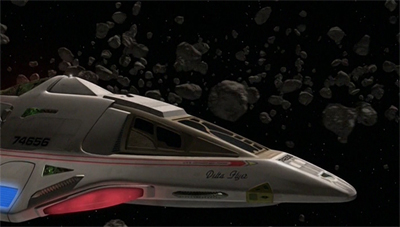
Never too far afield.
This makes a certain amount of sense as a Michael Taylor script. Taylor is perhaps best appreciated for his more cerebral and highbrow contributions to the Star Trek canon, particularly his credits on The Visitor or In the Pale Moonlight . Even on Voyager , Taylor has proven himself capable of elevating the material. Counterpoint is easily one of the best episodes that the series ever produced, and it benefits from taking the series and its characters entirely seriously. Taylor also developed the story for Blink of an Eye .
However, as strange as it is to imagine that Drive came from the same writer as The Visitor , it certainly fits with some of his other storytelling sensibilities. Taylor is a writer with a great deal of affection for pulp, which really shines through in his collaborations with another of the younger writers working on Voyager . Working with Bryan Fuller, Taylor scripted the delightful fifties homage Bride of Chaotica! , the time travel romp Relativity , the gonzo Stephen King homage Alice and the tonally awkward Kes revenge fantasy Fury . It seems fair to observe that Drive is of a piece with those works.
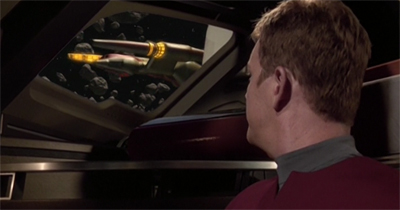
Passing the (Cyia) Batten.
As much as Taylor might be drawing inspiration from a cult seventies grindhouse hit with Drive , the episode also seems to tap into a number of contemporary anxieties. Voyager was always more firmly anchored in its time and place than many critics give it credit for, a reflection of Californian politics during the nineties. The Kazon arc in episodes like Initiations and Alliances tapped into California’s anxieties about race and young gangs. The Chute grappled with the state’s massive prison industrial complex. Displaced reflected the Golden States xenophobic nineties paranoia about immigration.
Drive seems to tap into a contemporary fascination with the idea of street racing. It reflects a lot of contemporaneous news coverage of racing tournaments that would be held in the city, in which young racers would drive enhanced vehicles through abandoned streets, competing for fortune and glory. Obviously, the race in Drive is a bit more above board than these late-night street racers, but the influence of this phenomenon on the script seems quite clear. After all, the race is over a relatively confined geographical area in short-range craft, around an obstacle course including various natural phenomena.
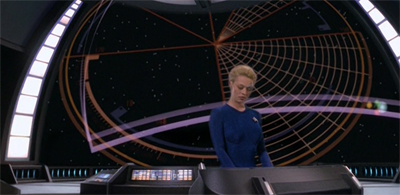
Maps to the stars.
Street racing was something of a national obsession during the nineties, but particularly in Los Angeles. As Sherry Joe Crosby reported in March 1997 :
Mike McNulty’s knees were still trembling from the adrenaline rush. He had just won a 100-mph race on a quarter-mile stretch of De Soto Avenue — and the thrill of victory was intoxicating. “It’s kind of scary, but it’s kind of good when you know you’re winning,” said McNulty, an 18-year-old North Hollywood grocery store clerk who drives a 1989 Mustang GT. Every week across L.A.’s San Fernando Valley, McNulty and other amateur racers gather with their souped-up cars at fast-food parking lots and car washes, where they wager hundreds of dollars and even their car pink slips on speed. The stakes are high — as high as life and death itself.
While these events were obviously dangerous and illegal, they were also exciting. They attracted public speculation and attention.
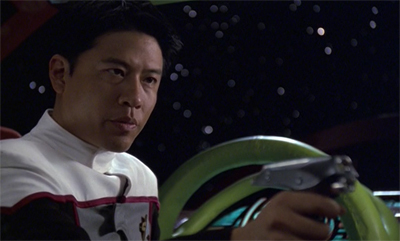
Starting gun.
This interest in street racing would inspire The Fast and the Furious , a low-tier urban western that would eventually develop into a globe-trotting blockbuster mega-franchise. Released in June 2001, seven months after Drive , it could reasonably be argued that The Fast and the Furious was one of the last films of the nineties. It was adapted from a news story in Vibe magazine, looking at New York drag racer Rafael Estevez . Indeed, there were reports of street racing taking place all over the country; Baltimore , Miami , Chicago .
The Fast and the Furious was a portrait of masculinity in crisis, young men in souped-up cars but with nowhere to go. As with race in Drive , the racing in The Fast and the Furious occasionally seemed to exist to buttress a fragile peace between opposing ethnic groups. Even beyond The Fast and the Furious , the idea of street racing was permeating pop culture at the turn of the millennium. One week after the broadcast of Drive , Rockstar Games would release the video game Midnight Club set within the world of urban racing . There was something in the air.
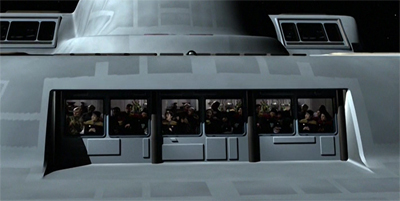
“So… eh… are they coming around again?”
Voyager was very much of its cultural moment, a reflection of the cultural landscape from which it had emerged. Drive seemed to tap into something in the zeitgeist, that turn-of-the-millennium image of young men who were literally going nowhere as fast as their engines could take them. This is itself a potent metaphor for Voyager itself, a show about a crew heading towards a fixed destination, but without any tangible sense of forward momentum. It is perhaps revealing that Paris and Torres don’t actually finish the race in Drive , instead cutting the engines and drifting while they attempt to get their lives in order.
Perhaps this also suggests the key weakness in Drive . Tom Paris has never been the character that Voyager wants him to be. Repeatedly, Voyager has returned to the idea of Tom Paris as a rebel; Caretaker , Ex Post Facto , Investigations , Vis á Vis , Thirty Days . In short, Tom Paris is the kind of character that the series thinks can anchor this millennial story about hot shot young men going around in circles, a rebel looking for his place in the world. However, the issue is that Robert Duncan MacNeill has never convincingly played that version of the character. MacNeill plays Paris as a man indulging his midlife crisis by buying a sports car.
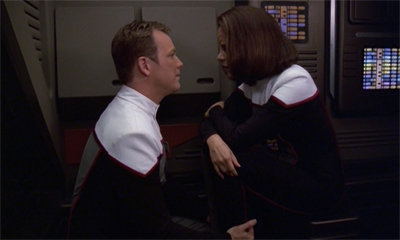
Marriage of inconvenience.
Drive is at its weakest when it tries to tie its pulpy premise to bigger ideas, whether in terms of plot or character. Drive is notable for being the episode where Tom Paris and B’Elanna Torres finally get married. This is only the franchise’s second wedding between credited leads, following You Are Cordially Invited… In fact, this sort of long-form character development is so out of form for Voyager that MacNeill recalled laughing at the idea in an interview with Starlog :
“We were talking about life and making small talk,” the actor remembers. “And I said, ‘So, what’s going on this year?’ They looked at me and said, ‘Well, we’re going to have you and B’Elanna get married. Then she’s going to get pregnant and you’re going to have a baby. And, if we get back home, you’ll be bringing back a baby.’ They spilled all of this out at once and I looked at them and laughed. I didn’t believe them. I really did not believe them. When we started the season, they had the whole journey for the characters in their heads. That has given them some strength, a foundation to work from. So we’re not floundering every episode, as we did for a season or two before that. There was no goal. We were just kind of seeing what would happen, so nothing happened with the relationship.”
The relationship between Paris and Torres has moved largely in fits and starts. It was teased a little bit in third season episodes like The Swarm or Alter Ego , before being articulated in the clumsy and messy Blood Fever . The series then left the couple in limbo until Day of Honour forced the issue, confirming that they were in a loving and stable relationship in Scientific Method . Since then, the pair have been a fixture of Voyager , but with no real sense of momentum.
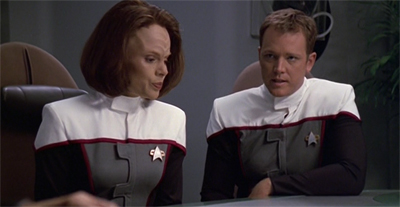
Pilot scheme.
In many ways, Paris and Torres encapsulate one of the big issues with Voyager , the sense that show is never actually moving forwards. The ship is stranded on the other side of the galaxy, potentially a lifetime away from contact with friends and families. Ignoring plot contrivances and the expectation of a seven-season run of a Berman-era Star Trek series, there is no reason that any of the characters should ever expect to see home again. As such, these characters should be preparing to live the rest of their lives on the ship.
In theory, that means tough questions for the crew of Voyager. These people are no longer just crew mates assembled by chance, they are all effectively life partners to one another. They are neighbours. They are not a military or scientific vessel, they are a floating city. Characters should be entering relationships with one another, starting families together, sharing spaces. Paris and Torres should be just one example of this, one illustration of how the crew are adapting to the idea of a seventy- (or even just thirty-) year journey together.
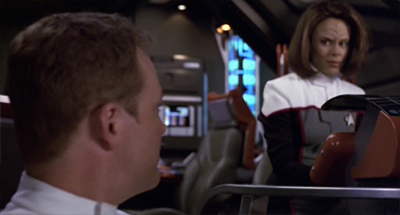
An engin(eer)ious solution.
However, Paris and Torres seem stuck in place. They are in a relationship together, but there’s no real sense of the two of them growing closer together or making long-term plans with one another. It is suggested that the two characters still live in separate quarters, based on episodes like Juggernaut or Memorial . There’s never been a sense of the pair thinking about become more than just a conventional and generic couple. None of the modern sexual ambiguities of Mulder and Scully on The X-Files , nor any moves towards becoming a more traditional family unit.
Course: Oblivion famously opened with the wedding of Torres and Paris, in one of the most pointed and deliberate fake-outs across Voyager ‘s seven-season run. That teaser sequence seemed to hint to the audience that something was wrong . Naturally, it was all an elaborate misdirection; these weren’t the real Torres and Paris. It played almost as a critique of Voyager , suggesting that the only way that these characters could actually grow was if the production team promised to reset everything at the end of the episode by revealing them as clones and blowing them all up.
It is very revealing that Voyager waited until the start of the final season to allow Paris and Torres to get married. It perhaps speaks to the show’s inherent conservatism that the pair had to get married before they moved in with one another. Indeed, as Dawson explained to TV Zone , the marriage was arguably necessary as a stepping stone to the story about Torres’ pregnancy:
“All this is just the tip of the iceberg for Tom and B’Elanna,” says Roxann Dawson, who plays the half-human, half-Klingon Torres. “There’s still the actual birth of their child to look forward to and all that follows. I feel it was important for them to finally make a commitment. This was also necessary if they [the show’s producers] were going to follow through with the pregnancy storyline. I mean, Tom and B’Elanna had to be married beforehand, otherwise what kind of message would we be sending to our viewing audience?”
To be fair to Voyager , Deep Space Nine also made sure that its major characters were married before having children. Dax and Worf got married in You Are Cordially Invited… before announcing plans to have a child together in Tears of the Prophets . Sisko and Yates got married in ‘Til Death Do Us Part shortly before Yates discovered that she was pregnant in The Dogs of War .
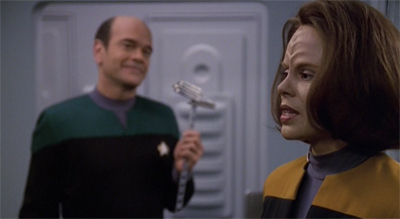
Join the club.
Torres would become pregnant in Lineage , but the seventh season of Voyager would be structured in such a way that she would only give birth in Endgame . She was delivered at the last possible minute, as Voyager was in the transwarp conduit that would deliver it to Earth. As such, Voyager never had to explore any of the potentially interesting ideas about what it meant for Torres and Paris to form a family in the deepest reaches of the Delta Quadrant. It was a very cynical move, but one entirely in keeping with how Voyager approaches long-form characterisation.
As such, Drive is unconvincing in its efforts to explore the relationship between Paris and Torres. The early acts of the episode are interesting, when Paris completely forgets about an important date with Torres in order to focus on his obsession of the moment. It initially appears like Drive is cannily avoiding melodrama, refusing to portray Torres as emotional or hysterical or aggressive in how she responds to the news. She is clearly disappointed, but she is also understanding. “It’s all right,” she tells him. “The holodeck will always be here. This race won’t.”
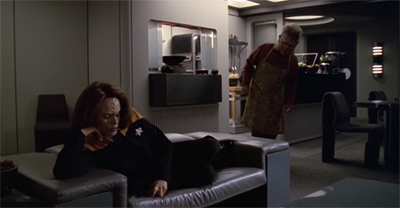
“You know, I found that whenever my relationship was in trouble, I’d just become bullying and controlling. It was a lot easier when I was dating a two-year-old.”
It’s a very even-handed and mature response. It’s a considered compromise from Torres. She is hurt by the fact that Paris forgot, and doesn’t try especially hard to hide it. However, she also cares enough about her partner to understand that this is important to him and that he should have the opportunity to do something that matters. This is a very grown-up approach to interpersonal relationships, one that suggests the sort of work and consideration that is necessary for two people to be together; the push-and-pull between individual wants and desires, and a partner’s understanding of those factors.
Unfortunately, Drive very quickly undercuts this clever characterisation and veers directly into heightened melodrama. Torres visits Neelix in the messhall and confesses her frustrations and anxieties. “He just entered this big race, and he’s really excited and, I don’t want to spoil it for him,” Torres explains to Neelix. When Neelix points out that Paris would drop it all if Torres asked him to, she agrees, “Probably. But he should be able to do what makes him happy.” She understands that just because he would drop it all doesn’t mean that he should drop it all.
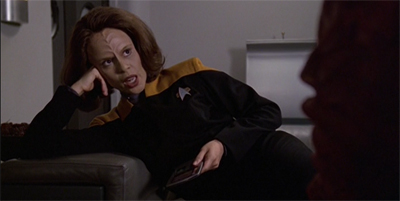
The good (relation)ship Voyager.
However, then the episode drops the romantic subplot atomic bomb. “It’s time I faced facts, Neelix. Tom and I just don’t belong together,” Torres states. “There’s a Klingon phrase my grandmother used to use. Mok’tah. It means bad match. That’s what Tom and I are. I just hate that it’s taken me three years to realise it.” All of a sudden, the episode dramatically reverses the dynamic of those earlier compromises. Suddenly, Torres is no longer a loving partner who cares enough about her partner to give up their time together for him.
With that reflection, Torres is suddenly considering dumping her long-term partner without actually talking to him about the issues that she sees in their relationship. In the space of a handful of lines with Neelix, the relationship between Paris and Torres transforms from a nuanced depiction of a grown-up relationship to a heightened melodrama about people who refuse to clearly communicate with one another. It also serves to generate stakes for the episode, asking the audience to wonder whether the relationship between Torres and Paris could possibly survive the episode.
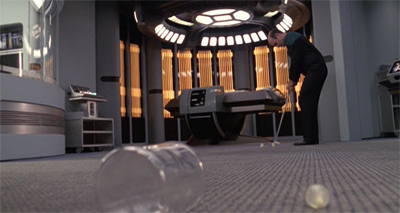
Putting the work in.
Ignoring how contrived and mean-spirited that set-up feels, it is also disingenuous. Part of the issue is that the audience hasn’t really spent enough time with Paris and Torres as a couple to properly assess what they mean to one another. Following Day of Honour , there are very few stories about Paris and Torres as a couple. Across the three seasons that the couple have been dating, they tended to have individually-focused stories in which the other only plays a small supporting role. Paris was a small part of Nothing Human or Barge of the Dead . Torres barely registered in episodes like Gravity .
Once the characters on Deep Space Nine started pairing off, it was customary to dedicated episodic subplots to their adventures. Sisko frets over Yates moving to the station in Indiscretion , and worries about her being a Maquis spy in For the Cause . Dax and Worf go to Risa together in Let He Who Is Without Sin… , babysit together in Time’s Orphan , take an undercover mission together in Change of Heart . Even Rom and Leeta go through their ups and downs, with Rom worrying about Leeta taking advantage of him in Ferengi Love Songs and finally getting married in Call to Arms . There are few similar Paris and Torres plots.
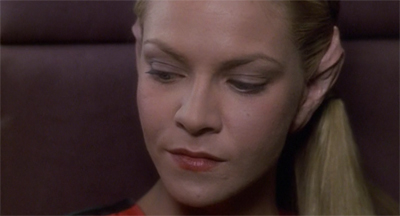
A disgrace to the race.
Even accepting these stakes as presented, the audience likely understands that Voyager is unlikely to break-up Torres and Paris. Ironically, that would represent a much bigger change to the status quo than having them get married. Instead of just interacting as they have for the past three seasons, every scene between the two characters would have to be laced with subtext, and the audience would expect Voyager to put them back together in time for the series finale. Breaking up Torres and Paris would actually be more work for Voyager than keeping them together, so it is unlikely to happen.
Similarly, the episode doesn’t even commit to the idea of the relationship between Paris and Torres. Their marriage is practically an afterthought. There is no opportunity to show the ceremony, with the episode closing as the couple embark on their honeymoon in the Delta Flyer. It all feels very perfunctory, to the point that Paris and Torres are both wearing their uniforms while on honeymoon together, implying that they went home from the ceremony, changed out of their clothes (or dress uniforms) and got back into their work clothes before running away for some time together.
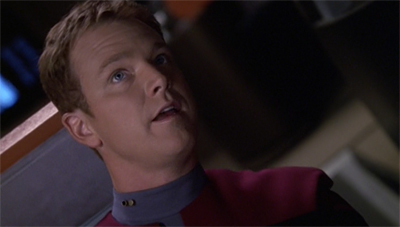
Tilting at windmills.
In her interview with TV Zone , Dawson defended the decision not to show (or focus on) the wedding as the ceremony had already been shown in Course: Oblivion :
“I thought Drive was good. Some people complained they didn’t get to see the actual wedding but I don’t think you really needed to. It would’ve taken valuable time away from what actually brought Tom and B’Elanna to the altar. Also, we’ve seen them get married before in another episode [Course: Oblivion] where we witnessed the entire ceremony in all its details. Of course, it was an alternate reality, but it was still the same characters. It would have been unfair for the longtime viewers to have to sit through it all over again.”
This is a cop-out of an answer. It doesn’t explain how what should be a life-altering decision for the characters is thrown into the final act of an episode about a high-stakes space race.
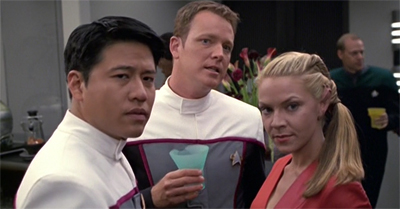
The ten-minute engagement.
The speed at which Torres and Paris get married hints at how frustrating the relationship can be. Torres and Paris do not get married because it is the next logical step in their relationship, or because they’ve given it a lot of thought and consideration. They get married because they have a desperate conversation when Torres attempts to dump Paris, which is interrupted by a major crisis. Torres jokes at one point, “I thought you only asked it because we were about to explode.” It is a sly aside, but it creates the sense that the speed of the wedding is not motivated by love, but in response to a perceived crisis.
This is not a particularly healthy approach to matrimony. There is a reason why engagements can last a long time in real life, as couples get used to living with one another and accept the reality of their relationship before making what should be a long-term commitment. On Deep Space Nine , outside of episodes like The Muse , the regular characters all broach the prospect of marriage an episode or two before the ceremony itself. Dax promises to marry Worf in Call to Arms , while Sisko first suggests marriage to Yates in Penumbra . All of these feel much more organic than the marriage of Paris and Torres in Drive .
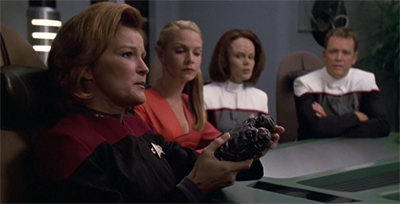
Piecing it all together.
Similarly, Drive struggles a little bit with the heightened stakes that Taylor tries to bake into the episode. Nominally, Drive is an episode about Paris competing in a race. Those stakes should be enough to sustain an episode. Deep Space Nine has anchored entire episodes in the idea of the cast goofing around together without the need for some massive external threat to motivate them. Take Me Out to the Holosuite was an episode where there was nothing more at stake than Sisko’s pride. Badda-Bing, Badda-Bang did put Vic Fontaine in danger, but never threatened the station or a regular cast member.
Even Voyager has occasionally offered these sorts of low-stakes stories, such as Seven’s flirtation with romance in Someone to Watch Over Me . Unfortunately, these sorts of stories are the exception rather than the rule. Drive sets up these its nominally low stakes in the early scenes between Paris and Janeway. “Now that we’re in this race, we’re in it to win,” Janeway assures Paris. “After all, Starfleet’s honour is at stake.” It’s undoubtedly goofy, but there is nothing wrong with goofy. There should be an episode in this.
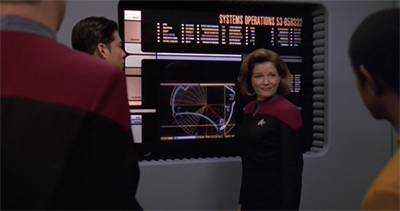
A strong course of action.
However, Drive has already begun adding weight to what should be a simple race. The race is not just a race, it is a profound philosophical statement. “Captain, this race is more than just a sporting event,” Paris tells Janeway. “Until recently this region was a war zone. Four different species fought for nearly a century to control it.” Kim continues, “Now, for the first time, they’re competing peacefully to commemorate the new treaty that ended the war.” This adds a lot of weight to the goofy premise. Then again, there is precedent for sporting events to anchor lasting peace, at least in popular narratives of history .
Interestingly enough, Drive marks a strange point of strong engagement by the seventh season of Voyager in the utopian ideals of Star Trek . Since Jeri Taylor took over during the third season, Voyager has consciously defined itself as a particularly archetypal sort of Star Trek series, with generic Star Trek plots that could easily have been told on The Next Generation . However, the seventh season of Voyager seems particularly engaged with idea of Star Trek as a utopian presentation of the future. In fact, the seventh season repeatedly and consciously evokes the romantic ideal of the Federation.
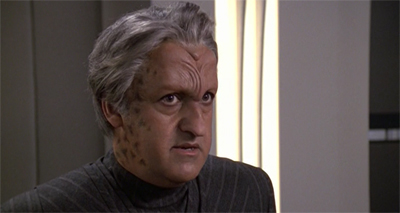
Richard Bashir’s attempt to escape prosecution is going remarkably well.
In Drive , Paris tells Janeway, “This race embodies everything the Federation values. Peaceful coexistence, free exchange of ideas…” Sure, Paris is just trying to get Janeway to sign off on his participation, but there’s just enough sincerity beneath the surface. There’s a sense that Drive believes completely and unironically in what the Federation stands for, in a way that bubbles through the rest of the seventh season as a whole. It isn’t especially subtle, it is explicitly baked into the premise of several of these stories.
The Void finds Janeway establishing a miniature Delta Quadrant alliance, musing at the end of the episode, “It was almost like being part of a Federation again.” (She cites “the Federation Charter” as a major influence in founding the alliance in the episode.) Natural Law is the kind of old-school “Prime Directive” episode that dates back to the earliest episodes of The Next Generation , evoking “General Order Number One” in a manner that evokes Justice or Pen Pals or Who Watches the Watchers? It is represents a sort of an escalation of the “archetypal Star Trek” vibe that Voyager has been cultivating since its third season.
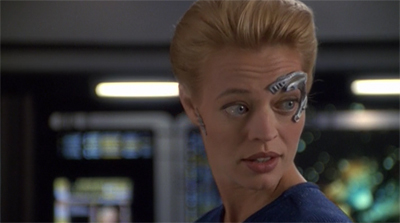
Perhaps the best example of this is Friendship One , which offers both a literal and metaphorical connection back to the Federation. In literal terms, the episode finds Voyager asked to recover an old Starfleet probe sent to a distant world. In metaphorical terms, Friendship One exists largely as a morality tale that justifies the existence of the Prime Directive. More than that, Friendship One exists as a companion piece to One Small Step , as an example of Voyager excavating the internal history of the Star Trek universe.
This actually works reasonably well in thematic terms, as the ship and crew get close to home. After all, Voyager has always been a nostalgic show about looking backwards rather than pushing outwards. It makes sense that Voyager would feel an intensifying connection to the Federation (and to the nostalgic archetypal utopian Star Trek ideal that it represents) as it enters the home stretch. Of course, these engagements are largely superficial and generic, often directly invoking the connection between the Federation and the franchise’s utopianism rather than interrogating it as Deep Space Nine did.
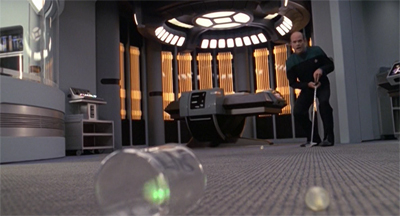
The golf between these societies is huge.
Friendship One would also suggest another possible explanation for this powerful nostalgia for the Federation running through the seventh season of Voyager , the looming arrival of Star Trek: Enterprise . The fifth live action Star Trek series was only a year away, with Brannon Braga having moved away from Voyager to focus on building up a writers’ room for Enterprise . There was considerable buzz and excitement around the franchise’s first prequel, and there are aspects of the final season of Voyager that seem to be consciously playing into that; establishing the importance of the Federation before jumping back to its origin.
At the same time, this emphasis on the race as a sort of a proto-Federation for the region provides the necessary stakes for the episode, when Irina’s ship malfunctions and her co-pilot is incapacitated. Tuvok discovers evidence of foul play. “This may be more than a simple case of cheating, Captain,” Ambassador O’Zaal suggests. “I think someone’s trying to end the peace.” O’Zaal’s suspicions prove correct, when it is revealed that Irina is planning a terrorist strike at the finish line, turning the Delta Flyer into a suicide bomb.
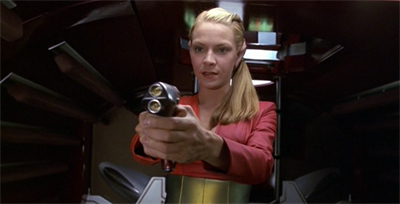
Trying to start a race war.
The episode keeps Irina’s motivations suitably vague and ominous, although they are framed in opposition to the broad liberal humanism associated with the Federation and the race itself. “Not everyone is as comfortable mixing with other species as you are, Harry,” Irina remarks to Kim. “Some of us believe it was better when we were separate.” There is no larger context provided, no greater motivation. There is simply a vague philosophical statement there, with no real explanation of why Irina believes what she believes, and what drove her to this point.
It is very superficial, underscoring how shallow this whole plot point is. There is no need for the terrorism or the attempted bombing. They just exist to escalate the stakes beyond the race itself. This is a shame. There is something to be said for watching characters enjoy themselves, even when there are no lives at immediate risk. Voyager is entering its final season, and the show should trust its cast enough to carry something light and enjoyable on its own terms. Then again, it took Deep Space Nine several years to grow confident enough to embrace this mode of storytelling, and Voyager has never been Deep Space Nine .
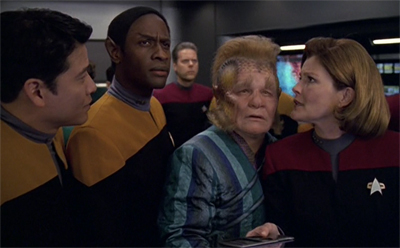
“You might very well think that, but I couldn’t possibly commentate.”
Still, allowing for these sizable flaws with the episode, there is a lot to enjoy about Drive . The episode seems quite aware of its own ridiculousness. Although a lot of the jokes are broad and hokey, there is something incredibly appealing in Neelix’s enthusiastic “race updates” and the way that Tuvok’s initial disinterest in the race gradually morphs into eager interest. Even if the emotional pay-off of the episode feels unearned, there is something nice about watching Torres and Paris spend time together, Torres doing something that Paris loves. A few more episodes like this might have sold the marriage.
More than that, there’s a cheekiness in some of the writing, particularly the knowing and winking way that Drive never tries that hard to conceal its antagonist. Asaan exists as a possible red herring early in the script, but he disappears quite quickly from the narrative once he has denied the sabotage of Irina’s vessel. Indeed, the script rather knowingly tips its hand when Kim falls for Irina. On discovering Kim has found his way on to her team, Paris quips, “I was just going to congratulate you. She’s not a Borg, she’s not a hologram, and she’s not dead. Looks like you might have finally found yourself the perfect woman.”
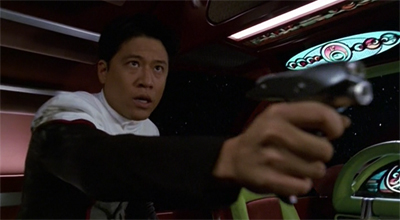
“To be fair, this still ended better than my last three alien hook-ups.”
That line all but confirms that Irina will turn out to be the villain of the piece, by acknowledging that it is actually impossible for Kim’s romances to end in anything other than brutal disappointment. After all, Kim has endured Favourite Son , The Disease , Ashes to Ashes . To be honest, it might be best that he got this bad romance out of the way so early in the final season. The line demonstrates a canny self-awareness that was often lacking from Voyager , and demonstrates that the writers have been paying enough attention to pick up on their own storytelling crutches.
Of course, the reveal is still somewhat forced and Irina is still under-developed, but that little knowing acknowledgement suggests that the episode is at least in on the joke. That is perhaps the best thing that can be said about Drive . The episode is a mess, and one that suffers when it tries to engage with anything approaching a big idea, but it also has an infectious energy and playfulness that carries it much further along than the basic premise arguably merits. Drive is hardly an exceptional episode of television, but it occasionally feels fun.
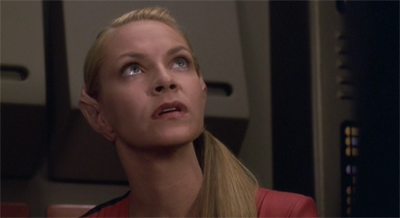
Approaching the race with such Ziy(a)l.
The just about gets it across the finish line.
Share this:
Filed under: Voyager | Tagged: drag racing , Drive , racing , star trek: voyager , street racing , the fast and the furious , voyager |
8 Responses
They knew they could never top the Worf-Jadzia wedding. So they didn’t even try.
And you could say that it was a foregone conclusion, that a series produced as a quick-and-dirty cash-in on TNG, wouldn’t try very hard.
You can see the same thing happening on the CW, with regard to the superhero craze.
I remember that “You Are Cordially Invited” wasn’t that great of an episode though.
I don’t mind it too much. I think it works well as a pallet cleanser, and it showcases Moore as a comedic writer. And there are lots of little touches that I love. (Individual scenes, mostly; Worf and Martok discussing Klingon multiculturalism, for example.)
I don’t know. I feel like Piller wanted to try hard to do something new with Voyager in the first two years. Well, the first half of the first year and then the second year. He just made such a gigantic clustef&%k of it and received no moral support for his writing staff. And I’m also sympathetic to Taylor over-correcting in the opposite direction as a response to that.
A rather useless episode, if it were not for the interesting look into the relationship dynamic of Tom and B’Elanna. I somehow found it very realistic, and could very well identify with it. Especially Tom stopping the Flyer out of a feeling of both childish anger and the wish to talk.
I didn’t dislike this as much as I thought I would on rewatch. It’s light and kinda empty, but at least it’s odd in a way that Voyager rarely allowed itself to be, particularly at this stage of its lifecycle.
We have almost nothing invested in the Torres/Paris relationship, so I can remember shrugging with little interest that they might break up. But we know this isn’t going to happen as soon as Voyager devotes whole scenes to a discussion of their relationship. Voyager would never do this with a break-up as an end point. That would not please Berman, and would require further writing, as you point out.
You’ve noted in a prior review that Biller worked on 90210, and I do wonder if that gave him an added willingness to let Torres and Paris marry and reproduce.
I remember seeing this when it aired and immediately seeing it as a rip-off or homage to Star Wars: Phantom Menace. The alien vessel looks very much like a pod racer from that film, which had come out very recently in 1999. I remain quite convinced that it influenced this episode a lot.
Poor Harry. One of the few times Voyager is willing to acknowledge continuity is to mock his terrible attempts at finding love.
Leave a comment Cancel reply
This site uses Akismet to reduce spam. Learn how your comment data is processed .
Recent Posts
- 378. Gojira Mainasu Wan (Godzilla Minus One) (#—)
- 377. I’ll Always Know What You Did Last Summer (#—)
- 376. Wall-E – Ani-May 2024 (#59)
- Doctor Who: The Devil’s Chord (Review)
- Doctor Who: Space Babies (Review)
Recently tweeted…
- "I Simply Am Not There": The Existential Horror of Eighties Excess in "American Psycho"...
- Doctor Who: Pyramids of Mars (Review)
- Doctor Who: The Devil's Chord (Review)
- Crime and Pun-ishment: The Art of the CSI One-Liner
Available at…

Blogs Well Worth Your Time
- 1001 Must See Films
- Andrew at the Movies
- Anomalous Material
- Cut the Crap Movie Reviews
- Encore Entertainment
- Fandango Groovers
- FlixChatter
- Four of Them
- It Rains… You get Wet…
- Jameson Cult Film Blog
- Jar Watches Films
- Let's Go To The Movies
- M. Carter at the Movies
- Marshall and the Movies
- Movie News First
- Musings from a Man Lost in La Mancha
- Never Mind Pop Film
- Paragraph Film Reviews
- Roger Ebert's Journal
- Ross v. Ross
- Scannain.com
- Screenwriter (Donald Clarke, Irish Times)
- Strange Culture
- The Film Cynics
- The Pompous Film Snob
- The Projection Booth
- Things That Don't Suck
- Too Busy Thinking About My Comics
- Undy a Hundy
Film Nerd Resources
- CinemaBlend (News)
- Internet Movie Database
- Rope of Silicon
- The Guardian Film Blog
- James Berardinelli
- Roger Ebert
Email Subscription
Enter your email address to follow this blog and receive notifications of new posts by email.
Email Address:
Sign me up!
Blog at WordPress.com. WP Designer.
- Already have a WordPress.com account? Log in now.
- Subscribe Subscribed
- Copy shortlink
- Report this content
- View post in Reader
- Manage subscriptions
- Collapse this bar
Drive (Star Trek: Voyager)
" Drive " is the 149th episode of Star Trek: Voyager , and the third episode of its seventh season . The Voyager crew participates in a space race, but not all is as it seems to be. Meanwhile, B'Elanna and Tom Paris work on their relationship.
Home media releases
External links.
This science fiction television show episode was written by Michael Taylor and directed by Winrich Kolbe. [1]
This episode includes scenes with the fictional spacecraft, the Delta Flyer . [2]
Tom Paris and Harry Kim are out taking the new Delta Flyer , rebuilt after the destruction of the first, for a spin through an asteroid field when they are challenged to a drag race by a pilot named Irina in another craft. As they race, they detect a gas leak on board her shuttle. They beam her to safety and bring her craft back to Voyager for repairs.
Irina tells them that she's training with her craft for an important race. Interested, Paris and Kim persuade Captain Janeway to let them enter the Delta Flyer into the race. Janeway agrees because the race is a milestone of peace between four warring cultures who have finally come together to end their strife.
B'Elanna Torres is disappointed that Paris will be racing; she had put serious effort into planning some time off for the two to spend together, and in his excitement over the race, Tom forgets about their plans. He apologizes to her and she claims it is no problem but is inwardly depressed. She even begins to have doubts about their relationship. She confides in Neelix , who convinces her to be patient with Tom, since she really does love him. Seven of Nine suggests that B'Elanna take up some of Tom's hobbies and interests so that they might spend more time together. That thought gives B'Elanna an idea.
On the day of the race, Tom is surprised to find that B'Elanna has taken Harry's place as his co-pilot. She promises to do her best to help the Flyer to victory. As the race nears its end something goes wrong in one of the other shuttles. It's Irina's ship. Her co-pilot has been injured in a console explosion when their shield generators overloaded in an act of sabotage. The rest of the race is cancelled for the day and as Harry helps Irina with her shuttle, she invites him to be her new co-pilot.
Seeing romance sparking between Harry and Irina, B'Elanna has more feelings of doubt about Tom's dedication to their relationship. As the race starts up again, she tries to put her pensive feelings aside and concentrate on winning, but she is not able to hide her distress. She and Tom begin to argue and he insists she tell him what is wrong. Frustrated, he stops the Flyer right in the middle of the race and declares they will not move until they resolve their problem.
At the same time, Harry discovers more damage on board Irina's ship, and that she caused it herself. She pulls a weapon on him but he gets it away from her and holds her safely at bay. Irina is bent on sabotaging the peace agreement between the four cultures involved in the race, and she has turned her own ship into a terrorist bomb. To make things worse, she has planted a bomb on board the Delta Flyer as well. Still holding her at phaserpoint, Harry sends Tom a message to inform him of the danger.
Tom and B'Elanna receive the message just as he makes his devotion to her a bit clearer by proposing marriage. They speed the Flyer into a nearby nebula and eject the sabotaged warp core where it explodes a safe distance from the racers and spectators. Irina is taken into custody.
The next mission of the Delta Flyer is shown to be Tom and B'Elanna's honeymoon .
Keith R.A. DeCandido writing for Reactor in 2021 noted the following items for continuity: [3]
- The Delta Flyer was rebuilt following its destruction in " Unimatrix Zero ."
- Torres mentions that Paris was expelled from Starfleet Academy , but he was not; Paris graduated and served in Starfleet as a junior officer before being involved in an event that resulted in the death of others. The actor Robert Duncan McNeill previously portrayed Nicholas Locarno in The Next Generation episode " The First Duty " in which Locarno was expelled after accepting responsibility for the death of a fellow cadet.
- Paris' and Torres' marriage would be the fifth of Star Trek regular characters to-date, following the O’Brien-Ishikawa wedding in The Next Generation's " Data’s Day ," Lwaxana-Odo in Deep Space Nine's " The Muse ," Dax-Worf in " You Are Cordially Invited ," and Sisko-Yates in "' ‘Til Death Do Us Part ." The next one would be Riker-Troi in Star Trek: Nemesis .
- Three Deep Space Nine guest stars appear in this episode: Brian George who played Richard Bashir in " Doctor Bashir, I Presume? "; Patrick Kilpatrick who played Reese in " The Siege of AR-558 ," and Razik in " Initiations "; and Cyia Batten who played Tora Ziyal in " Indiscretion " and " Return to Grace ". Batten would next appear in the Star Trek: Enterprise episode " Bound " as Navaar.
In 2001, Digital Spy noted that this episode focuses on the relationship between Tom and B'Elanna, and also involves a race in space. [4]
In 2017, Comic Book Resources ranked Tom and B'Elanna the sixth best romantic relationship of the Star Trek franchise. [2]
In 2021, SyFy said this a was Tom Paris-centric episode, and praised it for exploring the rockier side of relationships as it delves into the Tom-B'Elanna romance. [5] Keith R.A. DeCandido writing for Reactor said that the episode is "fine" because the idea of sports instead of war "is a good one" and a perfect role for Voyager was as a "neutral party (and provider of medical help)," noting it is what Voyager should've been doing more often (e.g., at the station near the Nekrit Expanse in " Fair Trade ", and the Markonian Outpost in " Survival Instinct "). However, he was critical of several other things, including Torres' line, "I kind of like the sound of Tom Torres" stating that in the "24th century" it was "absurd" to even be arguing whether the woman would take the last name of the man since even now in the real-world, the tradition "has been increasingly less common for the past fifty years or so." He summed up by saying that it was "a good premise...decently executed." [6]
On December 21, 2003, this episode was released on DVD as part of a Season 7 boxset; Star Trek Voyager: Complete Seventh Season . [7]

Related Research Articles
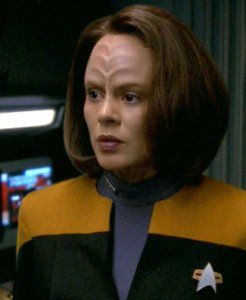
B'Elanna Torres is a main character in Star Trek: Voyager played by Roxann Dawson. She is portrayed as a half-human half-Klingon born in 2346 on the Federation colony Kessik IV.

Kes is a fictional character played by Jennifer Lien on the American science fiction television show Star Trek: Voyager . The series follows the crew of the starship USS Voyager , stranded far from home and struggling to get back to Earth. Kes joins the crew in the pilot episode "Caretaker", opening a hydroponics garden and working as the medical assistant to the artificial intelligence known as the Doctor. She is a member of a telepathic alien species known as the Ocampa who have latent psychic abilities and a life span of only nine years. Her storylines focus on encouraging the Doctor to develop his humanity and dealing with her Talaxian boyfriend Neelix's jealousy. She also seeks to expand upon her mental capabilities, leaving in the fourth season after her powers threaten to destroy the ship. She reappears in a season six episode and features in Star Trek: Voyager novels and short stories .
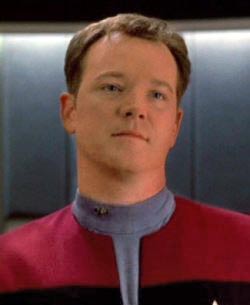
Lieutenant Thomas Eugene "Tom" Paris is a fictional character in the American science fiction television series Star Trek: Voyager and is portrayed by Robert Duncan McNeill. Paris is the chief helmsman, as well as a temporary auxiliary medic, of the USS Voyager , a Starfleet ship that was stranded in the Delta Quadrant by an alien entity known as the Caretaker.
" Revulsion " is the 73rd episode of Star Trek: Voyager , the fifth episode of the fourth season. This is focused on an EMH -like hologram on another ship, which is dealt with mostly by the Doctor and B'Elanna. In addition, sub-plots run their course on Voyager with other characters. Guest star Leland Orser plays the hologram, Dejaren on a spaceship that is encountered by Voyager. Leland Orser had also played a character on Deep Space Nine.
" Faces " is an episode of the American science fiction television series Star Trek: Voyager . Set in the 24th century, the series follows the adventures of the Starfleet and Maquis crew of the starship USS Voyager after they are stranded in the Delta Quadrant, far from the rest of the Federation. The 14th episode of the first season, first broadcast by UPN on May 8, 1995, "Faces", was developed from a story by Jonathan Glassner and Kenneth Biller. Biller also wrote the teleplay, which was directed by Winrich Kolbe.

" Basics " comprises the 42nd and 43rd episodes of the American science fiction television Star Trek: Voyager , the cliffhanger between the second season and the third season.
" Lineage " is the 158th episode of the TV series Star Trek: Voyager , the 12th episode of the seventh season. B'Elanna and Tom Paris struggle through the pregnancy of their child.
" Real Life " is the 64th episode of Star Trek: Voyager and the 22nd episode of the third season. This episode revolves around the Doctor dealing with his holographic family program. Robert Picardo plays a holographic AI aboard the starship USS Voyager in the 24th century.
" Prototype " is the 29th episode of science fiction television series Star Trek: Voyager , and the 13th episode in the second season. It was written by Nicholas Corea and directed by Jonathan Frakes. This episode was broadcast on UPN Network on January 15, 1996. In this episode, the crew of spaceship making their way back to Earth have an encounter with a race of warring robotic life forms.
" Blood Fever " is the 58th episode of Star Trek: Voyager , the 16th episode of the third season. This episode focuses on life aboard the Federation spacecraft USS Voyager , stranded on the opposite side of the galaxy as Earth. Even with its fictional faster than light warp drive, it will take decades to return normally. This show focuses on the characters B'Elanna Torres, Ensign Vorik and Tom Paris, and explores the nature of the Vulcans.
" Dreadnought " is the 33rd episode of Star Trek: Voyager , the 17th episode in the second season. The USS Voyager encounters a Cardassian weapon that is en route to destroy an innocent civilization in the Delta Qudarant due to sabotage by Chief Engineer B'Elanna during her time as a member of the Maquis. The episode aired on UPN on February 12, 1996.
" Muse " is the 142nd episode of Star Trek: Voyager , the 22nd episode of the sixth season.
" Coda " is the 57th episode of Star Trek: Voyager , the 15th episode of the third season. This science fiction television show episode focuses on the characters Janeway and Chakotay of the Federation spacecraft USS Voyager . In the 24th century, a spaceship Captain and first officer are traveling by shuttlecraft back to USS Voyager when they have an incident.
" Day of Honor " is the 71st episode of Star Trek: Voyager , the third episode of the fourth season. Roxann Dawson stars as B'Elanna Torres, chief engineer of the Starfleet spaceship USS Voyager. On a spaceship stranded on the other side of the galaxy, trying to make its way back to Earth the crew tries to make sense of their professional and personal lives.
" Scientific Method " is the 75th episode of Star Trek: Voyager , the seventh episode of the fourth season.
" Hunters " is the 83rd episode of the science fiction television series Star Trek: Voyager , the 15th episode of the fourth season, and the first episode of the Hirogen story arc. The series is about a spaceship returning to Earth, after being flung to the other side of the Galaxy, and is set in the 24th century of the Star Trek science fiction universe.
" Extreme Risk " is the 97th episode of the science fiction television series Star Trek: Voyager , the third episode of the fifth season. It is set on the starship U.S.S. Voyager traveling back to Earth from the other side of the Galaxy.
" Dark Frontier " is a feature length episode of Star Trek: Voyager , the 15th and 16th episodes of the fifth season. This episode originally aired as a feature-length episode that was later broken up into two parts for reruns in syndication. Actress Susanna Thompson guest stars alongside the cast of this Star Trek television show as the Borg queen. The crew of a spacecraft trying to get back to Earth once again encounter a race of cybernetic organisms bent on Galactic domination. Ex-Borg character Seven of Nine struggles with her past as she rediscovers her humanity aboard the spacecraft.
" Alice " is the 125th episode of the science fiction television series Star Trek: Voyager , the fifth episode of the sixth season. In the 24th century, USS Voyager helmsman Tom Paris takes on a salvaged spacecraft. However, the time he is spending on this hobby creates issues with his girlfriend B'Elanna Torres. There turns out to be something wrong with the spacecraft.
" One Small Step " is the 128th episode of the television series Star Trek: Voyager , the eighth episode of the sixth season. A 24th century spacecraft, the USS Voyager, encounters a 21st century Mars spacecraft in an anomaly.
- 1 2 "Space Ships: The 15 Best Cases Of Star Trek Shipping" . CBR . 2017-02-17 . Retrieved 2019-07-09 .
- ↑ DeCandido, Keith R.A. (5 August 2021). "Star Trek: Voyager Rewatch: "Drive" " . Reactor Magazine .
- ↑ Wilkes, Neil (2001-03-05). "Star Trek: Voyager - Drive" . Digital Spy . Retrieved 2019-07-09 .
- ↑ Krishna, Swapna (2017-11-10). "A Star Trek: Voyager episode guide for B'Elanna Torres" . SYFY WIRE . Archived from the original on 2017-11-14 . Retrieved 2021-03-27 .
- ↑ "DVD Talk // Star Trek Voyager: Complete Seventh Season // Paramount // Unrated // December 21, 2004" . www.dvdtalk.com . Archived from the original on 2010-10-10 . Retrieved 2021-02-25 .
- Drive at Memory Alpha
- "Drive" at Wayback Machine (archived from the original at StarTrek.com)
Star Trek: Voyager's Coaxial Drive, Explained

Your changes have been saved
Email Is sent
Please verify your email address.
You’ve reached your account maximum for followed topics.
Star Trek: Is Voyager More Advanced Than The Enterprise?
A popular mcu villain is finally returning to the screen (in an unexpected way), scream 7: should the horror sequel copy scream 3.
- The Coaxial Drive is a groundbreaking technology in interstellar travel, defying conventional limitations of space-time and opening new possibilities for galactic exploration.
- The Coaxial Drive manipulates a standard warp field to fold space, generating immense power that surpasses traditional Warp Drives. However, it also poses risks, such as severe structural damage and discomfort among the crew.
- Coaxial Warp Drives remain experimental and restricted within Starfleet due to their instability. Measures like polaric modulators and symmetric warp fields are used to mitigate risks, but these systems are not without their own vulnerabilities.
The Coaxial Drive, also known as Coaxial Induction Drive or Coaxial Warp Drive, stands as a groundbreaking technology within the realm of interstellar travel. This piece of Star Trek technology defies the conventional limitations of space-time. Its existence was once relegated to the annals of theoretical astrophysics. However, it became a tangible reality in the year 2374, in the Star Trek: Voyager episode "Vis à Vis." Witnessed by the crew of the Federation starship USS Voyager , this marvel of engineering opened new possibilities in the exploration of the galaxy.
In "Vis à Vis," the crew encounters a shapeshifter who commandeers an experimental coaxial warp prototype. As the enigma surrounding the Coaxial Drive unfolds, the underlying physics and implications of this revolutionary technology come to light. The ensuing story showcases its immense potential and inherent risks in equal measure.
Who would win in a battle between these two iconic Starfleet ships?
The Physics Behind Coaxial Drive
Coaxial Warp Drive propulsion systems bear similarities to the conventional Warp Drive , a staple technology used by galactic powers for centuries in the Star Trek universe. The Coaxial Drive operates by first creating a standard warp field, but then takes a significant leap. It manipulates this field to fold space. This astounding feat is achieved by drawing in subatomic particles and reconfiguring their internal geometries. This process is catalyzed by antineutrinos and enveloped in neutrinos, achieved with the use of tetrahedral Boronite/Dilithium quartz in the Coaxial Core.
The result is the generation of an immense amount of power, surpassing what a traditional Warp Drive can produce in an entire year. However, it's crucial to note the dangers associated with this technology. The space-folding process can inflict severe structural damage on any vessel nearby, even when protected by the Coaxial Warp Field. Nevertheless, it offers a protective advantage against collisions since the ship operates in an altered space , minimizing the risk of accidental space debris encounters. Additionally, the Coaxial Drive, operating similarly to a Folded Space Transporter under the Elway Theorem, can cause discomfort among the crew due to the unusual physics. This can result in nausea and other symptoms.
Despite its potential, Coaxial Warp Drives remain experimental and are restricted within Starfleet due to their instability. Particle instability within the Drive can risk overloads, which can lead to system malfunctions and integrity loss. In the event of a catastrophic failure, the vessel can be destroyed, and subspace collapsed for up to a billion kilometers from the point of detonation. To mitigate these issues, a polaric modulator dilutes the particle stream as it enters the coaxial core, similar to a carburetor used in 20th-century automobiles. An alternative measure is to employ a symmetric warp field to force stability. However, this renders the system vulnerable to a chromoelectric field or pulse.
Origins [ ]
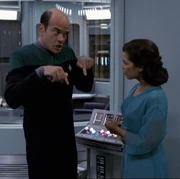
The Doctor displaying his sarcastic personality to a Qomar
The EMH Mark I was created on Jupiter Station by Dr. Lewis Zimmerman , who based the hologram's physical appearance on his own. Lieutenant Reginald Barclay also worked on the project, testing the EMH's interpersonal skills. ( VOY : " Projections ")
The EMH Mark I, upon which The Doctor's program was based, was listed as " Emergency Medical Holographic Program AK-1 Diagnostic and Surgical Subroutine Omega 323 " in Voyager 's memory. It was developed by a team of engineers to be an emergency supplement to the medical team on starships . Only meant to run for a maximum of 1,500 hours, the program included little personality and interpersonal skills. However, it was capable of treating any known injury or disease , as it was programmed with the medical knowledge of every member world in the Federation and that of over five million surgical procedures. His program even became capable of learning and adapting, in order to create new medical treatments. ( VOY : " Projections ", " The Swarm ", " Caretaker ", " Parallax ", " Cathexis ")
According to The Doctor, his original program was not configured to cry, bleed, feel pain or hunger, or to sing or dance. Neither was he programmed with reproductive organs, as he had no need for them. ( VOY : " Threshold ", " Projections ", " Body and Soul ", " Phage ", " Message in a Bottle ")
Aboard USS Voyager [ ]
The first year (2371) [ ].
The Doctor was first, albeit very briefly, activated during a ship tour with Vice Admiral Patterson by Cpt. Janeway shortly before Voyager 's launch on stardate 48038.5 in early 2371 . ( VOY : " Relativity ")
On stardate 48308.2, The Doctor was activated by Ensign Harry Kim to help treat crew members injured in the ship's violent transit to the Delta Quadrant , during which the chief medical officer and other assigned medical staff had been killed. The Doctor quickly established that the Voyager crew would be stuck with him for a while and that he would be the sole provider of medical care aboard the ship. ( VOY : " Caretaker ")
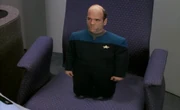
" Whatever it is, you're going to have to take care of it yourself. "
The Doctor's first few weeks as a full-time medic on Voyager were not easy for him. He had no control over his activation subroutines , so anyone could activate or deactivate his program solely at their choice. Most of the crew considered him merely a computer program or a tool, and treated him accordingly. He, in turn, was curt and rude to them, lacking empathy and bedside manner, and he was unhappy that he was being used to perform menial medical tasks. He felt that his perfection and comparative medical genius were not appreciated. When developing or performing exceptional medical procedures, he often cynically remarked that anywhere else performing such kind of a procedure would have won him a prestigious award. He was also upset at being the last one to be made aware of events that were not directly within his purview, such as the Maquis crew joining Voyager and both Neelix and Kes joining the crew. ( VOY : " Time and Again ", " Parallax ", " Shattered ", " Someone to Watch Over Me ")
When Voyager was caught in a quantum singularity , The Doctor's imaging processor began to malfunction, causing him to shrink. This malfunction was eventually repaired. ( VOY : " Parallax ", " Time and Again ")
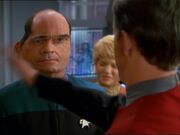
" Now, you hit me. "
One of The Doctor's first major clinical achievements on board Voyager was creating holographic lungs for Neelix . Neelix had lost his lungs to Vidiians during an organ-harvesting raid. The Doctor devised a plan to use holographic lungs to keep Neelix alive. The Doctor's idea succeeded; however, Neelix was confined to an isotropic restraint and not allowed to move, as the holographic lungs could not move. The Doctor was later able to transplant one of Kes' lungs into Neelix, with help from the Vidiians. ( VOY : " Phage ")
It was not until Kes volunteered to work with The Doctor as an assistant – and later medical student – that relations between The Doctor and most of the other crew members began to improve. It was Kes who first discovered the crew's disrespectful behavior toward The Doctor; she noticed that, just as with an item of equipment, they never addressed him directly, they barely listened to him, and often exited his presence without deactivating his program. Kes brought the matter to Captain Janeway 's attention, asking that The Doctor be treated with greater respect and granted some interpersonal autonomy. Janeway took Kes' advice to heart – somewhat reluctantly, as she herself was aware of The Doctor's questionable bedside manner – but nonetheless granted him partial control over his activation and program. He was subsequently left hurt when it was revealed that the crew were exploring a means of transporting back to the Alpha Quadrant through a small wormhole , as he was the last one to know about this development and would be left on the ship as it was impossible to download his program at this time (although the matter became academic when it was revealed that the wormhole extended into the past). ( VOY : " Eye of the Needle ")
The Doctor becomes the chief medical officer and his nurses became Kes and Tom Paris . Though it's not entirely clear when he becomes chief medical officer— there's no on-screen scene where he is promoted. In the pilot episode ( VOY : " Caretaker ") it is established that most of the medical crew is dead thus needing replacement. In the following episode ( VOY : " Parallax ") there is a scene where Captain Janeway is discussing the issue of replacing the senior officers who died including the chief medical officer. When Neelix suggests the EMH to replace the chief medical officer, Tuvok and Tom Paris give reasons why the EMH would not be sufficient for the job. Then they go right into discussing training people as field medics. The topic is not discussed again until the sixth episode of the first season ( VOY : " Eye of the Needle "), when a crew member is being rude towards the Doctor and he rebuffs by saying he is the chief medical officer and should be treated with respect. Thus it would seem that the Doctor is promoted to chief medical officer off-screen sometime between episode two and episode six of the first season.
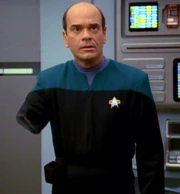
The Doctor after his first confrontation with "Grendel"
The Doctor was sent on his first away mission by Janeway, tasked with rescuing Kim, Tuvok , and Chakotay from a Beowulf holoprogram that had been invaded by a mysterious alien. Janeway's reason for deploying The Doctor on this mission was that, as a hologram, he was the only one who could not be snatched from the holodeck. The Doctor did, however, lose an arm on his first encounter with the being, which had manifested itself as the monster Grendel . Samples of photonic energy had been accidentally beamed aboard Voyager and this energy was part of the alien inhabiting the holodeck. Once returned to the alien , the crew was released. ( VOY : " Heroes and Demons ")
When the mental energy of Chakotay and the Komar was possessing members of Voyager 's crew, The Doctor was the only crew member who could not be controlled. As no one but he could be trusted, given that the Komar could inhabit anyone at any time, Janeway transferred her command codes to The Doctor so that he could countermand orders he believed were initiated due to the alien's influence. However, his program's initialization routine was later deactivated until the incident with the Komar ended. Once reactivated, the Doctor was able to reintegrate Chakotay's displaced neural energy with his body, in a procedure that required three neural transceivers, two cortical stimulators, and fifty gigaquads of computer memory, and would take about ten hours to explain to others. ( VOY : " Cathexis ")
An accident aboard Voyager once caused The Doctor to confuse illusion with reality. A hallucination of Lieutenant Reginald Barclay told The Doctor that he was real, that he was actually Lewis Zimmerman and married to a very Human Kes. The illusory Barclay persuaded The Doctor that he was held within a hologram of Voyager , with radiation after an accident having killed him. The Doctor became convinced that the only way to escape was to fire a phaser into Voyager 's warp core , an act that seemingly would result in the simulation's destruction. At the last possible second, Chakotay convinced The Doctor that he was about to destroy his own matrix. The problem was solved, although The Doctor was left intrigued as to why he had hallucinated about the nature of his existence rather than simply having had his program's defenses activated. ( VOY : " Projections ")
The same year, The Doctor diagnosed that Kes' sexual maturation, the elogium , had been prematurely activated by a swarm of space -dwelling aliens. During this period he acted in the role of Kes' father by performing the necessary rituals with her, such as the rolissisin , a ritual in which the feet are massaged until the tongue swells. Kes' elogium ended when Voyager cleared the aliens' territory. The Doctor hypothesized that the elogium had been prematurely triggered by the aliens and that Kes would still be able to conceive at her natural age of elogium . ( VOY : " Elogium ")
The second year (2372) [ ]
In 2372 , The Doctor still didn't consider himself a true member of the Voyager crew. He felt he was not being kept sufficiently informed about ship business and missions. As a result, he was forced to repeatedly open communications channels all over the ship in order to find out what was going on, an activity Captain Janeway asked him to discontinue. ( VOY : " Parturition ")
In response to criticism that he was unsympathetic to his patients, he programmed himself with the Levodian flu for twenty-nine hours to simulate the effects and to prove that a little illness should not be grounds for a constantly whiny and cranky attitude, which he accused the Voyager crew of every time they entered sickbay . Thirty hours later the simulated flu still had not cleared him, and The Doctor became fearful, feeling helpless and not in control. Kes later admitted that she had extended the simulation unbeknownst to him to teach him a real-life lesson, as it would hardly have been a real illness if he had known the outcome. ( VOY : " Tattoo ")
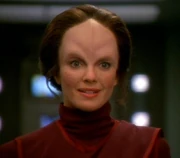
Danara Pel's holographic body
Despite initial irritations and frictions, The Doctor also experienced new things in the personal growth and romance department. When a Vidiian scientist named Danara Pel was beamed aboard Voyager to be treated, The Doctor transmitted her synaptic pathways into a hologram of her body without the disease and put her real body in stasis until he could find a cure for her breakdown. He grafted a piece of B'Elanna Torres ' brain tissue onto Pel's brain, as Klingon DNA had been found to be resistant to the phage . Over time he became attracted to her, but as he was inexperienced in the matters of the heart, he did not know how to handle his new-found emotions and confess his feelings to Denara. After receiving some advice from crew members such as Kes and Tom Paris , he overcame his initial awkwardness and took Denara on a date on the holodeck. When a cure for her condition was found and The Doctor was finally able to take Denara out of stasis, she refused, stating that she did not want to go back to that deformed body. The Doctor assured her that he loved her no matter what she looked like and that he would not want her to give up her life. The Doctor and Denara spent two weeks with one another before she met with her people and had to leave Voyager . ( VOY : " Resolutions ")
Voyager entered a plasma cloud which caused the ship and its crew to be duplicated. The Doctor was on one of the ships and delivered Ensign Samantha Wildman 's baby, who died shortly after birth. After the other ship was invaded by Vidiians, The Doctor on that ship saved that Ensign Wildman's baby, keeping it hidden from the Vidiians until that Kim and the baby could board the "first" Voyager , which they did just before their ship self-destructed , killing the Vidiians and saving the "first" Voyager . ( VOY : " Deadlock ")
When a transporter accident combined Tuvok and Neelix into a single entity named Tuvix , The Doctor found a way to separate and restore them. However, he refused to perform the procedure as he would have to kill Tuvix, a sentient being in his own right who had refused to consent to the separation. Captain Janeway eventually performed the procedure in his stead. ( VOY : " Tuvix ")
When Voyager discovered a group of alien survivors trapped in a neural network by a deranged clown-like manifestation of their own fears , The Doctor was selected as the crew's 'negotiator' as he was the only person who could access the network without being trapped in it. Although he initially failed to reason with the Clown, he was eventually able to trick the Clown into releasing his current "hostages" by claiming that Janeway would take their place, the crew in reality providing a fake Janeway. ( VOY : " The Thaw ")
The Doctor played an essential part in the defeat of the Kazon sect led by Seska and Culluh . After the crew was captured and marooned on a desolate planet , The Doctor – who escaped deletion by claiming that as a hologram he was neutral and thus did not care whether Kazon or Starfleet were in charge of Voyager – with the help of Lon Suder sabotaged the backup phaser couplings . This allowed Tom Paris and his Talaxian allies to retake the ship and save the crew. ( VOY : " Basics, Part I ", " Basics, Part II ")
The third year (2373) [ ]
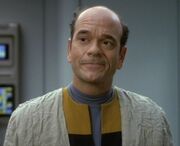
Diagnostic Program Alpha-11
In 2373 , The Doctor reached the limit of his memory capacity and started suffering massive memory loss. When an alien attack injured Paris, The Doctor was unable to treat him because his program was degrading and he was beginning to lose all of his medical knowledge. When it became evident that his program would disintegrate completely, another hologram, the Diagnostic Program Alpha-11 , was used to find the source of the problem. It was discovered that the problem was in The Doctor's core programing, which had become severely fragmented because of constant use of the EMH over the course of the past two years. The maximum operation for the EMH was intended for around 1,500 hours (roughly two months). To further complicate matters, The Doctor's expansion of his original programming to include personality subroutines and interests in things such as opera , interpersonal relationships with the crew and engineering skills had filled all of his available memory buffers, leaving little room for his program to operate in its intended function.
The captain was playing with the idea of reinitializing The Doctor's program, but that would have meant loss of all his memories and everything he had experienced over the past two years. Kes objected to just resetting him and asked the captain to try and find another solution. When no other options were found, Kes suggested overlaying the diagnostic program's programming matrix onto The Doctor's. This effectively deleted the Diagnostic program and integrated its core portions as a graft onto The Doctor's program. This procedure restored The Doctor but led to massive memory loss, including his recollection of the crews' identities and most events of the previous two years. Although some memories seemed to have survived, it was unclear if The Doctor would struggle to regain his hard-won personal skills. But some hope remained when Kes, after the reinitialization, observed The Doctor singing a song to himself; a song that was learned prior to the transfer of the Diagnostic program matrix onto his own. ( VOY : " The Swarm ")
Later that year, he assisted in stopping Henry Starling 's plan to steal a timeship which had accidentally traveled into the past, simultaneously acquiring a mobile emitter that permitted him movement beyond the limits of Voyager 's sickbay and holodeck after Starling "stole" him from Voyager to question him about their presence in this timeline, transferring him into the mobile emitter to make it easier to threaten his existence. Having escaped Starling, the Doctor rescued Chakotay and Torres from some survivalists, returned to Voyager and enjoyed his new-found freedom from sickbay, the emitter proving simple for the Doctor to use while also allowing him to be returned to sickbay. ( VOY : " Future's End ", " Future's End, Part II ") The Doctor was able to create a device to remove Ilari warlord Tieran 's consciousness from Kes. ( VOY : " Warlord ") He also helped Janeway rid Voyager of an attacking macrovirus when she returned from an away mission and the rest of the crew had been infected. ( VOY : " Macrocosm ")
In an attempt to improve himself further, The Doctor created EMH program 4C , adding personality subroutines to his holomatrix copied from many historical figures, including Lord Byron , Mahatma Gandhi , Socrates , Marie Curie , and T'Pau . Unfortunately, The Doctor didn't realize that even great historical figures had less desirable attributes and that all those, combined within his personality, would cause his program to destabilize. As a result, The Doctor began to develop a second, darker personality which exhibited callousness, anger and deceit. He attacked B'Elanna Torres, who was trying to fix his program, and rendered her immobile so she could not tell on him. He also attacked Zahir , an alien whom Kes had befriended, and kidnapped her, trying to arrange passage to another planet . Protective of and attracted to Kes, The Doctor attempted to kill Zahir, claiming that Kes' innocence required that he be there to protect her. After the failed escape attempt with Kes in tow, The Doctor was beamed back aboard Voyager , having finally lost the added subroutines and unable to remember his actions ever since the darkening in his personality had taken over. ( VOY : " Darkling ")
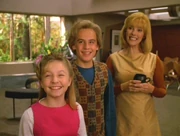
The Doctor's holographic family
Despite such incidents, The Doctor nonetheless continued to expand his programming. In order to experience Human family values, he once created a holodeck family, assuming the name of "Kenneth." Initially the program was idyllic, with a devoted, loyal wife who loved chores and serving her husband and obedient children who insisted doing their homework and fought over who would say goodbye to "Daddy" first when he left for work. The Doctor was pleased, but when he invited Kes and Torres over for dinner, Torres was more than annoyed with the "lollipops" – as she called them – The Doctor had created, stating that what he had created was in no way what a family life dynamic was like. With The Doctor's permission, Torres reprogrammed it to be more realistic. In the new simulation, his wife wasn't a devoted housewife looking forward to his bringing colleagues home for dinner and his children were rebellious, undisciplined and disobedient. The Doctor was mortified at the changes, as they were not at all what he had in mind when imagining his family. He even contemplated deactivating it permanently after his 'daughter' was fatally wounded in an accident and he could not take the pain that came with losing her. However, Tom Paris helped The Doctor learn to cope with the negatives as well as the positives in having a family, and The Doctor returned to the program to mourn the loss of his daughter with his wife and son. ( VOY : " Real Life ")
The Doctor proved instrumental in assisting the crew's escape after an alien race knows as the Nyrians commandeered Voyager and relocated the ship's entire crew into an artificial environment suitable for them. Chakotay, as the last crew member on board, transferred The Doctor's program into the mobile emitter before he could be deleted. Torres subsequently modified The Doctor's optical sensors, allowing him to "see" portals between artificial environments, and with the aid of another prisoner, named Jarlath , the crew reached the Nyrians' spaceship and retook Voyager . ( VOY : " Displaced ")
The fourth year (2374) [ ]
In late 2373 - 74 , Voyager became involved in a war between the Borg and Species 8472 . Janeway made a pact with the Borg for safe passage through their space in exchange for providing them with technology that could defeat Species 8472. After Harry Kim was injured in an attack by Species 8472, his cells began to be destroyed, but The Doctor used nanoprobes to cure him by reprogramming the nanoprobes to directly attack the invading cells. This treatment enabled Voyager 's crew to develop a weapon that could be used against Species 8472, giving the crew a bargaining chip to negotiate a temporary alliance with the Borg. ( VOY : " Scorpion, Part II ")
After the alliance with the Borg ended, Janeway took in Seven of Nine , a Borg drone. The Doctor removed most of Seven's Borg implants and helped restore her to her Human form. ( VOY : " Scorpion, Part II ", " The Gift ")
Like the rest of the crew, The Doctor mourned Kes' departure from the ship, as her enhanced telepathic abilities became too dangerous for her to remain aboard Voyager . ( VOY : " The Gift ")
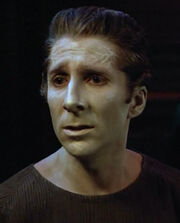
Dejaren in 2374
The Doctor and Torres answered a distress call and found a hologram named Dejaren alone on a ship. Initially The Doctor tried to befriend the hologram, sympathizing greatly with its struggles. Dejaren was eager to learn about The Doctor's freedom on Voyager , as his own crew never treated him as anything other than equipment and kept him constantly confined in one part of the ship. Eventually The Doctor and Torres discovered that Dejaren had killed his organic crew on the ship, having been driven mad by constantly being treated as a tool. After failing to convince The Doctor that holograms were a higher form of life, Dejaren tried to kill Torres and deactivate The Doctor by stealing his mobile emitter. Fortunately, Torres was able to successfully deactivate Dejaren by destabilizing his holomatrix, leaving the crew with a greater appreciation of The Doctor's personality and loyalty. ( VOY : " Revulsion ")
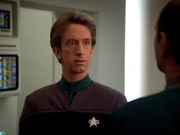
The EMH Mark II meets the EMH Mark I
The Doctor, upon his first mission to the Alpha Quadrant , was instrumental in establishing contact with Starfleet . Shortly after Voyager discovered a Hirogen communications network leading into the edge of the Quadrant, the crew attempted to send a message to a particular Starfleet vessel, the USS Prometheus , which was within range of the farthest relay. When the message failed to reach the Alpha Quadrant, however, Voyager 's crew decided to send a hologram, as it was less likely to decompile before reaching its destination. With limited time to write a completely new holographic program to send through the network before the ship moved out of range, The Doctor was the only program large enough to have a chance of making it through the network intact.
When The Doctor reached the Prometheus and discovered that the ship had been taken over by Romulans , he once again claimed holographic neutrality to escape deletion. The Doctor had to activate the experimental EMH Mark II on board the Prometheus, and despite the initial conflict between the two (the Mark II apparently thought that The Doctor was defective and obsolete, while The Doctor regarded the Mark II as an arrogant new upstart), the holograms retook control of the vessel. They accomplished this by combining The Doctor's personal experience with the Mark II's detailed knowledge of the ship. Having defeated numerous Romulan warbirds surrounding the Prometheus , Starfleet officers boarded the vessel and The Doctor was subsequently able to speak directly with Starfleet Headquarters and set the record straight about Voyager 's disappearance. The Doctor returned to Voyager , with welcome news that the ship was no longer alone. ( VOY : " Message in a Bottle ")
Later in 2374, The Doctor and Harry Kim played an important role in helping to retake the ship from the Hirogen, who were using the ship's previous crew as prey in holoprograms but had left both The Doctor and Kim free, so that The Doctor could heal the crew and Kim could work on expanding the holodecks. The Doctor was forced to treat Seven of Nine, but upon doing so he secretly added a program to her Borg components that would restore her memories during the simulation, starting a chain of events that would bring Voyager back under the control of the crew. During a Nazi program, he and Neelix persuaded the Klingons in one program to attack the Hirogen and Nazi soldiers. ( VOY : " The Killing Game ", " The Killing Game, Part II ")
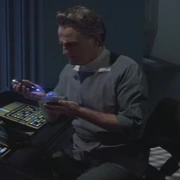
Quarren, holding The Doctor's backup module
The same year, a group of Kyrians , led by Tedran , beamed aboard the Voyager and took several people hostage. They were defeated when Tedran was killed by the Vaskan ambassador Daleth .
Several days later, Voyager was attacked by nine Kyrian ships. Several troops managed to board Voyager and stole various pieces of technology before escaping, including the EMH backup module . The devastating Great War between the Vaskans and Kyrians that followed was called The Voyager Encounter , as the official records were altered to portray the Kyrians as the victims and Voyager as the aggressors.
Seven hundred years later, a backup copy of The Doctor's program was reactivated in the Kyrian Museum of Heritage by Quarren and blamed for war crimes the crew of Voyager didn't commit. The Doctor, horrified at the museum's portrayal of Voyager 's role in the Great War, debunked the holoprogram used to teach this version of history and explained the true history of the Kyrian/Vaskan conflict, and although this caused old tensions between the two races to once again flare up, it led to a new understanding between them and eventually created a harmonious society.
This copy of The Doctor became the Kyrian Surgical Chancellor for many years after these events. Eventually, however, he left his post in a one-person ship with the aim of reaching the Alpha Quadrant, claiming that "he had a longing for home". ( VOY : " Living Witness ")
The fifth year (2375) [ ]
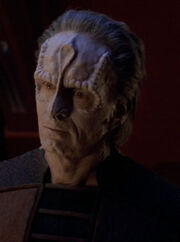
Dr. Crell Moset
In an attempt to save Torres, who had a cytoplasmic lifeform attached to her, The Doctor called upon a holoprogram of a Cardassian named Dr. Crell Moset , a renowned exobiologist in the Alpha Quadrant. Bajoran crew member Ensign Tabor informed Janeway and The Doctor that Moset had committed war crimes during the Cardassian occupation of Bajor and that he was personally responsible for the death of his father. This caused a controversy on board, as Tabor and others demanded that Moset's program be put offline and decompiled and his research obliterated altogether or else they would resign their commissions. The Doctor, unaware of Moset's reputation, was at first unwilling to delete the program and refuse Moset's help, and eventually used it to save Torres. However, as pressure from all sides kept building up and as he himself discovered that Moset's actions were unethical, he deleted the Moset program from all of Voyager 's files. ( VOY : " Nothing Human ")
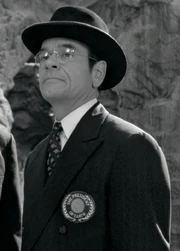
The Doctor as the President of Earth
The Doctor undertook the role of the President of Earth in the holoprogram The Adventures of Captain Proton . In doing so, he interacted with photonic lifeforms in a successful attempt to persuade them to help Captain Proton in stopping Doctor Chaotica . The Doctor even joked that he might run for office once the crew returned to Earth. ( VOY : " Bride of Chaotica! ")
That same year, The Doctor experienced a deep personal crisis of his own: He found out that memory files pertaining to an Ensign Ahni Jetal had been deleted from his program. When he confronted the crew, they reluctantly told him what had happened. Harry Kim and Jetal had been seriously injured during an away mission a few months earlier. Because The Doctor could not perform life-saving surgery on both patients simultaneously, he was forced to pick one patient, knowing that the person he was unable to treat would die. In a split-second decision, The Doctor decided to operate on Kim, thus indirectly allowing Jetal to die. Shortly after, The Doctor fell into a deep ethical crisis, questioning his decision to treat Kim and not Jetal, even though their injuries were equally fatal. He blamed himself over and over again for having been biased and helping his friend rather than Jetal, whom he was not as close to. He became caught in a loop of constantly questioning his decisions to the point where he broke down completely, unable to function. The captain decided that it would be best if the memories of Jetal and the incident be deleted. However, the truth did come out and as soon as The Doctor found out, the same pattern emerged and he found himself struggling with the same dilemma once again.
After Seven pointed out that they should not treat The Doctor like a piece of equipment but instead like the individual he had become, the captain decided that this time, instead of deleting his memories, they would stand by him and try to help him in this crisis, just as they would a friend or any other flesh-and-blood member of the crew. Janeway helped him accept his decision and realize that part of being an individual is making tough decisions and learning to live with them. ( VOY : " Latent Image ")
Later that year, The Doctor tried to give Seven of Nine social lessons on how to date. During their sessions he became quite infatuated with her, but could not bring himself to admit his feelings. He also had a small wager with Tom Paris, who had told The Doctor that Seven was incapable of going on a date without causing an incident. The Doctor told Tom that he would prove him wrong in exchange for doing a full month of sickbay duty. When Seven found out about the wager, she was disappointed in The Doctor, but she forgave him later when he apologized. When Seven told The Doctor that she no longer needed the lessons as there were no suitable mates for her on board, The Doctor was crushed about Seven's obviously not reciprocating his feelings, and he returned to the holodeck for a lonely rendition of " Someone to Watch Over Me ". ( VOY : " Someone to Watch Over Me ")
The sixth year (2376) [ ]

The weapon the crew found
In 2376 an artificial intelligence was found on a planet and the crew discovered that it was a weapon sent on a mission of destruction. The machine interfaced with The Doctor's matrix and took it over. It threatened Voyager to take it to its target. Eventually it was convinced that its mission had been an accident; its systems had been triggered by a computer error and a target had merely been selected at random. Transferring its intelligence out of The Doctor, it was beamed off Voyager and destroyed other war machines on the same obsolete mission. ( VOY : " Warhead ")
Early in the year, The Doctor was investigating the USS Equinox and was disabled by that ship's EMH, who stole his mobile emitter and returned to Voyager , posing as him.
Later, when he was reactivated by Captain Ransom , his ethical subroutines were deactivated to coerce him into extracting information from Seven of Nine.
After he was restored to himself and escaped to Voyager , Seven offered to add security measures to his program to prevent further tampering, assuring him that she bore him no ill will (she even "teasingly" informed him that he was off-key when he sang to her as he tapped into her implants). He also deleted the Equinox EMH upon returning to Voyager , although the Equinox EMH tried unsuccessfully to threaten him with holographic bombs. ( VOY : " Equinox ", " Equinox, Part II ")
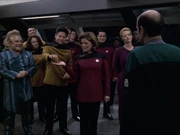
A celebration for The Doctor as he receives the Starfleet Medal of Commendation
Captain Janeway awarded The Doctor the Starfleet Medal of Commendation for his part in repelling raiders who wanted to strip Voyager of essential components. This predicament was both incited and resolved successfully thanks to The Doctor's experimentation with introducing daydreaming to his program; the aliens hacked into The Doctor's program, but due to his daydreams, they were given an exaggerated image of Voyager 's defenses and were tricked into retreating. In light of his accomplishments, Captain Janeway gave permission for research into the creation of an Emergency Command Hologram , to take command of the ship if the senior staff were ever immobilized. However, he was left more than slightly embarrassed by the fact that several of his daydreams featured Janeway, Seven, and Torres competing for his affections (as well as one where he painted Seven in the nude), although Janeway assured him that it was only Human to fantasize. ( VOY : " Tinker Tenor Doctor Spy ")
The Doctor played the part of the village priest, Father Mulligan, in the Fair Haven program. When he tried to free Kim and Paris from the townsfolk, who believed they were evil spirits, he himself was captured. The townsfolk decided to hypnotize him for answers. The Doctor was highly skeptical; however, they managed to successfully hypnotize him after taking his mobile emitter away. Pressed to reveal his true name, he admitted that he "had not decided on one yet." ( VOY : " Fair Haven ", " Spirit Folk ")
Due to a time differential, The Doctor was sent to a planet with a tachyon core as, being a hologram, it wouldn't affect him. Due to problems, The Doctor spent three years on the planet, during which time he gathered information on its geologic problems, lived in an apartment with a roommate, and had a son named Jason . How he had a son is unclear, as he only said it was a long story, but when an astronaut returned to the planet to enlist their help in freeing Voyager , The Doctor requested that a message be passed on to his son's family. ( VOY : " Blink of an Eye ")
While encountering the Qomar he began singing, which awed the aliens, as they had no concept of music. He gave a recital on their planet, they asked him to stay, and he considered resigning his post as Voyager 's chief medical officer to pursue a full-time career on the Qomar homeworld . However, upon revisiting the planet, he discovered that the Qomar had made what they considered a superior holoprogram (in that it could sing notes outside the Human vocal range), and that he was not wanted. He returned to Voyager , depressed at how his musical career had ended, and embarrassed at his earlier actions, but a final piece of fan mail from Seven assured him that he was still appreciated on Voyager . ( VOY : " Virtuoso ")
When Voyager encountered con artists posing as Janeway, Tuvok, and Chakotay in an attempt to make money, The Doctor proved instrumental in the recovery of the stolen property. After tricking Dala , one of the con artists, into boarding the Delta Flyer , The Doctor and Tom Paris knocked her out. The Doctor subsequently altered his holographic matrix so that he resembled Dala, allowing him to confront the other two con artists and learn where they had concealed their stolen property before turning them over to the local authorities. ( VOY : " Live Fast and Prosper ")
The final year (2377-2378) [ ]
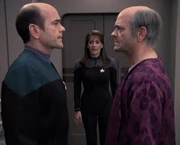
The Doctor with his creator, Lewis Zimmerman, and Deanna Troi
The second mission to the Alpha Quadrant occurred when Lewis Zimmerman was dying and The Doctor requested to be transmitted back to the Alpha Quadrant to help treat him. While he was at Jupiter Station, Lewis Zimmerman fought The Doctor and his treatment, regarding The Doctor's presence as an unpleasant reminder of his failure with the Mark I as a whole. This caused Reginald Barclay to contact Deanna Troi to help out with the situation. Neither the counselor nor Barclay could make either doctor reach any sort of agreement, as both of them were too stubborn to back down. It wasn't until The Doctor began to decompile that Lewis Zimmerman corrected the error and the two reached a mutual understanding that bordered on a father/son relationship. This was mainly reflected in a conversation where The Doctor admitted that he'd hoped Zimmerman would be proud of his accomplishments if they ever met, and Zimmerman confessed that he was grateful that at least one EMH Mark I was still doing what he had designed them for. The treatment worked, and shortly before The Doctor left for Voyager , Zimmerman told The Doctor that he could call him next time Voyager was given a chance to communicate with Earth. ( VOY : " Life Line ")
During the last year of Voyager 's journey home, The Doctor's program was stolen and sold to Dr. Chellick , who was in charge of a medical hospital on the planet Dinaali . The Doctor was appalled at the medical malpractice that was taking place. Only the rich or useful were accorded the best medical care, while others were left to die or denied medicine because of their social standing. Along with a few medical personnel, he helped change the situation, although he suffered an ethical crisis afterward. In order to convince the staff to change procedure, The Doctor had deliberately infected Chellick with a potentially fatal virus. Because Chellick was classified as a lower grade patient, he was forced to change his normal procedure to save his own life. ( VOY : " Critical Care ")
Seven of Nine and The Doctor became one when, in order to hide his matrix from aliens who hunted and destroyed holograms, he was downloaded into her cybernetic implants. He experienced the Human feelings of taste and touch for the first time. Seven became angered at his 'abuse' of her body while he was in charge of her functions. The Doctor felt Seven showed excessive restraint and did not allow for superfluous pleasure, a thing that The Doctor thought was an important part of life. After they returned to Voyager, however, Seven seemed to better understand his point of view, bringing a meal to sickbay and describing the sensations of eating it to The Doctor to allow him to continue to experience it. ( VOY : " Body and Soul ")
When Voyager responded to a Hirogen distress call, the crew found that the holograms created as victims for Hirogen training had turned against the hunters. A group of these holograms had escaped to a ship and later kidnapped The Doctor. He discovered the holograms were just trying to find somewhere where they could live in peace. Eventually agreeing to help them, he escaped with them and took Torres to help the holograms set up a civilization of their own.
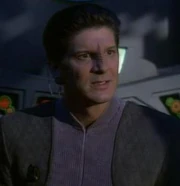
Iden in 2377
However, the holograms, led by Iden , took extraordinary measures to achieve their freedom, even going along with Iden's plan to attack and eventually destroy a mining vessel to obtain and "liberate" fellow holograms. The Doctor's suspicions about Iden were confirmed when he admitted he wished to start a new religion , with himself as the "Man of Light" having freed numerous holograms in various and often violent fashions, considering all organics as being the same despite the Doctor's protests, believing that B'Elanna displayed her prejudices when she stated that three holograms Iden had just 'liberated' were simply too basic to maintain sentience. Eventually the Doctor had to destroy Iden to protect everyone else. Ashamed of his actions, he volunteered to turn in his mobile emitter, but Janeway assured him that nobody blamed him for doing the Human thing and making a mistake in judgment. The Doctor's time with these holograms had a profound effect on him. From this time on, he began to use their term "organics" and became interested in the rights of other holograms, including his " brothers ", the other, recommissionsed EMH Mark Is. A little while later, he confessed in private to Janeway that there had been a time when he would have given anything to be made of flesh and blood, but now he loved being a hologram, seeing it as superior to being organic. ( VOY : " Flesh and Blood ", " Author, Author ", " Renaissance Man ")
Shortly after this, The Doctor discovered that B'Elanna Torres was pregnant with Paris's child. At first Torres tried to reprogram The Doctor to alter the child's DNA and remove the Klingon traits, fearing a repeat of her own upbringing. While growing up she believed her father had left because he couldn't handle two Klingon women. After talking with her, Tom Paris eventually convinced Torres that he would love their children no matter what they were like and he hoped that every one of them would be just like her. After apologizing to The Doctor for reprogramming him, Torres asked him to be the child's godfather and he willingly accepted. ( VOY : " Lineage ")
When the crew was forced to transport alien prisoners to a distant planet where they would be executed for their crimes, The Doctor was appalled at the death penalty rule enforced by the planet. He also discovered that Iko , one of the patients, had actually been born with a brain defect that left him prone to violence. Using Seven's nanoprobes, The Doctor managed to cure Iko of this defect, effectively restoring Iko's conscience and making him a new person. Iko's appeal was, tragically, rejected, but The Doctor and Seven were able to take some small measure of comfort in knowing they had helped him. ( VOY : " Repentance ")
When Voyager was abandoned due to tetryon radiation flooding, Captain Janeway activated the ECH for the first time, allowing The Doctor to repair damage to the ship while the crew waited in the escape pods for Voyager to be declared safe once again. The Doctor managed to defend the ship against scavengers and had begun enacting repairs by the time Chakotay and Kim, who had been on an away mission, returned to the ship. The Doctor further demonstrated his command abilities by utilizing a photonic shockwave to disable two Quarren patrol ships . While repairing the ship along with Ensign Kim, they frequently conflicted regarding the impromptu chain of command – while Kim was actually a commissioned officer , The Doctor was programmed with the experiences of renowned commanders throughout history . Harry's strategy saved the ship from attack, and The Doctor was forced to admit that he lacked the valuable practical operational experience of other officers. He made peace with Harry before returning to his normal role as Chief Medical Officer. ( VOY : " Workforce ", " Workforce, Part II ")
After an away team became trapped on a planet with a toxic atmosphere, The Doctor was part of a rescue that was launched. The Doctor almost single-handedly rescued the entire team when he dressed as a native and infiltrated the native's caves. He explained that since he was a hologram, the radiation had no effect on him, and he was able to effectively disguise himself as part of the plan. Later on Voyager , he treated a baby infected with radiation poisoning and cured him and a native with the help of Seven of Nine. ( VOY : " Friendship One ")
The Doctor activated his command subroutines again in 2378 in an attempt to rescue Captain Janeway from the aliens who had kidnapped her. His holographic matrix altered to allow him to pose as various members of the crew, such as Janeway, Torres, and Chakotay. The Doctor was eventually able to evacuate Engineering and activate the ECH program. As the Emergency Command Hologram, The Doctor had the authorization to eject Voyager 's warp core ; he then tried to free the captain by exchanging the core as ransom. He was able to rescue Janeway and recover the core, but when the excess subroutines inserted by the aliens nearly caused his program to collapse, he made several embarrassing "deathbed" confessions including his love for Seven. Having recovered, he subsequently spent a whole week in sickbay out of sheer embarrassment but was eventually convinced by Janeway to rejoin life on the ship. ( VOY : " Renaissance Man ")
He returned to Earth when Admiral Janeway changed the timeline by going back in the past and helping Voyager return to Earth sooner than the twenty-one years it originally took. During that time The Doctor was treating Lt. Commander Tuvok's degenerative neurological disease, but kept it quiet at Tuvok's request. The Doctor's last action on the ship was to help deliver his goddaughter , Miral Paris , while in the Borg transwarp hub. As the crew were contacted by Starfleet ships, The Doctor alerted Miral's father that " There's someone here who'd like to say 'Hello'. " ( VOY : " Endgame ")
In 2381 , an irate Ensign Brad Boimler ranted to a bunch of hecklers that the Doctor shouldn’t have to justify his existence due to his experience in the Delta Quadrant and that he has rights, suggesting that the Doctor may have finally been considered sentient. ( LD : " Reflections ")
Personal interests [ ]
Identity [ ].
Motivated by Kes ' kindness, The Doctor entertained the idea of taking a name , due in part to the required prolonged existence. ( VOY : " Parallax ")
Ultimately, The Doctor has used several names on a temporary basis. Below is a list of names he used:
- Lord Schweitzer ( VOY : " Heroes and Demons ")
The first of a number of names chosen by The Doctor in honor of great medical figures of Earth's past. In this case, the name was used in order to interact with Freya and other characters in Harry Kim 's holographic recreation of the poem Beowulf ; following Freya's "death", where this name was the last thing she said to him, the Doctor discontinued using the name, finding the association with her too painful to bear.
- Shmullus ( VOY : " Lifesigns ", " Resolutions ")
Given to The Doctor by Danara Pel , named after her favorite uncle as a child who had always been able to make her laugh.
- Mozart & van Gogh ( VOY : " Before and After ")
Adopted in succession by The Doctor sometime around 2378 of an alternate timeline, during a period of interest in great cultural figures of Earth's history.
- Kenneth ( VOY : " Real Life ")
Chosen in order to interact with his holographic family.
- Joe, after Joe ( VOY : " Endgame ")
Chosen by The Doctor in 2404 of an alternate timeline, in which Voyager returned home 16 years later than it ultimately did. Apparently a permanent selection.
In addition, over the years several Voyager crewmembers such as Paris, Harry Kim , Chakotay , and B'Elanna Torres took to simply calling him "Doc." ( VOY : " Caretaker ", et al.) Kim introduced The Doctor to a holographic representation of Crell Moset , explaining that " his friends call him Doc. " ( VOY : " Nothing Human ")
He was identified to Jupiter Station's computer by Doctor Zimmerman, during The Doctor's visit in 2377, as " Voyager 's EMH". ( VOY : " Life Line ") He was also identified by Tuvok with the same designation, during the arbitration of the release of The Doctor's holonovel , Photons Be Free , when he stated to Ardon Broht that " you claim The Doctor doesn't have the legal right to control his holoprogram, yet you're promoting the fact that Voyager 's EMH wrote it. " ( VOY : " Author, Author ")
Other times he was identified as " Voyager 's doctor", once by Pete Harkins , and another time by Quarren , upon encountering The Doctor 's backup . ( VOY : " Pathfinder ", " Living Witness ")
Holo-family [ ]
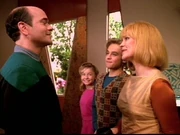
The Doctor's family
The Doctor decided to create a holographic family, Doctor's Family Program Beta-Rho , in Voyager 's holodeck in 2373 , using the name Kenneth for himself. They consisted of a wife, Charlene , and two children, a son, Jeffrey , and a daughter, Belle .
At first, family life was blissfully perfect until B'Elanna Torres "visited" the family at home and found them to be unrealistic. She altered the program, adding randomness and "realism". As a result, his teenage son Jeffrey became rebellious and began to hang out with some unsavory Klingon youths. In addition, he argued with Charlene and lost the formerly close bond he had possessed with Belle. Upon Belle's Parrises squares accident, the family came together.
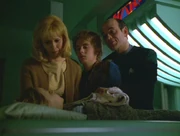
Comforting Belle
Initially apprehensive about losing her, The Doctor was persuaded by Tom Paris not to delete the program after this incident, but to work through her death with his remaining family. ( VOY : " Real Life ")
Hobbies [ ]
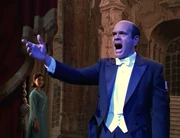
The Doctor, singing
The Doctor took a keen interest in opera , frequently practicing his singing with a holographic soprano. ( VOY : " The Swarm ")
Seven of Nine helped with The Doctor's singing capabilities when, while being held against her will on the USS Equinox , she noticed his vocal modulations deviated by 0.30 decihertz. When they returned to Voyager , she informed him of this fact and he agreed to meet her on the holodeck: " Just you, me and a tuning fork. " ( VOY : " Equinox, Part II ")
Writing [ ]
Singing was not the only creative outlet for The Doctor. He worked hard to create a holographic novel called Photons Be Free , based on an EMH on the starship Vortex and the treatment he faced from the organic members of the crew. The characters and the environment were strongly based on the crew of Voyager . After discovering his friends were concerned about his interpretation of them, he agreed to change it despite the weeks of work involved.
His publisher didn't appreciate the delay and so published the original version. In an argument with the publisher, The Doctor was told he had no rights: although he might be the author, as a hologram he wasn't a sentient being. During the subsequent debate, Janeway, Tuvok , Seven, Barclay and Kim spoke on The Doctor's behalf. Tuvok pointed out that The Doctor had created an original piece of work; Seven explained how The Doctor helped her develop as a person; Barclay compared The Doctor's aid to Zimmerman as a son seeking his father's approval; Kim explained how the Emergency Command Hologram subroutines represented a Human desire to change; and Janeway cited The Doctor's defiance of her orders as a Human action, something that a mere hologram – designed to obey orders – couldn't have done. At the conclusion of the 'trial', The Doctor, though not deemed a "person" at the time, was found to have the same rights as a non-holographic author and was allowed to recall the original version of the holonovel in favor of the new one when it was ready. The judge further urged The Doctor to continue his fight for sentience upon his return to Federation space. ( VOY : " Author, Author ")
Photography [ ]
The Doctor also was something of a shutterbug . He enjoyed using a holo-imager to record his experiences, times with his friends and away missions. In one instance this fascination caused him to reveal a conspiracy against him designed to suppress his memory of events that led to a loop in his programming. ( VOY : " Drone ", " Latent Image ", " Tinker Tenor Doctor Spy ", " Life Line ", " Course: Oblivion ")
Inventions [ ]
The Doctor was responsible for fashioning a fully functional prosthetic eye for Seven of Nine's left eye socket capable of rendering images nearly as clearly as her right eye. ( VOY : " The Gift ")
The mobile emitter [ ]
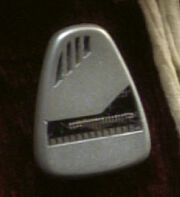
The Doctor's mobile emitter
In 2373 , Voyager encountered the Aeon under command of Captain Braxton . Due to a temporal paradox , Voyager was transported to Earth in 1996 . During this mission The Doctor obtained a piece of 29th century technology from Henry Starling, originating from the Aeon , called a mobile emitter . This device, though only a few centimeters long, was able to contain the entire EMH program and project The Doctor autonomously. After the timeline was restored and Voyager returned to the Delta Quadrant, The Doctor kept the emitter. It was quickly established that the transfer of The Doctor's program to and from the emitter would be quite easy; practically all he had to do was issue a voice command and attach the emitter to his left shoulder.
This device proved to be of vital importance and saved the crew of Voyager on numerous occasions. One of the most notable times when the emitter proved useful was shortly after The Doctor had acquired it. He helped Captain Janeway fight off a swarm of macroviruses that had infected the ship; since Janeway had been away at the time, and The Doctor (as a hologram) was naturally immune to the virus, they were forced to stand alone to save the crew. ( VOY : " Macrocosm ") The emitter also allowed The Doctor to help crew members all over the ship, which was especially useful after Kes left a short time later. ( VOY : " The Gift ")
The mobile emitter helped The Doctor to watch over the ship while the crew was in stasis during a trip through a radioactive Mutara class nebula . While proving to be helpful in allowing The Doctor to help Seven of Nine during this situation, the nebula affected the emitter, damaging its electro-optic transmitter . The Doctor, later, linked the emitter to the EPS relay network. For some time, this worked, until the EPS relays started to fail, after which the emitter went offline. ( VOY : " One ")
Due to a transporter accident, the mobile emitter was combined with some of Seven of Nine 's nanoprobes. This, combined with Ensign Mulchaey 's DNA, created a new Borg drone with 29th century technology and the mobile emitter intact as an integral part of its central nervous system . This drone called himself One and eventually sacrificed himself in order to save the crew of Voyager . Afterward, the mobile emitter was salvaged and returned to The Doctor. ( VOY : " Drone ")
On some occasions the emitter was stolen from The Doctor and/or used by rogue programs, such as Dejaren , Iden , and the reprogrammed EMH Mark I of the USS Equinox . ( VOY : " Flesh and Blood ", " Equinox, Part II ") On all occasions however, The Doctor was able to recover the emitter with no apparent side effects to his program. The mobile emitter was also used by a version of The Doctor that had corrupted files after he had attempted to improve his personality. ( VOY : " Darkling ")
Other notable occasions in which the emitter was used by holograms other than The Doctor were when the Leonardo da Vinci hologram was transferred to it after both the emitter and main computer core were stolen in a transporter attack ( VOY : " Concerning Flight ") and when The Doctor loaned the emitter to the Barclay hologram that had been received in a data stream. ( VOY : " Inside Man ") Michael Sullivan also used it to be transferred out of the holodeck and onto Voyager 's bridge, believing the emitter to be a charm to get into the spirit world. ( VOY : " Spirit Folk ")
Personal relationships [ ]
While starting out as nothing more than a piece of equipment intended to provide a short-term supplement for the existing medical team, The Doctor went on to form far greater bonds with the rest of the Voyager crew as time went on. Thanks to Kes 's initial efforts to encourage him to assert himself as a person rather than a machine, the Doctor gained control over his own activation code and was accorded all the respect and authority of a biological chief medical officer, save for the obvious detail that he remained in sickbay rather than being granted his own quarters even after the acquisition of the mobile emitter gave him the opportunity to exist outside of sickbay. The respect he received among the rest of the crew for his role as medical officer was so great that the entire crew twice sacrificed opportunities to communicate with their families so that The Doctor could deal with personal business, once when he requested that he be transmitted back to the Alpha Quadrant to try and treat the dying Lewis Zimmerman (essentially the closest person he had to a father) despite this preventing any other messages being sent back for another month, and a second time when the senior staff used their daily eleven minutes of contact with Earth to hold a court case that would determine whether The Doctor was entitled to legal rights despite his holographic status.
Friends [ ]
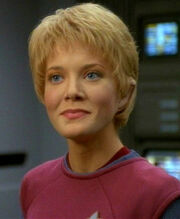
Kes in 2373
Kes was one of The Doctor's first friends on board Voyager and over the course of her stay aboard the ship, the two bonded considerably. Their friendship began early in the first year after Kes displayed great interest in medicine . This interest led The Doctor to commence training her, which brought them close as colleagues. ( VOY : " Phage ") Kes was able to quickly study the works given by The Doctor, which greatly intrigued him. Although The Doctor exhibited a terrible bedside manner and had a personality that wasn't pleasing to the rest of the crew, he reacted more kindly to Kes, treating her as a colleague and friend. ( VOY : " Eye of the Needle ") Kes in turn was always very encouraging of The Doctor, insisting that he was more than a projection and that there was no reason why he could not exceed his original programming. Kes' care for The Doctor evidently had a powerful effect on him; when his program suffered damage in 2372 and he began to hallucinate that he was his creator, Dr. Lewis Zimmerman , his hallucination included a Human Kes as his wife. In that simulation, The Doctor confessed to Kes that he always found her to be beautiful during a time when "Lewis" appeared to be "dying". After The Doctor's program was recovered, he told Kes about his hallucination. Kes promised to keep what he had told her between them in case Neelix found out in another bout of jealousy. ( VOY : " Projections ")
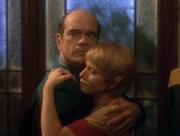
The Doctor comforts Kes in Chez Sandrine
However, romance between the two never developed, and The Doctor and Kes settled into a father/daughter relationship, with The Doctor becoming Kes' teacher and mentor during her time as a medical student and assistant. Kes' trust in The Doctor was so great that she asked him to perform the rolissisin – a ritual usually performed by the daughter's father shortly before conception – on her. ( VOY : " Elogium ")
Kes persuaded Janeway that The Doctor should be given more respect and consideration by granting him some authority over his deactivation code, a significant step towards being regarded as a full member of the crew rather than a piece of equipment. Kes always encouraged The Doctor to embrace and develop his personality, and she helped him become part of the crew. At a time when The Doctor was believed to be nothing but a program based on another program without the capacity of independent decision making, she told him that there was no difference between how he accessed his programs and made decisions for medical treatments and how she, a flesh and blood being, made decisions based on information stored inside her brain . Kes also encouraged him to pick a name and advised him when he had desperately fallen for Danara Pel but did not know how to handle those emotions. All these encouragements helped The Doctor to realize his potential. ( VOY : " Lifesigns ", " The Swarm ")
The next year Kes helped save The Doctor's matrix when, due to his program having been active far longer than it was designed for, he began to lose his memories and skills as a physician. After Torres activated a hologram of Dr. Lewis Zimmerman, he explained that The Doctor had been online too long and was deteriorating. Kes persuaded Zimmerman to graft his matrix onto The Doctor's, restoring his mental capabilities. ( VOY : " The Swarm ")
Later that year, when The Doctor's program developed a secondary, evil personality as a result of his experimenting with his personality subroutines, the "Dark Doctor", despite his deep resentments, still appeared deep down to care for Kes, albeit in a more twisted fashion than the normal Doctor. Not only did he try to kill Zahir , the alien whom Kes had developed feelings for, but he also claimed, during his capture of her, that she needed his help and protection because she was naive. ( VOY : " Darkling ")
In an alternate timeline , The Doctor told Kes that she was the finest friend he ever had. ( VOY : " Before and After ")
Seven of Nine [ ]
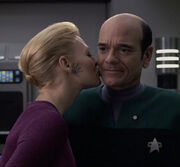
Seven gives The Doctor a friendly kiss
The Doctor was responsible for the removal of Seven's implants and also conducted her weekly maintenance sessions. He also took it upon himself to teach Seven social behavior, using the same interpersonal relationship exercises Kes once practiced with him. ( VOY : " Prey ") Later, he created a holodeck simulation of Voyager for her to become more comfortable with large social gatherings. ( VOY : " One ")
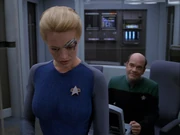
Seven of Nine and The Doctor discussing Species 8472
The Doctor encouraged Seven to explore romantic relationships in 2375 . He coached her in the basics of dating and grooming, using a lesson plan entitled " Love Amid the Stars ". He also discovered her singing voice and the two sang a duet of " You Are My Sunshine ". He was partially motivated by a wager made with Ensign Paris, who believed that Seven would not be able to bring a date to a reception planned aboard Voyager without making a scene. Although Seven's date with Lieutenant Chapman ended in disaster, she attended the reception with The Doctor and charmed the guests with a toast to individuality. However, she was hurt to discover that The Doctor's help was due to the bet. At this point, The Doctor found himself falling in love with Seven but refused to admit it to her. He tried to apologize to her but she came to him first and said she no longer needed the lessons in romance, because there were no suitable mates aboard. The Doctor was very disappointed that Seven did not reciprocate his feelings. ( VOY : " Someone to Watch Over Me ")
In 2376 , while The Doctor was stranded aboard the USS Equinox along with Seven, the crew disengaged his ethical subroutines to extract activation codes for their warp drive from Seven's cranial implants, which would leave her mentally disabled. The Doctor almost went through with the procedure, but Captain Rudolph Ransom stopped him. He apologized to Seven for the incident and she held no ill will towards him. ( VOY : " Equinox, Part II ")
The Doctor created a subroutine for daydreaming in early 2376 . Seven featured prominently in several fantasies, either serving as a damsel in distress or competing with other female Voyager crew members for The Doctor's affections. He even fantasized about painting her in the nude. When the fantasies began to overrun his program, his mental activity was tied into the holodeck, allowing Seven to see what he had been daydreaming. She did not take offense but after she kissed him following Captain Janeway's announcement that the Emergency Command Hologram subroutines would be developed, she made it clear that it was simply a platonic gesture. ( VOY : " Tinker Tenor Doctor Spy ")
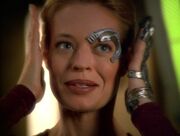
The Doctor as Seven of Nine
While Ensign Kim, Seven, and The Doctor conducted a routine survey on board the second Delta Flyer in 2377 , they were captured by a race known as the Lokirrim . The Lokirrim had waged war against holographic lifeforms who rebelled against Lokirrim rule, and as a result they banned all holographic activity within their borders. Seven transferred The Doctor's program to her cortical implant in order to hide him from the Lokirrim and prevent him from being decompiled. In the process The Doctor took control of Seven's motor abilities and was essentially trapped in her body. The Doctor tried to engineer an escape by cultivating a relationship with a Lokirrim official, Ranek , but the new sensations of taste and emotion were too tempting for The Doctor. He ended up overindulging in several foods and causing pain to Seven. Ranek later called Seven to the ship's bridge with the intention of setting up a romantic liaison. Although The Doctor was able to see his command codes, Ranek attempted to kiss him in Seven's body. Shortly afterward, he went to complain about the incident to Jaryn , a crewwoman with whom The Doctor had been working to treat injured Lokirrim crew. The Doctor became sexually aroused when Jaryn gave Seven a neck massage. Both incidents greatly irritated Seven, and once he had been returned to the mobile emitter, they got into an argument about the value of indulgence. The Doctor felt Seven showed excessive restraint and did not allow for superfluous pleasure, which he believed was an important part of life. Kim managed to return the subject to escape, and The Doctor and Seven worked together once again to transmit a distress signal to Voyager . The Doctor was downloaded back into Seven's implants and was able to convince Ranek to join her on a second date. They knocked him out at the first available opportunity and transmitted a message to Voyager including the ship's command codes. Their plan was discovered by Jaryn and Seven was taken captive. After Voyager arrived, Seven returned The Doctor's program to the mobile emitter and they escaped. Upon their return to the ship, Seven decided that The Doctor had a point about her restraint concerning pleasures such as food. She brought a meal to sickbay and described the sensations of eating it to him, allowing him to experience it vicariously. ( VOY : " Body and Soul ")
When The Doctor's rights as an individual came into question, Seven testified at the hearing conducted with Starfleet Command. She spoke highly of The Doctor, appreciative of his efforts to help her develop individuality. ( VOY : " Author, Author ")
In 2378 when The Doctor believed he was about to die, he finally admitted his feelings for her and was embarrassed when he survived. ( VOY : " Renaissance Man ") The Doctor was also crestfallen when he learned Seven had begun to date Chakotay. ( VOY : " Endgame ")
Tom Paris [ ]
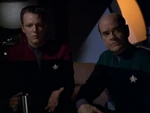
Tom Paris and The Doctor
Although their relationship was often a difficult one, The Doctor also managed to become close friends with Paris, who affectionately referred to The Doctor as "Doc" on several occasions. One of the key points in their friendship was the fact that it was Paris who helped The Doctor explore one of the most difficult aspects of being a member of the crew: relationships. When The Doctor was initially rejected by Danara Pel , he went to Paris for relationship advice and Paris helped set The Doctor and Denara up on a date in a holoprogram, informing The Doctor that his current approach to women was all wrong. ( VOY : " Lifesigns ") When The Doctor created a holographic family and one of his 'children' faced death after an accident, it was Paris who convinced The Doctor to keep running the program rather than shut it down, realizing that The Doctor needed to experience the negative aspects of family life if he wanted to develop as a person. ( VOY : " Real Life ")
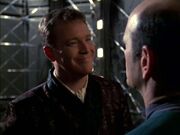
Paris turns the tables on The Doctor in his version of Photons Be Free
After Kes' departure from the ship, Paris was chosen as The Doctor's new medical assistant, serving as Voyager 's CMO when The Doctor was unavailable. Over time it became clear that, although he complained about the role, he still wanted The Doctor's respect as a person. This was the main reason Paris resented The Doctor's holonovel about abused holograms, Photons Be Free ; he worried that 'his' character, a womanizer called Lieutenant Marseilles who cheated on his wife, reflected how The Doctor saw him . Despite this, when the crew arranged a trial to determine The Doctor's legal rights after his publisher released the novel ahead of schedule, Paris objected to Tuvok 's suggestion that they claim that The Doctor had no right to sell the holonovel in the first place, as they would basically have been admitting that The Doctor was not a real person. ( VOY : " Author, Author ")
Kathryn Janeway [ ]
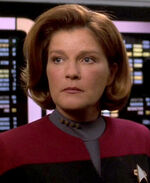
Captain Janeway
As the crew's journey unfolded, Janeway soon found herself becoming friends with The Doctor, despite initially regarding him as just another hologram. The Doctor also initially disliked Janeway, making several notes on what he regarded as her more "questionable" command decisions before he fully came to regard himself as part of the crew. As the journey unfolded however, the two of them became closer, particularly when Janeway and The Doctor were the only two crew members standing between Voyager and the macrovirus that was attacking the ship. ( VOY : " Macrocosm ")
As the journey went on, the two of them also began to develop an almost mother/son relationship, with The Doctor often coming to Janeway when he needed personal advice or information about how his program was developing, as well as consolation about any wrong decisions he had made in recent times. Janeway stopped The Doctor from deleting the additional subroutines that made him unique when he felt responsible for a death. ( VOY : " Retrospect ") Janeway assured The Doctor that none of the crew thought any less of him when he was embarrassed about the fantasies created by his daydream program, ( VOY : " Tinker Tenor Doctor Spy ") and Janeway told The Doctor that none of the crew blamed him for betraying them to try and help a crew of holograms. ( VOY : " Flesh and Blood ") As well as that, when Janeway faced death after being captured by an alien species, The Doctor risked everything to save her. ( VOY : " Renaissance Man ") When The Doctor's legal rights were questioned after his holo-novel was released ahead of schedule before he had the chance to make edits, Janeway spoke in his defense at the subsequent hearing, citing his defiance of her orders as proof that he had grown beyond his original programming where he would do nothing but follow orders, affirming that she considered him a friend as well as a member of her crew. ( VOY : " Author, Author ")
B'Elanna Torres [ ]
Although their two-way doctor/patient relationship (The Doctor treating Torres' injuries while Torres "treated" any damage sustained by his program) could be difficult at times, The Doctor and B'Elanna Torres went on to develop a surprising friendship and working relationship, such as when the two brainstormed possible solutions to help reactivate Automated Unit 3947 when he was recovered and his power was running out. Torres also helped The Doctor gain a better understanding of his new mobile emitter after he acquired it, clearly expressing her fascination with the new technology. A particularly dark period for the two was when The Doctor attempted to remove a cytoplasmic lifeform from Torres using knowledge acquired from the hologram of Crell Moset , a Cardassian doctor who had committed various war crimes. Although Torres' feelings were hurt when The Doctor dismissed her musical opinions while preparing to give a concert for the Qomar, she later convinced him not to reprogram himself to reach the high notes achievable by the Qomar's new hologram because he would be sacrificing his identity for others if he tried to reprogram himself in that manner. Their relationship became so close that, when Torres learned that she was pregnant, she asked The Doctor to be the child 's godfather, and even when faced with the possibility that she could give birth to the child on Earth in Starfleet Medical, she made it clear that she wanted The Doctor to be the supervising physician rather than some stranger. ( VOY : " Prototype ", " Future's End, Part II ", " Nothing Human ", " Virtuoso ", " Lineage ", " Endgame ")
Romance [ ]
Danara pel [ ].
In 2372 , The Doctor encountered the Vidiian Doctor Danara Pel and developed romantic feelings for her. She gave him the name Shmullus , after her uncle who always made her smile. When they met again later that year, Denara again called The Doctor "Shmullus," although he never used the name despite his fondness for it. ( VOY : " Lifesigns ", " Resolutions ")
Mareeza [ ]
Four years later, Voyager became trapped in orbit around a planet where time advanced at a much faster rate than normal. The Doctor determined that the transition into this accelerated timeframe could be fatal to a humanoid and so volunteered to transport to the surface himself. It was intended that he would only spend three seconds on the planet which equated to around two days on the surface but attempts to transport him back to Voyager failed. Chakotay guessed that The Doctor would spend his time in the city's cultural center and he was located a short time after being transported down. However, to The Doctor, he had spent three years on the surface. He met a woman named Mareeza , whom he later described as his "roommate", and had a son named Jason Tabreez . ( VOY : " Blink of an Eye ")
Alternate Doctors [ ]
Holographic recreations [ ].
The Doctor was holographically duplicated on a number of occasions.
- The entire crew of Voyager was recreated by Tuvok from his Insurrection Alpha program, including The Doctor. ( VOY : " Worst Case Scenario ")
- Harry Kim attempted to recreate the Doctor when he was transmitted to the USS Prometheus in 2374 , but the new program, identified as the Emergency Medical Hologram Replacement Program , was unable to function properly and it collapsed. ( VOY : " Message in a Bottle ")
- Reginald Barclay recreated The Doctor in 2376. ( VOY : " Pathfinder ")
- Various miniature copies of The Doctor were created by the Qomar due to their admiration for The Doctor's singing. ( VOY : " Virtuoso ")
- Harry Kim and Seven of Nine projected The Doctor's daydreams into the holodeck in order to better understand what was malfunctioning. In this daydream, The Doctor wore a painter's smock and beret while he painted a holographic representation of Seven in the nude. ( VOY : " Tinker Tenor Doctor Spy ")
- After he stole The Doctor's program, Gar left a copy – created from one of The Doctor's old training files – aboard the starship to cover his tracks. ( VOY : " Critical Care ")
- In 2378 , Seven recreated the crew of Voyager to perfect her social skills, including The Doctor. ( VOY : " Human Error ")
- The Doctor served as the narrator of his own holonovel , Photons Be Free , set aboard the USS Vortex , which was based on the crew of the USS Voyager , albeit the names were changed to protect the innocent. ( VOY : " Author, Author ")
- A holodeck recreation of The Doctor by Tom Paris in his rendition of the holonovel Photons Be Free in 2378. ( VOY : " Author, Author ")
Alternate realities and timelines [ ]
Dr. van gogh [ ].
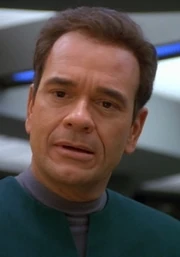
In the possible future that Kes experienced when she began to travel backwards in time, The Doctor was offline for months during the " Year of Hell " conflict. When his program was restored, The Doctor developed a full head of hair, chose the name "Doctor Van Gogh" (although he briefly thought about calling himself Mozart) and tried to develop a means of extending Kes' life via use of a bio-temporal chamber which triggered her jumps back through time. Subsequently – or previously, depending on perspective – The Doctor of the present cured her of her sudden jumps back in time and this timeline never came to pass. ( VOY : " Before and After ")
Voyager crashed [ ]
In an alternate timeline where Voyager crashed into an ice planet while attempting to reach Earth via the use of a quantum slipstream drive, The Doctor's program was recovered fifteen years later by Chakotay and Harry Kim, who had been in the Delta Flyer when the crash took place, the two managing to reactivate sickbay's holographic emitters long enough to transfer the Doctor into his mobile emitter. Though at first reluctant due to the Temporal Prime Directive , The Doctor agreed to help as he wanted his friends to survive as well. With The Doctor's help, they managed to devise a means of transmitting information back in time to Seven of Nine's cortical implant before Voyager was destroyed, hoping to save the crew by stabilizing the slipstream and allowing them to reach Earth. After the attempt failed, it was The Doctor who made a tearful, defeated Kim realize that Voyager 's salvation lay outside the slipstream, and to use the link to end the flight rather than prolong it; if they couldn't get Voyager home, they could at least save the ship and her crew. With the Flyer 's warp core about to breach and rapidly running out of power to send the data, The Doctor volunteered the use of his emitter as a power source. Kim wished The Doctor goodbye before removing the emitter. This timeline was erased when Kim, moments before the Flyer exploded, successfully transmitted the data to Seven of Nine that would shut down the slipstream drive, with a message from Harry to his past self the only trace left of that history. ( VOY : " Timeless ")
Shattered Voyager [ ]
When Voyager was fractured into multiple different time periods, sickbay reverted to stardate 49624, a year prior to the acquisition of the mobile emitter. Despite his relative "youth", The Doctor of this time period was able to devise a chroniton-infused serum that would stabilize the temporal instability experienced by Commander Chakotay after the initial accident, as well as allow him to travel between the fractured time periods of the ship. Once he learned what had happened from Chakotay, The Doctor provided him with more samples of the serum, allowing Chakotay to "recruit" Janeway from a time before Voyager was sent to the Delta Quadrant, with this Janeway being surprised when she met The Doctor and witnessed his level of development compared to the original EMH program. When Chakotay's plan was able to undo the original accident, the timeline was altered so that The Doctor never experienced these events. ( VOY : " Shattered ")
Original 25th century [ ]
In the aborted timeline where Voyager took twenty-three years to return to the Alpha Quadrant, two weeks prior to the ten-year anniversary of the ship's return, The Doctor married a Human woman named Lana and even took the name of her grandfather, Joe . He remained the personal physician of Admiral Janeway, who credited her fine health to his exceptional care over the years, and continued to visit Tuvok to monitor his neural degradation. ( VOY : " Endgame ")
Memorable quotes [ ]
" Please state the nature of the medical emergency. "
" Doesn't anyone know how to turn off the program when they leave?!? "
" It seems I've found myself on the Voyage of the Damned. "
" Who would have thought that this eclectic group of voyagers could actually become a family? Starfleet , Maquis , Klingon , Talaxian , Hologram , Borg , even Mr. Paris... "
" The computer sounds like it needs a stimulant. "
" Sticks and stones won't break my bones, so you can imagine how I feel about being called names. "
" Activate the photonic cannon . "
" Interesting sensation blowing one's nose; it's my first time."
" "I've reconfigured The Doctor's optical sensors and as soon as they're aligned he should be able to detect the microwave signature of the portals. " " Then I can begin my new career as a tricorder. "
" What did he ingest? " " Just a cup of Neelix' coffee. " " It's a miracle he's still alive.... "
" You claim that you're my friend but you don't even call me by my name. " " That's because you don't have a name. " " No name? That's ridiculous! I'm… My… I demand you tell me my name! "
" I'll go first, captain, and draw their fire if need be. " " Your crew is heroic, captain. " " I just happen to be invulnerable to phaser fire, but I appreciate the compliment. Captain? " " Go. "
I'm a doctor, not a... [ ]
- " I'm a doctor, Mr. Neelix , not a decorator. " ( VOY : " Phage ")
- " I'm a doctor, not a bartender . " ( VOY : " Twisted ")
- " I'm a doctor, not a voyeur. " ( VOY : " Parturition ")
- " I shouldn't have to remind you: I'm a doctor... "
- " I'm a doctor, not a performer. " ( VOY : " Investigations ")
- " I'm a doctor, not a counterinsurgent. " ( VOY : " Basics, Part II ")
- " I'm a doctor, not a database . "
- " I'm a doctor, not a peeping Tom; there's nothing I haven't seen before. " (when catching Lt. Torres in the sonic shower) ( VOY : " Drone ")
- " I'm a doctor, not a battery. " ( VOY : " Gravity ")
- " I'm a doctor, not a dragonslayer . " ( VOY : " Bliss ")
- " I'm a doctor, not a zookeeper. " ( VOY : " Life Line ")
- " I'm a doctor, not an engineer. " ( VOY : " Flesh and Blood ")
Appendices [ ]
Appearances [ ].
- " Caretaker "
- " Parallax "
- " Time and Again "
- " The Cloud "
- " Eye of the Needle "
- " Ex Post Facto "
- " Emanations "
- " State of Flux "
- " Heroes and Demons "
- " Cathexis "
- " Learning Curve "
- " The 37's "
- " Initiations "
- " Projections "
- " Elogium "
- " Twisted "
- " Parturition "
- " Persistence of Vision "
- " Cold Fire "
- " Maneuvers "
- " Prototype "
- " Alliances "
- " Threshold "
- " Dreadnought "
- " Death Wish "
- " Lifesigns "
- " Investigations "
- " Deadlock "
- " Innocence "
- " The Thaw "
- " Resolutions "
- " Basics, Part I "
- " Basics, Part II "
- " Flashback "
- " The Chute "
- " The Swarm "
- " False Profits "
- " Remember "
- " Sacred Ground "
- " Future's End "
- " Future's End, Part II "
- " Warlord "
- " The Q and the Grey "
- " Macrocosm "
- " Fair Trade "
- " Alter Ego "
- " Blood Fever "
- " Darkling "
- " Favorite Son "
- " Before and After "
- " Real Life "
- " Distant Origin "
- " Displaced "
- " Worst Case Scenario "
- " Scorpion "
- " Scorpion, Part II "
- " The Gift "
- " Nemesis "
- " Revulsion "
- " The Raven "
- " Scientific Method "
- " Year of Hell "
- " Year of Hell, Part II "
- " Random Thoughts "
- " Concerning Flight "
- " Mortal Coil "
- " Waking Moments "
- " Message in a Bottle "
- " Hunters "
- " Retrospect "
- " The Killing Game "
- " The Killing Game, Part II "
- " Vis à Vis "
- " The Omega Directive "
- " Unforgettable "
- " Living Witness "
- " Hope and Fear "
- " Extreme Risk "
- " In the Flesh "
- " Once Upon a Time "
- " Timeless "
- " Infinite Regress "
- " Nothing Human "
- " Thirty Days "
- " Counterpoint "
- " Latent Image "
- " Bride of Chaotica! "
- " Gravity "
- " Dark Frontier "
- " The Disease "
- " Course: Oblivion "
- " The Fight "
- " Think Tank "
- " Juggernaut "
- " Someone to Watch Over Me "
- " Relativity "
- " Warhead "
- " Equinox "
- " Equinox, Part II "
- " Survival Instinct "
- " Barge of the Dead "
- " Tinker Tenor Doctor Spy "
- " Riddles "
- " Dragon's Teeth "
- " One Small Step "
- " The Voyager Conspiracy "
- " Pathfinder "
- " Fair Haven "
- " Blink of an Eye "
- " Virtuoso "
- " Memorial "
- " Tsunkatse "
- " Collective "
- " Spirit Folk "
- " Ashes to Ashes "
- " Child's Play "
- " Good Shepherd "
- " Live Fast and Prosper "
- " Life Line "
- " The Haunting of Deck Twelve "
- " Unimatrix Zero "
- " Unimatrix Zero, Part II "
- " Imperfection "
- " Repression "
- " Critical Care "
- " Inside Man "
- " Body and Soul "
- " Flesh and Blood "
- " Nightingale "
- " Shattered "
- " Lineage "
- " Repentance "
- " Prophecy "
- " The Void "
- " Workforce "
- " Workforce, Part II "
- " Human Error "
- " Author, Author "
- " Friendship One "
- " Natural Law "
- " Homestead "
- " Renaissance Man "
- " Endgame "
Background information [ ]
The Doctor was played by actor Robert Picardo . The part of The Doctor disguised as a Hierarchy overlooker, in the episode " Renaissance Man ", was played by J.R. Quinonez (see also: Roles with multiple performers ).
The Doctor was created with the intention of essentially being an "outsider" who could comment on Humanity from that perspective, much like how Spock , Data and Odo had been established in Star Trek: The Original Series , Star Trek: The Next Generation , and Star Trek: Deep Space Nine respectively. ( A Vision of the Future - Star Trek: Voyager , pp. 167-168)
An early reference to the character concept that eventually became The Doctor was included in a series of notes that Executive Producer and Star Trek: Voyager co-creator Jeri Taylor wrote on 30 July 1993 . The reference was listed among other subjects which had been covered during one of many developmental discussions she had with fellow Executive Producers Michael Piller and Rick Berman about the series (which was yet to be named). Specifically, this list included a mention of "Holo-Moriarty", referencing the Moriarty hologram from the Star Trek: The Next Generation episodes " Elementary, Dear Data " and " Ship In A Bottle ". ( A Vision of the Future - Star Trek: Voyager , pp. 175 & 179)
In another compilation of notes Jeri Taylor wrote a week later (on 3 August 1993 ), she included an outline of the character in a section titled "The Crew". The outline stated, " Holo-Doctor –A Human or alien male or female (possibly Vulcan?) The medical officer of the ship is killed during the mission; remaining is the holographic character of the doctor who, like Moriarty, has 'awareness' of himself as a holodeck fiction. He longs for the time when he can walk free of the Holodeck. (Some discussion about the fact that one of the crew must become a 'student' of this doctor. Maybe one of the misfits [i.e., a Maquis] had been kicked out of medical school.) " ( A Vision of the Future - Star Trek: Voyager , pp. 175, 176 & 177)
At this point, the three executive producers liked the concept of the doctor character. They therefore considered how they could explain or justify, in a way that would be sufficiently credible to the viewers, the character's existence, if he was to be a holographic yet sentient being, so that it fit with what had previously been established. This was evident in another summary of Jeri Taylor's notes, this time dated 6 August 1993. Reporting more character development for The Doctor, the document stated, " The Holo-Doctor represents a new, state-of-the-art technology which has capitalized on the serendipitous incident which created Moriarty, and has programmed a holographic character which has self-awareness of his situation and limitations. " As the notes continued, they clarified that the team of series co-creators had discussed the idea that The Doctor had been made "a bit bland" when his programmer had created him, leading one of the "misfits" (a conn officer, who ultimately developed into the character of Chief Engineer B'Elanna Torres) to decide to tweak his personality programming during the mission. The team had also considered that the hologram may have been created by Reginald Barclay , designed in his own image, and that, while taking a leave of absence in an upcoming TNG episode , he could put "the polishing touches" to the program. ( A Vision of the Future - Star Trek: Voyager , pp. 182 & 183)
In several early first-season Star Trek: Voyager scripts, call sheets, and shooting schedules and during the pre-production phase, the character of The Doctor was referred to by name as "Doc Zimmerman" after Herman Zimmerman , since the show's producers had not yet decided to leave him unnamed. ( VOY Season 2 DVD trivia text version of " The 37's " ) His initial description in the script for VOY : " Caretaker " originated this routine, as The Doctor was therein initially referred to " as a holographic man in a Starfleet medical uniform […] He has no name for now… but we will get to know him in time as Doc Zimmerman. His manner is colorless, dry. " The character continued to be referred to as having the name "Zimmerman" in all the scripts which were written for the series' first season, and "Zimmerman" was reported to the public as the character's name in press materials during the series' initial production run. Robert Picardo claimed in October 2022 that it was his decision to rename the character in the credits, with a view to the Doctor choosing the name "Doc Zimmerman" in a later episode. [1]
As a continued in-joke and reference to the character's original name, the terms "zimmers in" and "zimmers out" were used behind the scenes and in stage directions to refer to the distinctive effect of the Doctor's materialization into and dematerialization out of a scene. ( Star Trek: Voyager Companion , p. 176)
In the special features on the Voyager DVD collection, Robert Picardo mentions that he ad-libbed during his audition for the role of The Doctor, adding the line, " I'm a doctor, not a lightbulb " at the end of his script; he says that he "got a laugh" from the assembled studio executives, even though ad-libbing isn't something that's generally done on a Star Trek production.
It was only once the scripts started to be written for VOY Season 2 that this character became officially known as "The Doctor". He is one of two ongoing characters in science fiction who are referred to by this title, as opposed to a proper name; the other is the protagonist of the long-running British television series Doctor Who .
Many people, including Robert Picardo himself, were initially opposed to Brannon Braga 's idea of the mobile emitter, believing The Doctor's limitations to be one of the appeals of the character. However, Picardo ultimately relished the opportunities for growth of his character due to The Doctor's newfound mobility, without noticing any negative impact to his appeal to the fans ; Picardo subsequently apologized to Braga. ( Star Trek: Voyager Companion , p. 452)
Many fans have wondered if Robert Picardo actually did all of his singing himself. To answer that question, Picardo said, " I did all of my singing except for the second half of 'Virtuoso'. The Don Carlo duet and Rondine al Nido are voiced by an opera singer, Augostino Castellnano (I hope I spelled that correctly). He's a terrific guy. I simply couldn't sing high enough or well enough to pull them off, but I did my own singing in 'The Swarm', 'Tinker, Tenor...', 'Renaissance Man', 'Someone to Watch Over Me' and all the others. " [2] (X)
Robert Picardo also appeared as The Doctor in "Borg Invasion 4D" at Star Trek: The Experience and also portrayed other EMHs in Star Trek: First Contact , DS9 : " Doctor Bashir, I Presume ", and VOY : " Author, Author ".
Apocrypha [ ]
Robert Picardo has written a book based on and as told by his character, named The Hologram's Handbook . Picardo goes into depth about how he felt about various experiences while aboard Voyager , such as feeling "betrayed" by Kes when she extended the length of his bout with the flu, as well as genuine and helpful advice for any holograms finding it hard to fit in with 'organics'.
In Star Trek: Voyager - String Theory : Evolution , The Doctor is sent into Ocampa's distant past by a Nacene, which transfers him into the body of a recently-deceased Ocampan soldier, allowing him to experience the sensations of an organic body for the first time, although the conditions are so harsh that he cannot fully enjoy the experience. He is eventually returned to his time after meeting with Kes to oversee the birth of an Ocampan/Nacene hybrid.
In the Voyager relaunch book series, The Doctor became a famous proponent of holographic rights and eventually joined a Federation "think tank" with Seven of Nine. Following the events of the Destiny trilogy, The Doctor became chief surgeon of the Project Full Circle fleet, returning to the Delta Quadrant on a specialized medical ship he assisted in designing. He is subsequently the first member of the original Voyager crew to greet the resurrected Admiral Kathryn Janeway when she is restored to life by Q and Kes in The Eternal Tide . Following the discovery that Seven had formed a relationship with the Full Circle fleet's new counselor, The Doctor was reprogrammed by Zimmerman to move on from his old feelings for her, Zimmerman arguing that he was just accelerating the process of recovery that The Doctor would have gone through on his own, ( Protectors ) but a later attempt to defeat an alien life form forces The Doctor to trap the entity in a part of his program and erase his memories of Seven, leaving him unable to even recall most of the time they have spent together. ( Atonement )
In the "Borg Invasion 4D" attraction at Star Trek: The Experience , The Doctor is the lead physician on board Copernicus Station on the edge of the Alpha and Delta Quadrants. While testing a group of people (the audience members) whose DNA apparently resists Borg nanoprobes, the station comes under assault by the Borg themselves. After the group of hopefuls is captured and in the process of assimilation, The Doctor breaks through the hallucination that the Borg Queen is projecting and informs them that help is on the way. Minutes later, Admiral Kathryn Janeway and the USS Voyager rescue the group and bring them back to safety. The story is helped by interactive 3D projections and real live actors. In the video segments, Robert Picardo reprises his role as The Doctor, as do Kate Mulgrew and Alice Krige for Admiral Janeway and the Borg Queen, respectively.
The Doctor (voiced by Robert Picardo) is one of several Voyager cast members who reprise their roles in the Delta Rising expansion of Star Trek Online , along with Tim Russ (Tuvok), Ethan Phillips (Neelix), Garrett Wang (Harry Kim), Jeri Ryan (Seven of Nine), and later Robert Duncan McNeill (Tom Paris). Players meet The Doctor several times as they explore the Delta Quadrant thirty years after Voyager first explored the region.
External links [ ]
- Doctor (Star Trek: Voyager) at Wikipedia
- The Doctor at Memory Beta , the wiki for licensed Star Trek works
- The Doctor at the Star Trek Online Wiki
- 1 Daniels (Crewman)
- 3 Jamaharon
Star Trek: Voyager Followed A Gene Roddenberry Rule That Left Little Room For Error
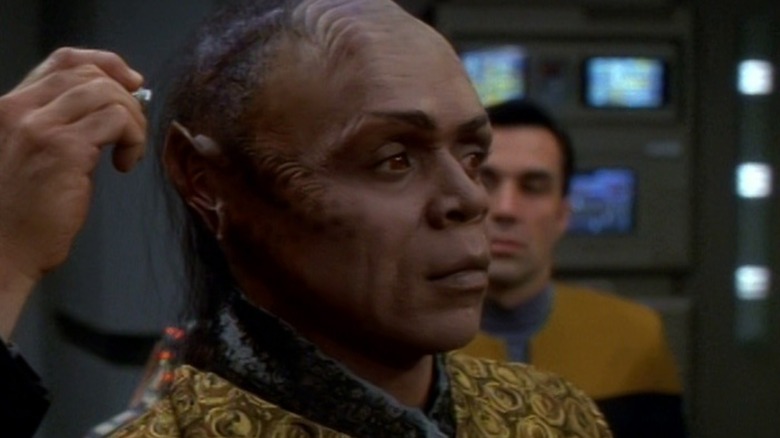
In the "Star Trek: Voyager" episode "Tuvix" (May 6, 1996), a transporter accident fused the stern, logical Vulcan Tuvok (Tim Russ) with the jolly hobbit-like chef Neelix (Ethan Phillips) into a single being. This new being, who says he's named Tuvix (Tom Wright) possesses memories and personality traits from both Tuvok and Neelix, which is a matter of great consternation from Captain Janeway (Kate Mulgrew) and the crew of the Voyager. Tuvix soon finds that he likes his new amalgam personality, finding happiness and agency as an individual.
Soon, however, the Voyager engineers find a way to reverse the effects of the transporter accident and separate Tuvix back into his two constituent beings. Tuvix objects, of course. To do so would mean to murder him. Surely a newly created person has rights just as much as any other member of the crew, and Tuvix would like them to be protected. Notoriously among Trekkies, however, Janeway ordered Tuvix to the transporter room for execution, with Tuvix protesting all the way. Janeway figures that restoring two dead crewmates outweighs the pleas of a living one. Tuvix never returned.
In addition to playing Tuvix, actor Tom Wright also played an alien named Ghrath who disguised himself as a Nazi in the "Star Trek: Enterprise" episode "Storm Front" (October 8, 2004). He also auditioned for the role of Commander Sisko on "Star Trek: Deep Space Nine." Back in 2014, Wright took to Reddit to answer questions from Trekkies . He revealed that "Voyager" had a stringent and difficult-to-follow rule on set that lingered from the days of "Star Trek" creator Gene Roddenberry (who passed in 1991). It seems that, on "Star Trek," actors are not allowed to forget lines or make flubs. Every scene must play all the way through.
The Roddenberry rule
Wright began acting professionally in the late 1970s, first appearing in the film "Deadbeat." He appeared in supporting roles in films like "Underground U.S.A." and "The Brother from Another Planet," as well as in notable genre movies like "Exterminator 2" and "Creepshow 2," in which he played the increasingly mutilated hitchhiker. He had roles in "Matewan," "Reversal of Fortune," and "Marked for Death." He turned up in a 1991 episode of "Tales from the Crypt" and played the role of Mr. Morgan in four episodes of "Seinfeld." For many years, audiences of the '80s and '90s could count Wright as one of the more ubiquitous "hey, it's that guy" supporting actors; that is: an actor you love and instantly recognize, but who never gets top billing.
Despite a thriving career, Wright saw his appearance on "Star Trek: Voyager" as a step up. He was grateful for his involvement in such a widespread phenomenon as "Star Trek," and was willing to play Tuvix to the best of his abilities. As he revealed, though, it also came with an additional Roddenberrian acting challenge. There was to be no "shooting around" any misreadings or forgotten lines. Wright wrote:
"It was my welcome to the BIG LEAGUES moment. I don't know about the other shows but Voyager was shot alongside the dictates of The Roddenberry Bible. You probably know all about it but for the sake of clarity, Gene Roddenberry compiled a set of 'Star Trek' guidelines and principles that governed the 'Star Trek' universe. One of the major tenets was that not only should actors KNOW their lines but if they were to make a mistake, there would be no continuing the scene."
Perhaps Roddenberry wanted "Star Trek" actors to feel like they were involved in live theater.
The live theater approach to shooting 'Star Trek'
Wright didn't mind the live theater atmosphere on the set, as he had already appeared on stage many times before. He continued:
"Normally if you flub a line you can stop, take a breath, and then restart from where you made a mistake. But Gene was old school and held his actors to a higher standard. We were not allowed to simply stop and pick up, We had to go back to the beginning of the scene and do it properly. Me, having been trained in the theater, LOVED THAT. He made us more responsible to the writing."
Anyone who has worked on a TV set can tell you that the script is not to be deviated from. "Star Trek" famously filmed on a fast schedule, churning out an episode every week. Scripts had to be polished to a shine, and actors had to have their lines 100% memorized. This included the strange pseudo-science and multisyllabic technobabble that the franchise was famous for. Wright knew from working in film that an actor can mess up a line, but then merely re-read it on the spot, and not cause any interruptions. An editor could conceivably cut the flub out, and leave the re-read in. Perhaps the "once through" approach to "Star Trek" was merely to keep the editing process clean; it would be easier to assemble a scene in post-production if there was no worry about editing out flubs.
Wright, ever a professional, seems to have rolled with the Roddenberry rule with aplomb.
Wright continues to work to this day, having most recently appeared in "Daisy Jones & the Six" and the 2022 film "That's Amor."

Star Trek: Discovery Ends With 1 Last Spore Drive Mystery
- Spore drive mystery left unresolved in Star Trek: Discovery finale. Who is now navigating the USS Discovery?
- Stamets may have returned as the navigator, using genetic engineering for the spore drive.
- Captain Leto Burnham, with Kwejian empathy, could also be steering the ship through the mycelial network.
WARNING: Contains SPOILERS for the Star Trek: Discovery series finale, "Life, Itself"
Star Trek: Discovery ends with one more spore drive mystery that remains unanswered. In the epilogue of Star Trek: Discovery 's series finale , "Life, Itself", which takes place 30+ years later, the USS Discovery is still using the spore drive to jump to the location of Zora's (Annabelle Wallis) final mission in deep space. Discovery's spore drive was a boon to the reduced 32nd-century United Federation of Planets, broken after the Burn destabilized the galaxy's dilithium. As a potential alternative to warp drive throughout Starfleet, however, the spore drive came up against one major problem that prioritized the development of the pathway drive instead : the need for a sentient navigator connected to the mycelial network.
For most of Star Trek: Discovery , the only reliable navigator for the USS Discovery spore drive was its inventor, Commander Paul Stamets (Anthony Rapp), who integrated tardigrade DNA with his own to establish a connection to the spores that guided the USS Discovery through the mycelial network. Later, Cleveland Booker (David Ajala) discovered that natural Kwejian empathy gave Book a connection with Discovery's spores, making Book an effective backup navigator. Only tardigrade DNA or natural empathy makes a reliable spore drive navigator, but genetic engineering is illegal in the Federation, and Kwejian was destroyed, so who is operating the USS Discovery spore drive in Star Trek: Discovery 's epilogue? Here are two possibilities.
Star Trek: Discoverys Spore Drive - How It Works & Why Its Controversial
Star Trek: Discovery introduced the spore drive as a new form of propulsion for starships, but the advanced technology comes with controversy.
Commander Paul Stamets Came Back As USS Discovery's Spore Drive Navigator
Could stamets' genetic engineering create more navigators.
The most likely answer to Star Trek: Discovery 's finale question about the spore drive is that Paul Stamets returned to the USS Discovery for Zora's final mission, just as Admiral Michael Burnham (Sonequa Martin-Green) did. Burnham is alone on Discovery's bridge, due to the sensitive nature of Zora's Red Directive mission , but the Admiral also tells Zora that the rest of the USS Discovery crew will leave her once they reach their mystery destination. Although Paul Stamets isn't named outright in the Star Trek: Discovery epilogue, Stamets could easily be off-screen in Engineering and preparing for a Black Alert in the spore drive's navigation chamber, just like old times.
Commander Stamets is considered a "scientific luminary" in Star Trek: Discovery for his breakthrough work with the spore drive, not to mention Stamets' tardigrade DNA splicing that allowed himself to become the spore drive's navigator. While genetic engineering is outlawed by the Federation in Star Trek until the 25th century, nothing has been said in Star Trek: Discovery 's later seasons about a genetic engineering ban still being in place. The fact that Starfleet considered the spore drive a viable warp replacement, even briefly, suggests that bans on DNA manipulation were lifted, so if additional navigators for the spore drive were created, anyone with tardigrade DNA could be Discovery 's epilogue navigator.
Star Trek: Strange New Worlds season 2, episode 2, "Ad Astra Per Aspera", and Star Trek: Deep Space Nine season 5, episode 16, "Dr. Bashir, I Presume", imply that an outright ban on genetic engineering isn't the ethical choice that the Federation thinks it is.
Captain Leto Burnham Could Have Inherited Kwejian Empathy To Navigate USS Discovery's Spore Drive
Empaths are natural spore drive navigators.
Star Trek: Discovery 's epilogue introduces a new character who might have the ability to navigate the USS Discovery's spore drive: Captain Leto Burnham (Sawandi Wilson), the son of Cleveland Booker and Michael Burnham. Book's Kwejian empathy allows him to communicate with the spores and navigate the mycelial network, so if Leto inherited Kwejian empathic abilities from his father, Book, the new Captain Burnham might have been the USS Discovery's spore drive navigator. Being half-Kwejian and half-human, Leto Burnham's potential for empathy isn't guaranteed, but Book wasn't the last Kwejian, either. Any Kwejian survivors, or other empaths, like Betazoids, could be navigating Discovery.
Just as warp engines require dilithium, which is in short supply after the Burn, the USS Discovery's spore drive requires either a genetically-enhanced person, like Stamets, or a person with natural empathy, like Book . It's possible new technology might have even made the need for a navigator obsolete, decades after Starfleet rejected the spore drive as a faster-than-light alternative to replace standard warp drive. Because the spore drive is Stamets' creation, however, it would be entirely appropriate, and altogether likely, that Paul Stamets returned to the USS Discovery to resume duty as the navigator for the USS Discovery's final spore jump in the epilogue of Star Trek: Discovery .
Cast Blu del Barrio, Oded Fehr, Anthony Rapp, Sonequa Martin-Green, Doug Jones, Wilson Cruz, Eve Harlow, Mary Wiseman, Callum Keith Rennie
Streaming Service(s) Paramount+
Franchise(s) Star Trek
Writers Alex Kurtzman
Directors Jonathan Frakes, Olatunde Osunsanmi
Showrunner Alex Kurtzman
Where To Watch Paramount+

- Cast & crew
- User reviews
- Episode aired May 15, 1995

Neelix is diagnosed with a fatal illness by a Haakonian named Jetrel. The same man who'd developed a doomsday weapon which destroyed a Talaxian moon and killed Neelix's family. Neelix is diagnosed with a fatal illness by a Haakonian named Jetrel. The same man who'd developed a doomsday weapon which destroyed a Talaxian moon and killed Neelix's family. Neelix is diagnosed with a fatal illness by a Haakonian named Jetrel. The same man who'd developed a doomsday weapon which destroyed a Talaxian moon and killed Neelix's family.
- Kim Friedman
- Gene Roddenberry
- Rick Berman
- Michael Piller
- Kate Mulgrew
- Robert Beltran
- Roxann Dawson
- 15 User reviews
- 5 Critic reviews

- Capt. Kathryn Janeway

- Cmdr. Chakotay

- Lt. B'Elanna Torres
- (as Roxann Biggs-Dawson)

- Lt. Tom Paris

- Ensign Harry Kim

- Ma'bor Jetrel

- Voyager Computer
- Holographic Bar Patron
- (uncredited)

- Operations Division Officer
- Command Division Ensign
- Science Division Officer
- Michael Piller (showrunner)
- All cast & crew
- Production, box office & more at IMDbPro
Did you know
- Trivia The debate between Neelix and Jetrel resembles the debate that took place before the bomb was dropped on Hiroshima. It was discussed dropping it in an uninhabited area to demonstrate its power, but it was ultimately decided that wouldn't be a powerful enough message so Hiroshima was chosen.
- Goofs Janeway as previously discussed, gave the Doctor the power to turn himself off and also prevent himself being turned off by others, yet he does not do so when Jetrel deactivates him.
[last lines]
[Dr. Jetrel is dying from metremia]
Dr. Ma'Bor Jetrel : I suppose you think... this is a fitting punishment for me.
Neelix : Maybe the cascade was a punishment for all of us - for our... hatred, our brutality. - There's something I need to tell you. I tried to tell you before, but...
Dr. Ma'Bor Jetrel : What... what is it?
Neelix : I want to tell you... that I forgive you.
- Connections Referenced in Star Trek: Enterprise: Carbon Creek (2002)
- Soundtracks Star Trek: Voyager - Main Title Written by Jerry Goldsmith Performed by Jay Chattaway
User reviews 15
- zombiemockingbird
- May 12, 2023
- May 15, 1995 (United States)
- United States
- Official Site
- Paramount Studios - 5555 Melrose Avenue, Hollywood, Los Angeles, California, USA (Studio)
- Paramount Television
- See more company credits at IMDbPro
Technical specs
- Runtime 45 minutes
- Dolby Digital
Related news
Contribute to this page.
- IMDb Answers: Help fill gaps in our data
- Learn more about contributing
More to explore
Recently viewed.

IMAGES
VIDEO
COMMENTS
Drive: Directed by Winrich Kolbe. With Kate Mulgrew, Robert Beltran, Roxann Dawson, Robert Duncan McNeill. Tom's sudden entry in an alien spacecraft race throws a wrench into B'Elanna's labored plans for a romantic holodeck getaway for two, threatening their relationship.
Voyager starts the race. With the racers ready, on Voyager's bridge, Ambassador O'Zaal asks Janeway to signal the start.At her command, Tuvok launches a low-yield photon torpedo, which detonates a few hundred meters in front of the starting point.The race begins and the ships hare off. Act Three []. Neelix goes to astrometrics and asks Seven, who is monitoring the race, for an update.
Star Trek: Voyager. ) " Drive " is the 149th episode of Star Trek: Voyager, and the third episode of its seventh season. The Voyager crew participates in a space race, but not all is as it seems to be. Meanwhile, B'Elanna and Tom Paris work on their relationship. This science fiction television show episode was written by Michael Taylor and ...
The pathway drive was an experimental faster-than-light propulsion system developed by the United Federation of Planets in the late 32nd century to lessen their dependence on dilithium. It allowed much higher speeds than conventional warp, and a ship could transition from pathway drive to warp drive seamlessly. (DIS: "Kobayashi Maru", "Lagrange Point", "Life, Itself") At the start of the ...
"Star Trek: Voyager" Drive (TV Episode 2000) cast and crew credits, including actors, actresses, directors, writers and more. Menu. ... STAR TREK VOYAGER SEASON 7 (2000) (8.3/10) a list of 24 titles created 12 Aug 2012 Watched a list of 3102 titles created 07 Aug 2012 ...
In-depth critical reviews of Star Trek and some other sci-fi series. Includes all episodes of Star Trek: The Original Series, The Animated Series, The Next Generation, Deep Space Nine, Voyager, Enterprise, Discovery, Picard, Lower Decks, Prodigy, and Strange New Worlds. Also, Star Wars, the new Battlestar Galactica, and The Orville.
Star Trek: Voyager (TV Series) Drive (2000) User Reviews Review this title 10 Reviews. Hide Spoilers. Sort by: Filter by Rating: 6 /10. Nice idea but doesn't quite work snoozejonc 1 August 2020. Tom and Harry enter the Delta Flyer in a race set up as a friendly competition between previously conflicting species. ...
Star Trek: Voyager Kathryn Janeway is the captain of a starship that is lost in space and must travel across an unexplored region of the galaxy to find its way back home. On its way, the crew encounters different species they must deal with, but find that all their adventures only make them long for home.
Star Trek: Voyager S7, E3: Drive. Oct 18, 2000 43 min. Available on iTunes, Paramount+, Prime Video, Hulu S7 E3: Tom and B'Elanna's relationship could be the loser when Tom enters a race. Oct 18, 2000 43 min. Starring Cyia Batten, Brian George, Robert Tyler. Cast & Crew ...
Star Trek: Voyager - Drive. Paris and Kim convince Captain Janeway to enter the Delta Flyer into a race, after they help out a small alien ship and its pilot Irina, who is also competing ...
Star Trek Voyager episode transcripts. Drive Stardate: 54058.6 Original Airdate: 18 Oct 2000 ... Your impulse drive is a real beauty. IRINA: I designed it myself. ... The Star Trek web pages on this site are for educational and entertainment purposes only. All other copyrights property of their respective holders.
The USS Voyager-J's pathway drive paves the way for safer and sustainable warp travel in Star Trek's future. The 32nd century's version of the USS Voyager is the reason that Star Trek: Discovery season 5 is abandoning Starfleet's revolutionary spore drive technology. Since they arrived in the 32nd century in season 3, the USS Discovery crew's ...
Star Trek: Voyager has always had a pulpy sensibility, perhaps more than any other Star Trek series outside of the original.. There is something very retrograde about Voyager, something that harkens back to the plotting of old B-movies.The Communist paranoia of Cathexis or In the Flesh, the goofy science-fiction high-concepts of The 37s or Innocence or Tuvix or Rise or Macrocosm, the monster ...
Drive is the 149th episode of Star Trek: Voyager, and the third episode of its seventh season. The Voyager crew participates in a space race, but not all is as it seems to be. Meanwhile, B'Elanna and Tom Paris work on their relationship.
The quantum slipstream drive (also informally called quantum drive or slipstream drive) was an advanced form of propulsion technology, first encountered by the USS Voyager in the Delta Quadrant, which had the capability of exceeding a starship's maximum warp factor by an unprecedented degree. Similar in principle to the transwarp technology utilized by the Borg, it was originally developed by ...
In 2374, Star Trek fans were treated to an encounter with Coaxial Drive technology in the Star Trek: Voyager episode "Vis à Vis." This experimental coaxial warp prototype was piloted by a ...
The Doctor, an Emergency Medical Hologram (EMH), is a fictional character portrayed by actor Robert Picardo in the television series Star Trek: Voyager, first aired on UPN between 1995 and 2001. He is an artificial intelligence manifest as a holographic projection, and designed to be a short-term adjunct to medical staff in emergency situations.However, when the USS Voyager is stranded on the ...
A warp drive or a drive enabling space warp is a fictional superluminal (faster than the speed of light) spacecraft propulsion system in many science fiction works, most notably Star Trek, and a subject of ongoing physics research. The general concept of "warp drive" was introduced by John W. Campbell in his 1957 novel Islands of Space and was popularized by the Star Trek series.
In response to the Burn, Starfleet developed the Pathway Drive as an alternative type of Star Trek warp drive. Exactly what the Pathway Drive is and how it operates remains unknown, but there are a few clues that might explain how Star Trek: Discovery's Pathway Drive works. ... In Star Trek: Voyager, the Borg transwarp conduits were green, and ...
Star Trek: Voyager: Created by Rick Berman, Michael Piller, Jeri Taylor. With Kate Mulgrew, Robert Beltran, Roxann Dawson, Robert Duncan McNeill. Pulled to the far side of the galaxy, where the Federation is seventy-five years away at maximum warp speed, a Starfleet ship must cooperate with Maquis rebels to find a way home.
"The Doctor" (also known as just "Doctor" or "Doc") was USS Voyager's Emergency Medical Holographic program (or "EMH") and chief medical officer during the ship's seven-year journey through the Delta Quadrant. The EMH Mark I, of which The Doctor's life began as an iteration, was a computer program with a holographic interface in the form of a Human male Doctor. Although his program was ...
In the "Star Trek: Voyager" episode "Tuvix" (May 6, 1996), a transporter accident fused the stern, logical Vulcan Tuvok (Tim Russ) with the jolly hobbit-like chef Neelix (Ethan Phillips) into a ...
Star Trek: Strange New Worlds season 2, episode 2, "Ad Astra Per Aspera", and Star Trek: Deep Space Nine season 5, episode 16, "Dr. Bashir, I Presume", imply that an outright ban on genetic ...
Critical Care: Directed by Terry Windell. With Kate Mulgrew, Robert Beltran, Roxann Dawson, Robert Duncan McNeill. Stolen and sold off, The Doctor winds up enslaved at an alien hospital, where social status strictly defines the quality of provided health care.
Among Dr. Crusher's belongings we saw aboard her medical vessel the Eleos was the Comedy ... This makes the first appearance of the true Borg Collective in Star Trek since the end of Voyager in ...
Life Line: Directed by Terry Windell. With Kate Mulgrew, Robert Beltran, Roxann Dawson, Robert Duncan McNeill. The Doctor gets himself transmitted back to Federation space to treat his mortally ailing creator, Dr. Lewis Zimmerman. A clash of egos ensues.
Jetrel: Directed by Kim Friedman. With Kate Mulgrew, Robert Beltran, Roxann Dawson, Jennifer Lien. Neelix is diagnosed with a fatal illness by a Haakonian named Jetrel. The same man who'd developed a doomsday weapon which destroyed a Talaxian moon and killed Neelix's family.